



































agendaNi’s annual Northern Ireland Housing Conference, which has become well established as a major annual event for all those with an interest or role in housing in Northern Ireland, is taking place next March. As with previous years, it will have a genuine, in-depth understanding of the key challenges via a high-level panel of local and visiting speakers. The conference is an important date in the diary of housing professionals across the region that brings together key stakeholders to look at how we can fulfil the need for safe, affordable housing both now and in the future.
Sponsorship and exhibition opportunities
There are a limited number of opportunities to become involved with this conference as a sponsor or exhibitor. This is an excellent way for organisations to showcase their expertise and raise their profile with a key audience of senior decision makers. This interactive conference provides an excellent opportunity for making contacts and networking. For further information on how your organisation can benefit contact Lynda Millar on 028 9261 9933 or Lynda.Millar@agendaNi.com

The 2016 draft Programme for Government was heralded as a new way of working for Northern Ireland’s Executive departments. The outcomes-based framework would break the long-standing siloed mentality of departments competing for resources to meet their needs and establish a range of measurable indicators for an all-ofgovernment approach.
That Programme for Government never came to fruition, but it did offer an insight into what could be expected of a future Executive plan. In the face of overarching health and environment crises, coupled with a closing window for realising the economic opportunities of decarbonisation, the forthcoming Programme for Government is an opportunity to prioritise targeted interventions to tackle overarching challenges over the next three years.
While the final Programme is yet to published, the draft programme reads as a missed opportunity. Nine “immediate priorities” could be interpreted as each of the nine Executive departments merely putting forward their own individual cases – a far cry from the all-ofgovernment approach introduced in 2016.
There is little in the draft by way of funding its “proposed actions”, and less still of the measurable targets those operating in sectors such as housing, energy, and health had lobbied for.
If the final Programme is to land successfully, concrete actions will be required instead of elaborate platitudes.
This issue of agendaNi is packed with industry voices who are primed to tackle the overarching challenges. Our cover story with Phoenix Energy CEO Kailash Chada focuses on the need for a supportive policy framework for biomethane, while our round table discussion hosted by NI Water discusses the importance of investment in critical infrastructure. Other highlights include Infrastructure Minister John O’Dowd MLA on planning reform, Economy Permanent Secretary Ian Snowden on the economic opportunity of delivering decarbonisation, and new SDLP Leader Claire Hanna MP on her vision for a new Ireland.
David Whelan Editor
Editorial
David Whelan, Editor david.whelan@agendani.com
Fiona McCarthy fiona.mccarthy@agendani.com
Ciarán Galway ciaran.galway@agendani.com
Joshua Murray joshua.murray@agendani.com
Matthew O’Hara matthew.ohara@agendani.com
Circulation and Marketing
Lynda Millar lynda.millar@agendani.com
Events
Jillian Wallace jillian.wallace@agendani.com
Advertising
Gail Kinkead gail.kinkead@agendani.com
Design
Gareth Duffy, Head of Design gareth.duffy@agendani.com
Jamie Hogan jamie.hogan@agendani.com
Subscriptions
Sharon Morrison
Email: subscriptions@agendani.com Online: www.agendani.com/subscribe agendaNi
Owen McQuade, Publisher owen.mcquade@agendani.com bmf Business Services
19a Maghaberry Road
Maghaberry, Co Antrim, BT67 0JE Tel: +44 (0) 28 9261 9933 X: @agendani
Web: www.agendani.com
Printed by: GPS Colour Graphics










More than four years after the completion of the Renewable Heat Incentive (RHI) Inquiry, it is “unlikely that all of the Inquiry’s recommendations will be fully implemented,” according to the Northern Ireland Audit Office (NIAO).


In its second report, Northern Ireland Non-Domestic RHI Scheme: Progressing implementation of the Public Inquiry recommendations, published in October 2024, the NIAO states that out of the 42 recommendations, a total of 26 have been implemented, with a further 11 likely to be implemented in the future.
It observes that, while Executive departments have “undoubtedly made progress since the NIAO’s previous
The Department of Health and Department of Justice have launched the Domestic and Sexual Abuse Strategy 20242031
The strategy emphasises the importance of partnership between the two departments and seeks to ensure the safety and wellbeing of victims of abuse through a structured, multi-pillared approach, for victims, including men, women, members of the LGBT+ community, and children and young people.
Key areas of focus include prevention, support for victims, partnership coordination, and enhancing justice responses.
assessment”, the overall pace of implementation has been “slow”.
Sixteen recommendations have yet to be fully implemented, and planned actions by departments in relation to five recommendations are stated in the report as “unlikely to fully address the inquiry’s concerns”. In the case of two of these, the report states that the status has regressed since 2022.
Commenting on the report’s conclusion, Comptroller and Auditor General Dorinnia Carville says: “Considering the seriousness of the RHI Inquiry’s findings and the level of public interest, the lack of progress is concerning.”

The strategy was published one-week after the Executive Office launched its Ending Violence against Women and Girls Strategy, published amid a recent spike in violence against women.
In a joint statement, Health Minister Mike Nesbitt MLA and Justice Minister Naomi Long MLA say: “As ministers for justice and health, we are delighted to introduce the new seven-year Domestic and Sexual Abuse Strategy 20242031... Partnership is a key thread running through this Strategy. It acknowledges that, if we are going to tackle domestic and sexual abuse, we need to work together –none of us can do this alone.”


The Secretary of State for Northern Ireland has initiated a process that will likely lead to an independent review of the post-Brexit arrangements and their implications for Northern Ireland.
On 31 October, Northern Ireland Assembly Speaker Edwin Poots MLA wrote to fellow MLAs notifying them of receipt by the First and deputy First Minister of a letter from Hilary Benn MP, urging them to table a motion on democratic consent (Windsor Framework) by 1 December 2024.
The mechanism enables MLAs to approve or reject existing post-Brexit arrangements on issues such as free movement of goods on the island, as well as requirements of postBrexit customs and regulatory checks on goods entering Northern Ireland.
The triggering of the consent mechanism means that the First and deputy First Minister must table the motion by 17
A ‘substitution list’ provided by election candidates prior to the public going to the polls could mitigate the democratic deficit created by co-option, the Electoral Commission has suggested.
Outlining its belief that “co-option removes democratic choice from voters and reduces transparency”, the Electoral Commission says that the system of co-option in Northern Ireland risks not following voters’ decisions.
Northern Ireland’s Single Transferable Vote system means that in order to ensure the preference of electors at the previous election continues to be reflected, vacancies in the Northern Ireland Assembly and all 11 local councils are filled by the nominating officer of the party representative vacating the seat, and negating the need for a by-election.
December, with Assembly debate and vote needing to be concluded by 27 December.
Should the First and deputy First Minister fail to table the motion, any MLA may table the motion, to ensure the process is concluded prior to the current arrangements expiring on 31 December 2024.
While unionist parties are expected to vote against the current arrangements, the mechanism will pass with a simple majority. With Sinn Féin, the SDLP and Alliance set to support the arrangements, consent for the current arrangements is likely to be granted.
However, the UK Government has indicated that if the vote is carried without cross community support, then it will order an independent review of the post-Brexit arrangements and their implications.
Since the 2022 Northern Ireland Assembly elections and the 2023 local council elections, 10 per cent of all MLAs, and 5 per cent of all council seats have co-opted

Predicting that this trend is likely to be exacerbated in 2027, when both the Assembly and local government elections are scheduled to take place, the Electoral Commission suggests that one possible solution is for candidates to provide a “substitution list” at the time of their nomination.
“Ahead of the 2027 elections, we will engage with the UK Government and political parties to maintain integrity and confidence in the electoral process,” it states.
Anna Lo, the former Alliance Party MLA in south Belfast, has died aged 74 following an illness.
Lo was an MLA between 2007 and 2016, making history by becoming the first – and so far only – ethnic minority politician elected to the Assembly, and the first ethnically Chinese politician elected to any legislative body in western Europe.
Described by party leader Naomi Long MLA as a “trailblazer”, Lo was born in Hong Kong in 1950, and moved to Northern Ireland in 1974, where she worked as an interpreter – first for the BBC, then for the Royal Ulster Constabulary (RUC) – and then as a social worker for the Chinese Welfare Association in Belfast, later becoming vice-chair of the Northern Ireland Council for Ethnic Minorities.
Announced as the party’s candidate in the 2014 European

The Department for the Economy (DfE) has launched its new Digital Skills Action Plan 2024-2034
The plan aims to deliver “the advanced skills the globally competitive knowledge-based sectors need to thrive”, and to supporting individuals to “gain the skills necessary for social and economic inclusion”.
There are currently 315,000 people classed as economically inactive, equating to 26.8 per cent of the working age population of Northern Ireland.
The Department aims to reduce challenges which will allow people to enter careers which require digital skills.


elections, Lo became the first sitting high-profile figure in her party to come out in support of Irish unification. Lo secured what was, at the time, Alliance’s highest vote in a European election, but failed to win a seat.
Retiring from politics in 2016, after a barrage of racist abuse from a loyalist mob which led her to fear for her safety, Lo later stated in an interview with the Belfast Telegraph that she was “a socialist and a republican in the international sense”.
In a statement, Lo’s sons, Owen and Conall Watson, say that she died peacefully with family around her on 6 November 2024, following complications of non-Hodgkin’s lymphoma.
They add that Lo, who is also survived by her two grandchildren and her partner Robert, “continued to champion the issues that she had dedicated her life to”.
This approach has a clear link to three of the four key themes of the Department’s economic vision, which are: to increase the number of working-age people in good jobs; to promote regional balance; to raise productivity; and to reduce carbon emissions.
Minister for the Economy, Conor Murphy MLA says: “The plan will raise awareness of the breadth of career opportunities within the digital sector. It will seek to support those without basic digital skills and those who are under-represented or who need additional support, whilst creating alternative pathways into digital.”


“The greatest political comeback of all time.”
DUP leader Gavin Robinson MP on Donald Trump’s victory in the US presidential election


“Recent murders of women have contributed to a femicide rate twice as high as Britain. We need to think very deeply about the society and culture that is manifesting in this way.”
SDLP leader Claire Hanna MP on the number of women murdered in Northern Ireland
“I apologise unreservedly as chief medical officer and former chief executive of the trust for the systematic failings that occurred, the abuse that occurred, the harm and distress that has occurred to individuals who had a right to expect better.”
Chief Medical Officer Micheal McBride on Muckamore Abbey abuse


“Businesses like certainty, and if the Trump presidency brings uncertainty, that isn’t good news for our companies who do business in the US.”
Finance Minister Conor Murphy MLA on potential tariffs being introduced by US President-elect Donald Trump



As the Northern Ireland Executive looks set to publish a Programme for Government (PfG) for the first time in 13 years,
David Whelan assesses the detail included in the published draft, supported by all four Executive parties.
The publication of a draft Programme for Government was met with a guarded welcome against a backdrop of longstanding calls for political direction on Northern Ireland’s most pressing challenges.
The last time a Programme for Government was agreed and implemented was in 2011. A new draft in 2016 was published for public consultation but was never signed off following the Executive’s collapse in January 2017.
Published seven months after the current Executive reformation, that the latest draft PfG is supported by all four sitting parties offers hope that it will be signed off, with public consultation having closed in early November 2024.
The Assembly’s official opposition party,
the SDLP, was at pains to point out that discussions around a new Programme for Government pre-dated the Executive’s return, the foundation of its criticism that the draft lacks ambition and clear, measurable targets.
The Opposition’s criticism of the absence of “clear, measurable targets” is valid. Deploying ambiguous language, the Executive says it will “make progress” on the redevelopment of Casement Park, that it will be “considering” the recommendations of the All-Island Rail Review, and that it will deliver an “action plan” for the commitment to expand Ulster University’s Magee campus.
A challenging public finance context and shortened mandate has brought about a level of caution in terms of what the Executive parties are willing to commit
to. Language surrounding “proposed actions” are notably vague. A pledge to “cut health waiting times”, for example, includes an acknowledgement of the need to increase capacity within the health and social care system “through service reform and reconfiguration”, but the draft PfG does not include measurable targets or costs of achieving this goal.
First Minister Michelle O’Neill MLA’s claim that the priorities set out in the draft PfG were “ambitious and focused”, has been contested by leading voices in sectors such as infrastructure delivery, policing, and renewable energy.
However, such criticism will need to be reserved until the final Programme for Government is published, when it is potentially re-shaped to reflect responses. Deputy First Minister Emma

Little-Pengelly MLA has indicated an intention to publish “a whole set of outcomes and indicators” alongside the final Programme for Government, and the publication of annual reports of progress.
A core criticism of the draft Programme for Government is a failure to fully rank its priorities. The existence of nine “immediate priorities”, proposed by a nine-department Executive, is indicative of an inability to move beyond a siloed mentality and fully address issues on a cross-government basis.
While underpinning detail is lacking, the draft Programme for Government does provide an macro-outline of intended actions across the nine immediate priorities.
Proposed actions for the economy centre on the Economy Minister’s own priority areas of productivity, regional balance, good jobs and decarbonisation. A new skills fund to support key sectors is proposed, as is the publication of a circular economy strategy, and a strategic action plan for tourism.
No timeline has yet been outlined for a promised early learning and childcare strategy, nor for the pledged delivery of a housing strategy, however, the draft PfG does give a vague timeline “by 2025” for the launch of a new fuel poverty strategy.
Welcome commitments include the planned publication of a new environment strategy, which the Minister for Agriculture, Environment and Rural Affairs indicates will be adopted as Northern Ireland’s first Environmental Improvement Plan (EIP) – the statutory deadline for which was missed in July 2023.
Importantly, the Executive has committed to publishing its first Climate Action Plan, originally expected in early 2023. Similarly, pledges to revitalise the Housing Executive and implement a planning improvement programme are long-standing ambitions yet to be realised.
Arguably, the Executive’s freshest ambitions relate to energy and the environment. The Executive says that it will review the Energy Strategy for the five
The
draft
Programme for Government has nine
immediate priorities
1. Grow a globally competitive and sustainable economy
2. Deliver more affordable childcare
3. Cut health waiting lists
4. Ending violence against women and girls
5. Better support for children and young people with special educational needs
6. Provide more social, affordable and sustainable housing
7. Safer communities
8. Protect Lough Neagh and the environment
9. Reform and transformation of public services
years to 2030 and outlines its intention to establish a just transition.
From the outset, the draft Programme for Government acknowledges that “demands on our finances outstrip the funding available”. The UK’s October 2024 budget, which allocated an extra £1.2 billon for current spending and £270 million for capital investment is likely to factor into commitments within the final Programme for Government. However, this increase will not be enough to meet combined and competing demands.
The UK Budget is also likely to impact on the Executive’s draft Investment Strategy, currently being developed. The strategy is expected to set out plans to spend around £26 billion over the next decade, however, this represents only a small uplift on current annual spending and has been criticised as lacking ambition by construction industry representatives.
Speaking in the Assembly chamber, the First Minister said the Executive was in
“listening mode”, giving rise to hopes that the final Programme for Government will be altered from the published draft.
“This is an ambitious plan which is set against the very challenging financial backdrop. But this is a mandate for delivery, and the Programme for Government gives everyone hope for a better future. That is why it is vital we hear your voices on the issues that are important to the public. Together, we can prioritise the issues that matter most and make this an even better place, now and for generations to come,” she said.
SDLP Leader of the Opposition Matthew O’Toole MLA has described the draft Programme for Government as “extremely disappointing” and accused the Executive of rehashing of existing strategies, with a promise of further action, devoid of specific interventions or detail.
“The public have waited years for a clear plan, and after today [it] still do[es] not have one. The Executive cannot expect to be garlanded for simply producing a document full of aspirational language –much of it waffle – but without clear delivery plans, legislation or targets.”


One year on from the launch of a series of gas industry 2030 commitments, Kailash Chada, Group CEO of Phoenix Energy, talks to David Whelan about significant progress and outlines the need for a supportive policy framework to capitalise on the potential of biomethane.


In April 2024, Hong Kong-based CK Infrastructure Holdings Limited (CKI) completed one of the largest takeovers in Northern Ireland’s history when it purchased Phoenix, the region’s largest natural gas distributor, an asset base worth a reported £760 million.
Completed just a few months after the rebrand of Phoenix Natural Gas to Phoenix Energy – aimed at better reflecting the company’s overarching plan to transition to renewable gas solutions – Chada attests that it has been a busy 18 months.
In 2023, Phoenix joined with the region’s other gas network operators in committing to the full decarbonisation of the regional gas network – outlining five near-term commitments to support the sustainable introduction of renewable gases in Northern Ireland. Chada explains that the takeover has served as a further vote of confidence that Phoenix is on the right path.
“The takeover is a massive endorsement of our work to date and our vision for the future,” explains the Group CEO, who outlines that CKI’s long-term holding of other gas distribution businesses such as Northern Gas Networks, Wales & West Utilities, and Australian Gas Networks Limited is evidence of the longevity and stability afforded by such ownership.
“Our new owners have fully assessed and are entirely supportive of our renewable gas pathway. There is a recognition of the long-term future for gas distribution networks in the overall push for net zero, which is a massive endorsement of Phoenix, of the gas industry and also of Northern Ireland as an investment destination.
“The other major benefit is that we at Phoenix are able to tap into and lean on a huge family of infrastructure business experience.”
Having built the gas industry in Northern Ireland from scratch just over 25 years ago, Phoenix owns and operates the relatively new gas distribution network in the Greater Belfast, Larne, east Down and Whitehead areas. In 2023, Phoenix connected its 250,000th property to its gas network and boasts over 4,000km of

“Therefore, we need to make sure that there is a proportionate level of focus and resource applied to decarbonising our thermal heating loads, that will in turn provide a much more resilient and increasingly integrated future energy system.”
gas network pipelines, making natural gas available to over 350,000 homes and businesses.
Significant progress for the Northern Ireland gas industry over the past year includes a £12.7 million investment in new connections, totalling 10,000 new customers, supporting the reduction of up to 20,000 tonnes of carbon.
Whilst Phoenix’s vision is to move away from the distribution of fossil fuels to support the Northern Ireland Executive’s net zero by 2050 vision, Chada makes it clear that reaching this ambition is a transition rather than overnight change. Key to this transition will be ensuring as many homes and businesses as possible are connected to the existing gas network.
Conversion of a home from an oil boiler to gas grid connection results in up to 50 per cent reduction in carbon emissions
per year, which the CEO equates to a household’s car not being driven for a year and a half, and importantly, offers a pathway to a future seamless transition to net zero gas.
“Not only does connection to the existing gas grid present an immediate carbon reduction from the burning of oil, but also represents a connection to a network that sits ready to distribute renewable gas, with little disruption to the consumer,” says Chada.
Challenged on whether greater levels of electrification could negate the need for a gas network in the future, Chada says: “The reality is that net zero is going to require multiple solutions working in tandem. Currently, electricity accounts for just 13 per cent of Northern Ireland’s energy needs and around half (7 per cent) is renewable. Once we deliver the the 80 per cent by 2030 target, that moves us to 11 per cent of our total energy need being renewable because almost 60 per cent of regional energy volumes consumed are for heating 4


demands in our domestic, industrial, and commercial sectors.
“Therefore, we need to make sure that there is a proportionate level of focus and resource applied to decarbonising our thermal heating loads, that will in turn provide a much more resilient and increasingly integrated future energy system.”
Over 550,000 homes and businesses in Northern Ireland have access to the gas network and critical to meeting the thermal heating needs of the region is the development of a regional biomethane economy.
In 2022, research carried out by the Centre for Advanced Sustainable Energy (CASE) and Queen’s University Belfast indicated that Northern Ireland has significantly greater volumes of renewable gas availability than previously thought, serving as a springboard for industry collaboration on the development of a biomethane economy.
Findings that some 845,000 tonnes of CO2 could be saved in the production of over 6,000 GWh worth of renewable gas from the feedstocks of livestock manure and underutilised silage alone were
significant, as was the realisation that this could meet more than 90 per cent of Northern Ireland’s gas distribution network demand.
In November 2023, the first successful direct-to-grid biomethane injection took place at the Granville site near Dungannon, confirming the readiness of regulatory and technical frameworks required to facilitate the injection, while also proving that the acceleration of biomethane in Northern Ireland would not require radical new steps by policymakers.
More recently, in March 2024, a request for information issued through a collaboration of Northern Ireland’s gas network operators received submissions from 86 projects, capturing 3.6 TWh per year of potential production and highlighting just how considerable the potential for a biomethane economy in the near term is, if the right supporting policy frameworks are established.
Stressing the urgency required in developing a biomethane policy framework for Northern Ireland, Chada says: “There is a significant risk that without quick mobilisation, Northern Ireland – which had enjoyed the successful development of an anaerobic digestion sector up until around 2017 –
falls behind other countries, not only leaving it uncompetitive in the agricultural and industrials sectors, but without access to a required decarbonisation pathway for the Northern Ireland gas industry’s 2030 targets.”
In October 2024, Phoenix, alongside Action Renewables and other industry partners, issued a position paper calling on the Northern Ireland Executive to support a number of local near-term ‘pathfinder’ projects, which they believe “can build on current market momentum” while longer-term policy and support mechanisms are developed by the Executive departments.
Calling for capital support in the region of £30 million to support the production of circa 120 GWh of annual biomethane production, the Group CEO says: “The benefits of biomethane are now widely accepted and therefore the debate has moved beyond whether a biomethane sector is desirable or required and is now focused on how it should be implemented and supported.”
Highlighting the closure of the Department for the Economy’s (DfE)

Biomethane Call for Evidence in August 2024, and ambition that a biomethane action plan will be developed soon, Chada states: “At this stage of biomethane policy development, pathfinder projects could provide a range of beneficial outcomes and ensure the successful implementation of Executive polices.”
Chada is resolute in his belief that developing a biomethane economy is not only critical to ensuring a net zero gas network, but also to build on the wider environmental and economic opportunities presented by successful deployment, particularly across our rural economy.
“Northern Ireland boasts a globally-leading reputation as a region of 1.9 million people who provide enough food for 10 million people. However, while we excel in our agriculture and food production, there is an acknowledgment that our productivity in this area means increased levels of waste management. The increased profile of the deterioration of some of our loughs and rivers has further reinforced the impact that high levels of waste alongside other regional factors is having on our ecosystem.
“Through the establishment of a high performing biomethane economy, we have an opportunity to utilise that waste and to support the Executive’s ambitions for a circular economy, to mitigate some of the environmental challenges, to decarbonise the gas supply of the whole region, and to generate economic growth through investment, increased employment, and skills development.”
In anticipation of greater levels of biomethane injected into the gas network, and not wanting to rest on their laurels, Chada explains that Phoenix is also working to deliver consumerfocused solutions to support the decarbonisation of heat across the region.
Almost 60 per cent of Northern Ireland’s dwellings have an Energy Performance Certificate (EPC) rating of D or below, and the sector accounts for around 14 per cent of total greenhouse gas emissions.
Whilst there are a range of technologies that can support a householder’s transition to low carbon heating, a key challenge will continue to be the practicalities and cost effectiveness of solutions, particularly in the retrofit scenarios. It is for this reason that Phoenix, in collaboration with installation company Refresh NI, has rolled out a hybrid heating trial which Chada believes could present a significant solution to the retrofit challenge.
The integration of a heat pump with a traditional gas boiler, Chada explains, sees the gas boiler work as a background provider of peak energy demand at times when the heat pump needs support.
“The benefits to both individual householders and our regional energy system are considerable and very much support an increasingly integrated future energy system that provides a reliable, affordable end user solution.”
Whilst hybrid technology is already well established across Europe, Phoenix has four hybrid heat pump trials currently underway and is progressing a number of additional trial projects
“We will all have to play our part to deliver the solutions needed in a way that is affordable and accessible to the consumer.”
with the Northern Ireland Housing Executive, Northern Ireland’s largest landlord, due to be installed at the start of 2025.
“We are also engaging with the Utility Regulator and the Department for the Economy about a much larger trial in 2025 where we would install hybrid heat pumps across a broad range of property types,” Chada explains.
Returning again to the need for urgency, Chada points to the unique opportunity Northern Ireland has to decarbonise its heat use and build upon the supportive policy, regulatory, and industry momentum that has been established in the last couple of years. Pointing to recent progress in the Republic of Ireland where the publication of a National Biomethane Strategy in May 2024 has seen the Republic set out a very clear biomethane pathway, he believes that local policymakers must now take a similar approach to start unlocking Northern Ireland’s considerable potential.
Added to his call to support the pathfinder project, he views the introduction of a Renewable Heat Obligation (RHO) and defined targets as potential “gamechangers” in market activation for Northern Ireland’s regional biomethane economy.
This, he states, is supported by industries across Northern Ireland who themselves have an obligation to decarbonise and have identified renewable gas as key to meeting supply chain sustainability requirements.
Stressing the importance of collaboration across the energy sector, he says: “Recent years have seen a noticeable shift whereby there is now much broader recognition that no single/individual solution will deliver our net zero targets. As CEO of Phoenix, I meet regularly not only with key stakeholders in the gas industry, but also with my counterparts in the utility sectors such as electricity and water because we will all have to play our part to deliver the solutions needed in a way that is affordable and accessible to the consumer.”
Asked to define progress in the coming year, Chada concludes that clear policy, setting out the regional ambition and aspiration for a biomethane economy, would serve to underpin the work already done by Phoenix and its counterparts in the delivery of decarbonisation solutions.
“The reality is that the potential exists, and there is a lot of investment out there waiting to land. If we fail to act quickly, that investment will find another home and we will miss the opportunity to drive forward on our decarbonisation journey, and the economic and environmental opportunities that presents.”

In October 2024, Minister of Education Paul Givan MLA and the Department of Education responded to the findings and 25 recommendations of the Independent Review of Education in Northern Ireland and indicated that a strategy for the transformation of education would be published imminently.
Issued in December 2023, Investing in a Better Future, the final report of the Independent Review of Education was a key commitment of the New Decade, New Approach agreement, and the culmination of two years of work undertaken by a review panel comprising five education experts.
When its report was published, panel chair Keir Bloom commented: “We have sought to set out a series of deliverable recommendations that will change the landscape of education in Northern Ireland –building on its strengths but also tackling weaknesses.”
Establishing a set of proposals for reform of the education system over the coming two decades, Investing in a Better Future made 25 key recommendations (see Table 1).
Having considered these recommendations, the Minister of Education outlined his position on the direction of travel for education. Speaking in the Assembly on 21 October 2024, he observed: “The Independent Review is very clear in its key recommendations and action points, to reform our education system... The watchword of the review is reform, and today I am drawing on the report to set out my immediate priorities.”
These priorities for education reform during the current mandate, he says, include improvement of assessment, qualifications, and schools, alongside measures to reduce educational disadvantage. This reform is intended to be supported by increased investment in teacher professional learning.
The Minister also committed to the publication of “a clear and cohesive strategy for education” detailing his

plans for transformation. At the same time, the Department is set to publish legislation to raise the age of compulsory education participation. These proposals, the Department says, will be published “in more detail over coming weeks”. At time of writing, this has not yet occurred.
In the meantime, the Department has detailed its acceptance of “most of the recommendations falling within its remit” while highlighting that there may be a varied approach to implementation. Given the “significant resource implications”, it advocates a phased approach.
Addressing the Review’s identification of a “funding shortfall” and the £155 million required to bridge the per-pupil funding gap between Northern Ireland and England and Wales, the Minister

concedes: “Real-term cuts over recent years have had a lasting and detrimental impact on our young learners.”
As such, Givan expresses his ambition to “reverse the legacy of historic underfunding” to deliver a more prosperous future and recognises that education is “the foundation of all economic, social and political development” and an investment in future generations.
On the same day as he established his department’s response to Investing in a Better Future, the Minister announced a Review of the Northern Ireland Curriculum.
Commenting, the Minister said: “Curriculum is at the centre of every classroom, every school and indeed of our entire education system. The Independent Review is very clear – we have not invested sufficiently in curriculum review, advice, or resources. I am giving my assurance that this will change.
“I am pleased to announce that I have commissioned, Lucy Crehan, an international expert in education policy, to carry out a focused, timebound review that will examine curriculum design and delivery. I want every child to be taught a broad, ambitious and knowledge rich curriculum.”
Recommendation number nine, as per Investing in a Better Future, suggests that more should be done to retain local talent. More specifically, the review panel recommends that the number of places at local universities be increased to a point whereby the ratio of places to age cohort reaches equilibrium with Britain.
“To fund this growth, the fee level must be modified. The process should commence as soon as feasible with a progressive 10 per cent rise. Fee parity with England should be accomplished within a decade,” it said.
In its assessment, the Department of Education indicates that this is a matter for the Department for the Economy and the wider Executive to consider.
Review panel recommendation: Department of Education response:
Raise the age of education participation
Expand early years education
Undertake major reform of the curriculum and keep it under continual review
Modify transition process
Retain local talent
Invest in education
Transform SEN support to cater equitably for the needs of all learners
Combat disadvantage
Establish a single department for the entire education journey
Reconfigure network of schools
Promote learners learning together
The Department accepts this recommendation.
The Department accepts the underlying goals of this recommendation, which are also in line with Executive priorities set out in the draft Programme for Government. The Department is currently developing an Executive Early Learning and Childcare Strategy which will be published in 2025.
The Department accepts this recommendation.
The Department does not propose to prioritise reform of transition arrangements to postprimary school during the current mandate.
This is a matter for the Department for the Economy and the Executive to consider.
The level of education funding is a matter for the Executive collectively, however. the Department endorses this recommendation.
The Department accepts this recommendation
The Department accepts the goals of this overarching recommendation.
This recommendation is primarily a matter for the Executive.
The Department accepts this recommendation in principle.
The Department accepts the purpose of this recommendation and will seek to ensure that all learners have opportunities to learn alongside their peers from other communities and backgrounds.
In response to a query from agendaNi, a Department for the Economy spokesperson said: “The Minister is on record that he is not in favour of aboveinflation increases in the tuition fee level.
“The Minister is committed to working with the higher education sector to embed sustainable funding arrangements that enable the sector to thrive and to create more opportunities for young people.
“The Minister has already announced more than 500 additional student places at local universities with the Magee Taskforce in place to oversee the Executive’s commitment to deliver 10,000 student places in Derry.
“In addition, the Minister has committed to a review of higher education funding which will consider both the financial sustainability of higher education institutions here.”


Chair of the Bar of Northern Ireland
Donal Lunny KC began his two-year tenure in September 2024. The challenge faced by the new chair and his vice chair, Denise Kiley KC, in the short number of months since then could hardly have been more pronounced.
A Criminal Bar Association withdrawal of services which commenced in November 2024, and a legal challenge in respect of payment delays levied against legal professionals by the Legal Services Agency, reflected a deepening access to justice crisis.
Writing for agendaNI, Donal Lunny KC outlines that, while working to identify and assist in resolving the deep rooted problems in how justice is administered in this jurisdiction, the Bar of Northern Ireland must not lose sight of the bigger picture around protecting the independence of the referral Bar and the Bar of Northern Ireland’s core principles of access to justice, fairness, and the rule of law.
There can be no dispute that these are testing times for the administration of justice throughout Northern Ireland.
Justice Minister Naomi Long MLA has been very frank in describing the arduous financial situation faced by the Department of Justice – and the Bar of Northern Ireland is not impervious to that. We are a long-standing advocate for an appropriately funded justice system and a positive, proud, and strategic vision for justice.
People must be able to access high quality legal representation to help them address challenging and unexpected life events, even if they cannot personally
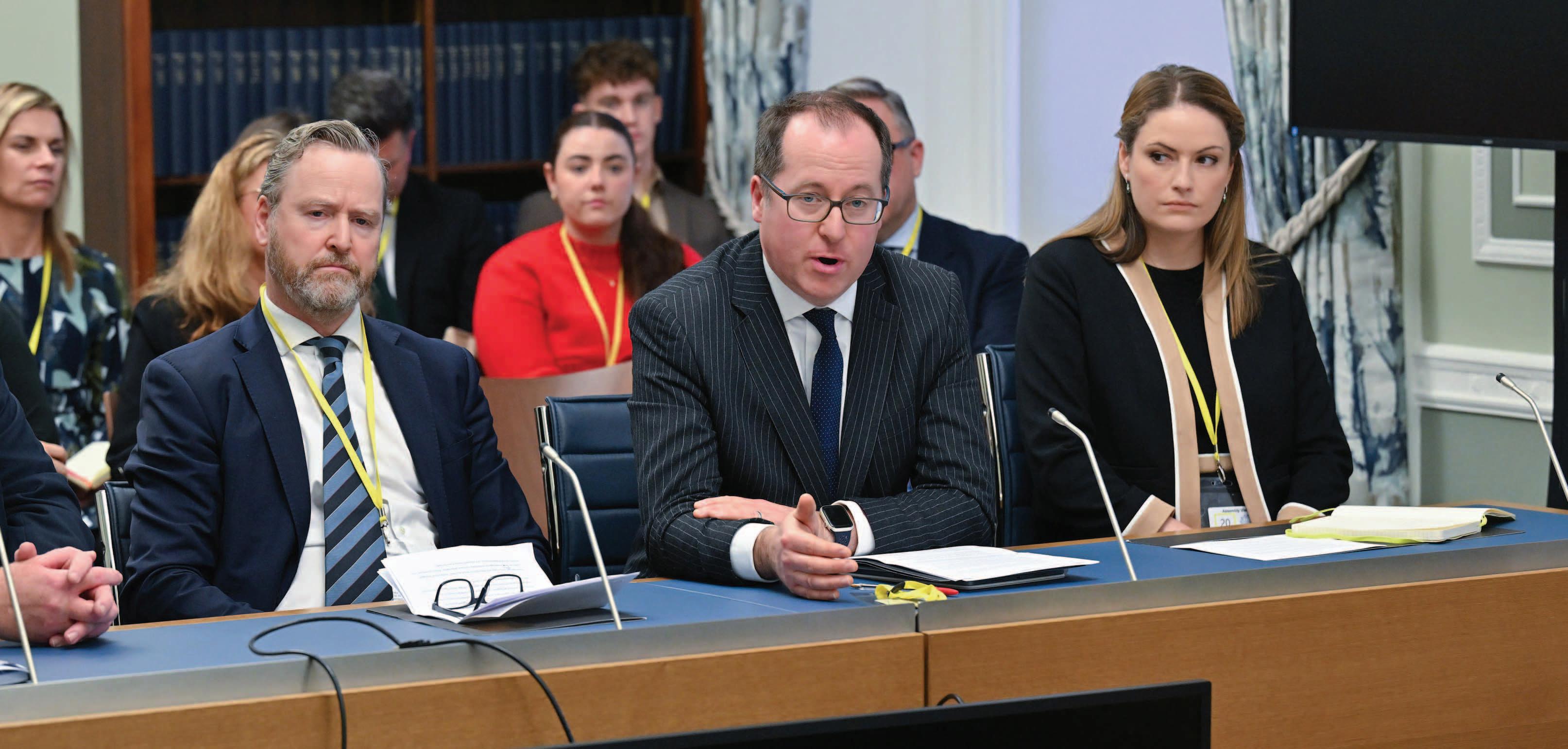
afford it. Legal aid is a vital demand led public service, just like health and education. It has been proven to have a beneficial social impact and, in addition, saves public expenditure in other areas and parts of government.
It is an irrefutable fact that justice has been underfunded historically, especially when it is compared to other Executive departments. Consistently over the last 10 years, the Department of Justice has been forced to manage from a meagre budget settlement, when compared with other departments.
From 2012/13 until 2022/23, the Justice Department’s overall expenditure has increased by just 3 per cent in cash terms; whilst education’s expenditure has increased by 32 per cent and health by 61 per cent in this same period. Furthermore, in terms of spend per head, justice is spending 2 per cent less in 2022/23 than it was in 2012/13, whilst education and health is spending 26 per cent and 54 per cent more, respectively.
Quite simply the state of our justice sector does not always rank highly in public consciousness, nor materialise as an influential issue for elected representatives when election years roll around. However, when people from all walks of life face serious life challenges such as relationship breakdown, housing crisis or personal injuries, or if they become victims of crime or are accused of a criminal offence, they expect and deserve effective and efficient access to justice.
Perhaps, the value of access to justice shines most brightly when we consider a world in its absence. We need only to look to our neighbouring jurisdictions to see the consequences of government policies which curtail access to justice. For example, the Legal Aid, Sentencing, and Punishment of Offenders Act (LASPO) came into effect in England and Wales in 2012 and its ramifications are still being felt by people attempting to access justice today.
LASPO cut large areas from legal aid, meaning that fewer people could access legal support, creating generational harm and displaced demand across communities. The number of civil legal aid providers in England and Wales dropped by more than 40 per cent in 10 years. In 2021, it was estimated that 3.6 million people in England and Wales had an unmet legal need each year.
Our policy and decision makers must learn the lessons of LASPO and avoid repeating the mistakes. As a post conflict society with stubbornly high levels of socio-economic deprivation and

“We are a long-standing advocate for an appropriately funded justice system and a positive, proud, and strategic vision for justice.”
chronic rates of mental ill health, we in Northern Ireland must recognise that appropriate investment in our justice system leads to better outcomes across departments and assists in building a more competitive economy, delivering sustainable and inclusive growth, and contributing to continued peace building.
The Bar of Northern Ireland dedicates much effort towards elevating the importance of access to justice as a critical component of social welfare, akin to health and education. We provided a detailed submission to that effect during the draft Programme for Government (PfG) consultation.
I am pleased that we are playing a key role in the recently formed All-Party Group on Access to Justice where we participate in policy development in collaboration with our solicitor colleagues and other justice focussed civic society organisations. Informed citizenry is crucial to better decision making across government.
There are many issues beside the future of publicly funded legal services that the Bar Council must not just grapple with,
but effect positive change on during my tenure as Chair. I want to advance efforts to promote a truly diverse Bar, reflective of the society we serve.
As Northern Ireland becomes more culturally diverse, so to must the barrister profession. We must also challenge policies and practices such as payment delay on the part of the Legal Services Agency, which disproportionately impact upon younger and female barristers and inhibits our efforts to retain talented practitioners and enhance socio-economic diversity.
Whilst there are many challenges ahead, the strength of the Bar lies in our collegiality, our independence, and our commitment to justice. If we remain faithful to those values, I am confident that the Bar of Northern Ireland will continue to serve the public by playing an important role in a stable, prosperous, and just society.
T: 028 9024 1523
W: www.barofni.com


Ian Snowden, Permanent Secretary of the Department for the Economy, discusses progress on the Minister’s prioritisation of achieving net zero as a key objective in his economic vision.

“As we accelerate towards net zero, protecting low-income and vulnerable consumers is key,”
Ian Snowden, Permanent Secretary, Department for the Economy
Setting the context for the significance of the work to decarbonise Northern Ireland’s economy in the coming years, the Department for the Economy’s Permanent Secretary says: “We are never going to have to make such a radical whole system change to the way we generate, store, distribute, buy, or deal with energy ever again”.
In February 2024, a fortnight after the Northern Ireland Executive resumed, Economy Minister Conor Murphy MLA outlined a new four-pillared economic mission, one of which was the decarbonisation of the economy to help reach net zero by 2050.
Snowden echoes the Minister’s rationale for this inclusion, stating that the economic opportunity in decarbonisation, if properly grasped, “will be nothing short of transformative for the health and prosperity of our citizens”. However, he is clear on the need for urgency to deliver our energy future.
Pointing out that, at the turn of the year, there will be just five years, or 60 months, to reach major 2030 targets – foundations for net zero by 2050 –the Permanent Secretary lays down a challenge to his own officials and wider energy stakeholders not to look back in the future and “rue our inaction”.
“With 60 months to go to 2030, we all need to collaborate with a real sense of urgency to help transition to a net zero future, and an energy economy based on renewables,” he states.
Outlining the ultimate ambition to stop the importation of fossil fuel, and instead pay a fair price for the fuels that are available indigenously “to satisfy all of our energy needs and more”, Snowden says that there is a need to accelerate investment to achieve affordable, renewable energy for Northern Ireland.
On how this can be achieved, he says that the public sector must show leadership in delivering the net zero pathway, and points to investment of over £70 million to date in invest-to-save solutions, designed to provide energy cost stability and a carbon footprint reduction across the public sector, as well as larger sums in further planned investment in this area over the course of the mandate.
Additionally, he outlines plans that will see the Department invest £20 million to support local businesses to reduce their energy bills and carbon emissions through Invest NI, in the same timeframe.
Offering a snapshot of the work underway to accelerate the journey to net zero for the energy industry and consumers, Snowden points to plans to change the Electricity Connection Policy Framework, to lower a barrier to renewables and other low-carbon technologies, following a review launched by the Utility Regulator and the Department in 2023.
Also recently published is an implementation plan for the installation of smart meters, as outlined in the Energy Strategy Action Plan 2023, while Snowden says that his Department is working through responses to a call for evidence around the development of biomethane production in Northern Ireland, which closed in August 2024.
Described by Snowden as a “fundamental necessity for achieving the 80 per cent by 2030 renewable electricity consumption target”, the Permanent Secretary says that following the publication of the high-level design, the Department is now developing the detail of the long-awaited Renewable Electricity Support Scheme, the first auction for which is scheduled for early 2026.


“To reach self-sufficiency in affordable renewables, we clearly cannot rely on our old energy solutions,” explains Snowden, outlining the need for system-wide reform if the decarbonisation policies essential to the Energy Strategy and Climate Change Act are to be delivered.
To ensure that government, stakeholders, net zero energy companies, and investors can play their part in the energy transition requires “a robust regulatory environment with fit for purpose modern legislation, enabling the reform”, Snowden states.
To this end, he points to the recently closed public consultation on the Utility Regulator (Support for Decarbonisation Preparation) Bill which, subject to ministerial and Executive agreement, he expects to be introduced to the Assembly in the coming months.
Highlighting the Minister’s intentions to progress legislation in a number of areas including offshore renewable energy decommissioning and a ban on onshore petroleum licensing, Snowden says that 2025 will be characterised by urgent work towards a new Energy Bill “to enable the pathway to decarbonisation, ultimately ending our reliance on important fossil fuels”.
While highlighting the need for urgency, Snowden is cognisant that the cost of delivering emission reductions must not fall disproportionately on vulnerable consumers.
Stressing the need for a just transition, he says: “This is a once in many generations opportunity to remove price volatility from energy costs and structure charges to ensure that we can work towards the eradication of fuel poverty and also ensure that our businesses are competitive.”
Pointing to the provision by the Department of £2.3 million of additional capital into the £8 million Northern Ireland Sustainable Energy Programme, aimed at supporting lower-income and vulnerable households, he adds that the Minister has prioritised the establishment of an all-of-government approach to the development and delivery of a plan to produce community benefit through a community energy pathfinder.
“As we accelerate towards net zero, protecting low-income and vulnerable consumers is key,” he says, adding: “The only way this can be achieved is through collaboration with communities, businesses, local government, statutory partners, and all of those who have an interest in creating an inclusive and equitable path towards a sustainable future.”
While acknowledging that Northern Ireland currently sits “many miles” behind Great Britain and the Republic of Ireland in the energy transition, Snowden is adamant that the gap can be closed.
“The Department is clear about the focus and that we are heading in the right direction,” he says optimistically, adding: “Decarbonising the Northern Ireland economy is at the heart of our work within the Department, and the Minister and I are happy to be challenged on the urgency with which we are delivering that.
“Sixty months is not a long time and there is a huge amount that we have to get done. We all have an important part to play. We must work together and we must work with a sense of urgency,” he concludes.

Antrim and Newtownabbey Borough Council has been awarded the title of Overall Council of the Year 2024 for Service Delivery at the prestigious APSE Awards. The Council was one of eight finalists from across the UK and the only council from Northern Ireland to be shortlisted for the award.

This is not just a first for this council, but for any council in Northern Ireland. The Council also won Best Services Team for its Bereavement and Cemetery Services and was named a finalist in five other categories.
At the awards ceremony, Mayor of Antrim and Newtownabbey Neil Kelly, expressed his pride in the Council's accomplishment, saying: “I am deeply honoured to receive these awards. Being named UK Council of the Year, in competition with over 300 county, city, and borough councils, highlights the dedication of our staff and the high standard of front-line services we deliver.”
The Mayor also acknowledged the hard work of council officers, whose efforts were instrumental in the Council’s recognition: “I want to commend our council officers for their innovation and determination, which are key to delivering effective frontline services, as recognised at these awards.”
He also extended his gratitude to the local community: “This award is shared with our residents, who motivate us to strive for excellence in everything we do.”
The APSE Service Awards celebrate outstanding achievements in public service delivery across the UK, with hundreds of submissions received each year from local authorities.
Antrim and Newtownabbey Borough Council’s win underscores its commitment to delivering high-quality services to its residents.
T. 0300 123 4568
E. info@antrimandnewtownabbey.gov.uk
W: www.antrimandnewtownabbey.gov.uk

NI Water hosted a round table discussion with key stakeholders from across the local economy to discuss the vital role of critical infrastructure in underpinning economic and environmental improvement ambitions.
What is the role of critical infrastructure in supporting the ambition to develop a globally competitive economy?
Sharon McClements
Infrastructure is fundamentally important to society. There is an obvious benefit, for example, of investing in health and social care infrastructure. Similarly, we can understand the socioeconomic and environmental damage when we do not invest in infrastructure, as exemplified by
the Lough Neagh crisis. Many young people appreciate that there must be greater investment in underpinning infrastructure so they can make their futures here in Northern Ireland.
Mark Spence
When we talk about a global economy, we can look at indigenous businesses which have grown and thrived in Northern Ireland, but we also need to have a nuanced discussion about foreign direct investment (FDI). Investors want guarantees that when their workers locate here, they have access to good
Round table discussion hosted by
infrastructure to underpin a good quality of life. Unfortunately, the region is beyond failing against that criterion and the reality is that investment is finding a welcoming home elsewhere. We must give confidence to the local indigenous market, and to FDI, that we can match their ambitions.
Tzvetelina Bogoina
From a public health perspective and an economic perspective, clean water and wastewater infrastructure is of paramount importance. NI Water wants to ensure that there is effective and sustainable water and wastewater infrastructure to support a thriving economy. We also acknowledge that the environment plays a crucial role for people deciding where they want to live and work. In recognition of this, we are investing in wastewater treatment works and pipe networks, ensuring that we protect the environment
from pollution and mitigate the potential effect where pollution may occur. We have a lot of great examples where investment in infrastructure has supported critical development in various sectors such as housing and manufacturing, but we should not forget that these investments cannot be seen as a one-off. We need sustained investment that addresses the challenges across the whole network.
Anita Conway
For anyone seeking to invest in Northern Ireland, it is essential that our infrastructure delivers reliable, effective, and affordable services for everyone. When we talk about infrastructure, we need to be conscious about our capacity to plan and build, and ensure that everything is built for, and in support of, innovation. With the emergence of new technologies, especially AI, there are ways in which we can make systems much more efficient, effective, and embolden infrastructure projects. However, we need to assess if what we are doing now enables us to build in the capacity for those technologies.
John French
Infrastructure is the foundation of everything we do. Unless you have the critical infrastructure in place, you cannot build houses, you cannot have functional hospitals, and the opportunity for more tourism cannot be grasped. As we move towards net zero targets, infrastructure is the cornerstone of everything that we need, and investment in infrastructure provides a boost and an uplift for the whole of society. Take the new Ulster University campus in Belfast, and the new Grand Central Station as examples, people are encouraged by these developments and they help encourage investment into Northern Ireland.
The draft Programme for Government recognises a historic underfunding of wastewater infrastructure and pledges to work to increase capacity, in what sectors can increased capacity serve as the biggest enabler?
Tzvetelina Bogoina
The largely ‘hidden’ nature of water and wastewater infrastructure means it is often taken for granted. Water and wastewater are critical to most, if not all economic sectors. Take housing, for example, housing development cannot



Tzvetelina Bogoina is Director of Infrastructure Delivery for NI Water. Prior to joining NI Water, she was Capital Programme Director in the Strategic Investment Board and has previously worked as Development Director at Balfour Beatty Investments. Bogoina has over 15 years’ experience across key commercial, governance, and financial aspects of developing major public infrastructure, regeneration, and property investment projects in UK and Europe.
Anita Conway has been Director of Development at Radius Housing since 2011. Prior to this she worked in the private construction sector as a commercial director working throughout Europe. Conway has extensive experience in residential, hospitality and commercial property development. Conway has a MSc in property development and investment from UUJ and a BA(Hons) in Housing from Hallam University, Sheffield.


John French has been Chief Executive of the Utility Regulator since November 2020. Prior to joining the Utility Regulator, he was Chief Executive of The Consumer Council and has held senior roles in firmus energy, NIE Networks, and at the UK Business Council for Sustainable Energy. French is a Chartered Director, Chartered Manager, and a Fellow of both the Institute of Directors and the Chartered Management Institute. He has a master’s degree in accountancy, and an honours degree in accountancy and business finance, both from the University of Dundee.
Sharon McClements is a senior lecturer in Ulster University’s school of Architecture and the built environment. A chartered quantity surveyor, she is an expert advisor to the Ministerial Advisory Group for Architecture and Built Environment, Senior fellow of the Higher Education Academy previous Chair of RICS Northern Ireland. She was awarded the Association of Project Managers ‘Herbert Walton - Excellence Award’ for her PhD thesis.

Mark Spence is the Chief Executive of the Construction Employers Federation, the certified representative body for Northern Ireland’s construction businesses. Spence is the Northern Ireland appointee to the UK Construction Leadership Council and is industry representative on the Northern Ireland Procurement Board.

“The modernisation and sustainable development of our infrastructure is critical our environment and economy.” Tzvetelina Bogoina
happen without sufficient capacity in our systems to safely take way the wastewater from the new homes. Yet, decades of historic underinvestment have resulted in wastewater assets not being modernised or delivered at the pace needed. As a result, despite overarching ambitions to grow the economy, industrial development is being curtailed. Simultaneously, economic growth is just one part of the challenge, we also must ensure that we have a region in which people want to live and visit. Having environmental sustainability and remaining a region of natural beauty requires underpinning infrastructure.
Mark Spence
The draft Programme for Government contains nine priorities, but we would argue that investment in underlying infrastructure should be the tenth, and most important priority. We are pleased to see that housing has been identified as a priority, but that sector can only be enabled if the infrastructure exists. Currently, there is a crisis of confidence in the construction sector around housebuilding and there are an estimated 37,000 homes that cannot be built because of a lack of connectivity to water infrastructure. Housing is a fundamental sector not just for the economy, but for societal health and wellbeing. We must
begin looking at our economic and societal ambitions through the prism of infrastructure.
John French
If we want our cities and towns to grow then we need to invest in wastewater and clean water systems to underpin that

growth. Modern society must provide clean drinking water, but it is important that historic underinvestment in the less visible wastewater infrastructure is recognised. As our population grows, as we build more houses, and as we try to attract more people to this region, there is a need to ensure that wastewater infrastructure keeps pace with this development.
Anita Conway
There is a clear interdependence between critical infrastructure and our economic future. If we cannot connect new homes, then where will the essential workforce live to ensure the economic future of or cities and towns? It could mean Northern Ireland becomes less attractive from a talent retention perspective. Similarly, growth will fail to reach more rural and small economic hubs as we endeavour to address regional economic imbalance. Environmental considerations are also critical. Our climate is changing, as evidenced by the increased frequency and intensity of local and global extreme weather events. We must build resilience into our infrastructure if we are to manage these events. Currently, we are retrospectively addressing this challenge at huge cost, but this approach is unsustainable.
Tzvetelina Bogoina
It is worth reiterating that no one in NI Water believes it is acceptable to refuse new connections and inhibit major

“There is a need for greater collaboration to maximise the money that does exist, including the regeneration and reutilisation of existing infrastructure.” Anita Conway
project development. In the absence of capacity, we work collaboratively with developers to design practical solutions that would enable projects where possible. However, once a system is at or beyond capacity it is already underperforming in environmental terms. The connection of greater load would mean greater environmental harm, and we cannot countenance that. The modernisation and sustainable development of our infrastructure is critical to our environment and economy.
Sharon McClements
The draft Programme for Government lacked substance, and I think it was a missed opportunity to be a programme of change for Northern Ireland. There is still a siloed mentality in the priorities of Executive departments and respective economic sectors. It cannot provoke competition for investment, rather it must determine how we can invest in the region as a whole.
Outline the challenges to increasing critical infrastructure? Is there a need for greater innovation beyond increased investment?
Anita Conway
Finance is the most significant challenge but we must consider the return on investment. Take wastewater as an example of critical infrastructure investment; the primary rationale for increased investment is to increase capacity. However, how is this investment being assessed for its secondary benefits? For example, constructing systems of sustainability whereby wastewater can be treated and reused to support manufacturing processes or our agricultural sector.
The reality is that if we were given £10 billion tomorrow morning we could not instantly solve every problem because we have not yet fully explored the intricacies and benefits of building critical infrastructure systems on a collaborative basis. There are barriers to progress beyond finance and we must ensure that when investment is available, we are utilising it in a smarter way, which will bring long-term benefits.
John French Northern Ireland is the most economically disadvantaged region of the UK. The average household has a

“We must begin looking at our economic and societal ambitions through the prism of infrastructure.” Mark Spence
discretionary spend which is half that of the UK equivalent, and the lowest income households have just £50 of discretionary spend per week after essential bills. The financial resilience of the consumer is low, but it is the consumer that will need to fund the huge level of investment needed. We need an honest debate with households, consumers, business, and society in general about what infrastructure we require and can afford.
Beyond the primary obstacle of securing adequate funding and involving stakeholders in honest conversations around what is affordable, there is also the challenge of meeting increasing legislative requirements. We are in a climate emergency and therefore the limited investment that we do have must be utilised in a way that simultaneously addresses these challenges. NI Water has been recognised for its innovation. Since establishment in 2007, we have closed a nearly 50 per cent efficiency gap with comparable neighbouring water companies down to within 5 per cent and continue to stretch the boundaries of what is possible. The creation of our Intelligent Operations Centre in the past

five years is a prime example of how we have combined collaborative working with advanced analytics and robotic processing tools to better understand our network, to take preventative action and ultimately, to improve outcomes for our customers. Similarly, our integrated catchment base approach, addressing flooding risk, pollution, and capacity constraints, embodied in the Living with Water Programme is an industry-leading exemplar being rolled out across the UK and Europe. NI Water recognises that doing the same thing will result in the same outcome and have demonstrated our desire to do things differently for better outcomes.
Sharon McClements
I think the greatest challenge is the absence of a ‘functioning’ Executive. What I mean by that is an Executive that works to deliver for the whole region and not specific areas. Funding is a challenge, but we need a different approach to how investment is prioritised. Climate is a good example of the need for a different approach. We are all accepting and comfortable with the need to invest in and increase renewables as we strive towards net zero but there is nowhere near the same focus
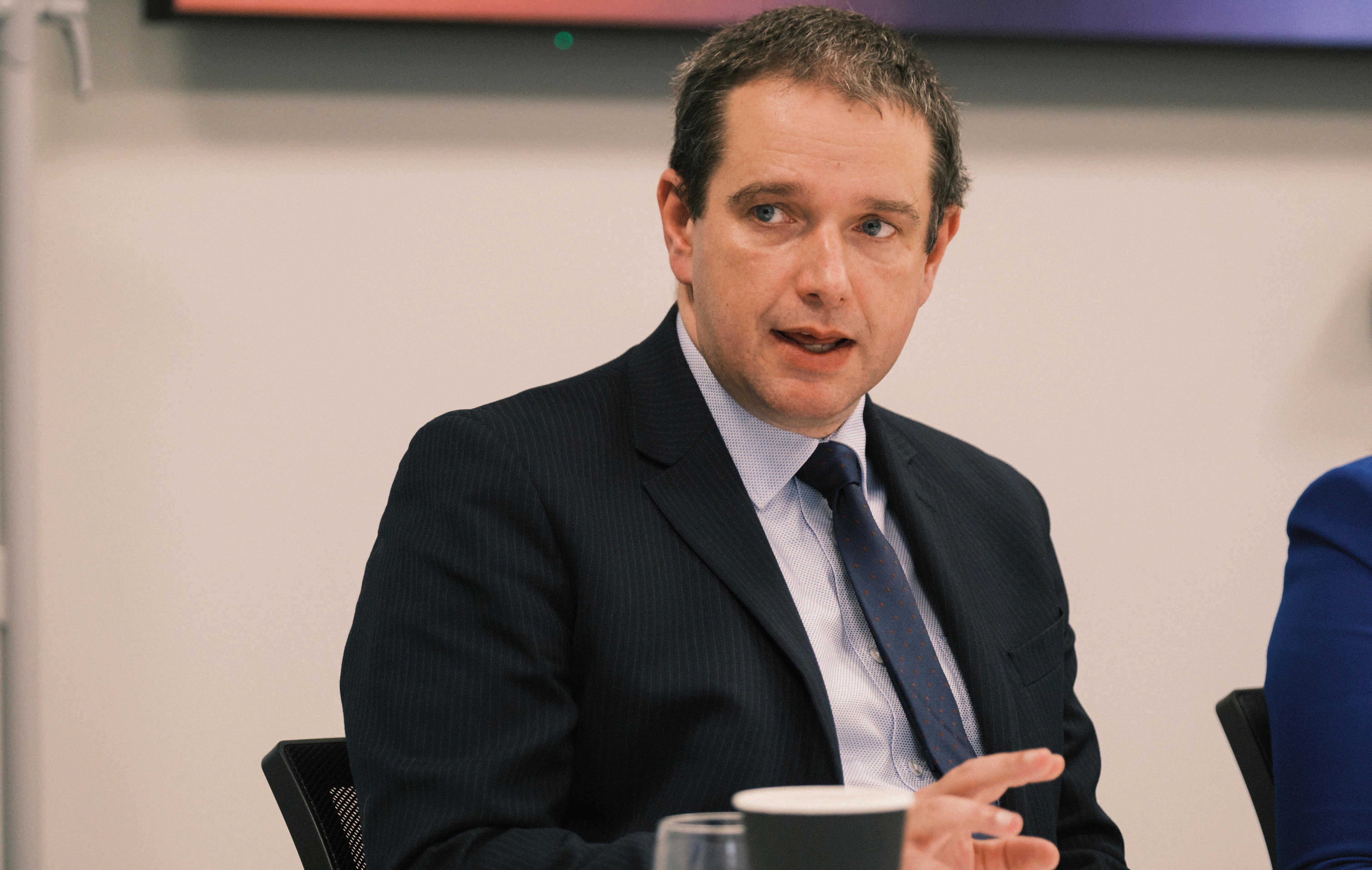
“The financial resilience of the consumer is low… We need an honest debate with households, consumers, business, and society in general about what infrastructure we require and can afford.” John French
on mitigating climate change. That is where we need innovative thinking and where we need to re-think where investment will land best to ensure the greatest outcomes for the whole region.
Mark Spence
If the draft Programme for Government is the aspiration, then the draft Investment Strategy is the expression. Our understanding is that the strategy will outline £26 billion of investment over the next 10 years. To the public that may present as a lot of money, but the reality is that it is little more per year than is currently being spent, which is vastly insufficient for our aspirations and our needs. I do worry sometimes that we as a society have become desensitised to our situation or that we collectively suffer from a short attention span of the critical investment challenges and therefore appear too accepting. There is a need for a fact-based conversation, acknowledging that we cannot fund everything, but recognising that to accept the status quo of current infrastructure spending levels would be disastrous.

I take some hope from the planned revitalisation of the Housing Executive, a mechanism that will allow it to raise capital. I see no reason why if the principles of that are acceptable to the Executive, why those principles could not be applied to NI Water. As a region, there are solutions available to alleviate funding constraints, but our politicians must be much more ambitious.
Anita Conway
A sustainability focus is important because it again comes back to breaking the cycle of near-term investment decisions. There are homes being built now which, in five to 10 years’ time, are going to need retrofitted to meet regulatory standards, and that retrospective cost will be multiples of what it would have cost had solutions been applied sooner. There is a similar theme across all critical infrastructure as we seek to improve capacity, the full life cycle costs are not being considered by those providing the funding. There is a need for greater collaboration to maximise the money that does exist, including the regeneration and reutilisation of existing infrastructure.
Tzvetelina Bogoina
Sustainable practices are vital, and across almost all industries there is a cognisance of how our collective operations impact on our environment. We cannot ignore that. We cannot just park sustainability for another time when there might be more money. Instead, we need to find more innovative and proactive ways to employ those solutions and ensure that the decisions being taken are being done with a whole life cycle approach. The way we collectively deliver our infrastructure projects must be

viewed through the prism of value for money, affordability, and sustainability.
Mark Spence
We often encounter clients who are, through necessity, having to operate on a ‘make do and mend’ approach, rather than taking a lifecycle approach to investment. It is frustrating to us as an industry because often we present better solutions, which are deemed as not representing value for money within the current annual budget context in which we are operating. In the housing sector, there are many developers who would like to make their sustainable homes a unique selling point, but the reality is that there is a postcode lottery on what developments can connect to critical infrastructure such as electricity and water. The result is a two-tier housebuilding environment whereby those who can afford it can avail of sustainable solutions. The pipeline of work of social and affordable homes is essentially being killed because of the costs associated with accessing capacity in our critical infrastructure.
Sharon McClements
Sustainability must be at the heart of infrastructure decision-making because if you are not building, designing, implementing, and managing infrastructure to meet needs today and tomorrow then it quickly becomes obsolete. It is important to point out that 85 per cent of our infrastructure for 2050 is already built, so we cannot simply apply the sustainability lens to new infrastructure. Other jurisdictions have successfully created one-stop-shop retrofitting solutions, where expertise and guidance are centralised. I would argue that the approach could be extended to all infrastructure here in Northern Ireland.
John French
The Northern Ireland Assembly and Executive have already set the destination in the form of the legislative targets included in the Climate Change Act. What we do not have is the route map to get to that destination in the most effective and efficient manner.
Tzvetelina Bogoina
We have a deliverable plan, which we work hard alongside the regulator to ensure, is in the best interest of the consumer and is the right thing to do. Our Price Control is not a wish list, it is what has been regulated as the minimum

“It is important to point out that 85 per cent of our infrastructure for 2050 is already built, so we cannot simply apply the sustainability lens to new infrastructure.” Sharon McClements
needed to serve the best interests of this region and its population. We know what we need to do, we know how we can do it, and we have the technical expertise and supply chains in place to deliver, however, the missing link is funding this in a sustainable way to support all of our ambitions for the best outcomes.
one priority action for delivering a globally competitive and sustainable economy.
Tzvetelina Bogoina
A sustainable funding model that provides ring-fenced, multiannual budgets to utility companies at the level determined by independent regulators, thereby enabling the necessary operational and infrastructure delivery.
Sharon McClements
I would advocate for a new funding model based on greater collaboration between the public and private sectors. From listening to what the new UK Government has said, we are entering a new era, moving towards a greater focus on PPPs.
Mark Spence
Speaking on behalf of our contractors, we need on-the-ground and practical cooperation with NI Water. At the moment, we have numerous contractors,

house builders, and developers who are telling us that their projects in Northern Ireland are nearly complete, and that they will cease operations here and take their work programmes to other jurisdictions. We need to give a lifeline to the contractors until we get sustainable funding.
Anita Conway
We need to equip our young people with the necessary skills so they know how they can make an impact on sustainability. Executive policy is now set to mandate young people to stay in education until they are 18, but there is little detail around how we can equip them with the digital skills they are going to require when entering the construction industry. As the workforce ages it is vital that we identify pathways for our future construction workers and consultants to see the opportunities in having a career in building our future.
John French
We need open and honest conversations. We know what the ambition is and yet we are still having siloed conversations. If we want regional economic development, then that must tie in with good infrastructure, and having those open conversations about what is affordable, and when.


In October 2024, Economy Minister Conor Murphy MLA launched a new plan to drive regional balance in the economy.
According to the Department for the Economy (DfE), economic disparities between regions in Northern Ireland have worsened amid systematic barriers and persistent problems.
Insisting that all communities should be facilitated in realising their potential, the Department has placed improved regional balance “at the heart of the economic vision”. Indeed, alongside increased productivity, more good jobs, and decarbonisation, regional balance is one of the four objectives of this vision.
In this context, as per the Place 10x actions for 2023/2024, the Department has developed a new economic plan “with measurable targets” to tackle sub-regional disparities.
Published by the Minister for the Economy, the Sub-Regional Economic Plan is a “new strategic approach to economic policy” which DfE says is
locally-led, supports collaboration, and has regional balance at its core.
Aimed at empowering local communities “to identify their own economic priorities”, the Sub-Regional Economic Plan contains three key elements:
1. creating local economic partnerships;
2. restructuring the economic development agency, Invest NI; and
3. adopting a new approach for DfE to mainstream regional balance, including via departmental restructuring and the creation of a new Regional Balance Unit.
In his foreword to the Sub-Regional Economic Plan document, Murphy notes: “Working in partnership with my department, the Invest NI Board and Chief Executive will oversee this profound change in its approach, with clear and ambitious targets agreed to monitor performance... In the spirit of true co-
design and collaboration, we can start to reverse historical imbalances and deliver prosperity throughout the region.”
The new approach, Murphy says, is underpinned by local economic partnerships – comprising central government, the business community, universities and colleges, local enterprise agencies, and civil society – identifying specific barriers to, and priorities for, economic development. Over three years, the Sub-Regional Economic Plan says that these partnerships will be allocated dedicated funding of £45 million.
“Partnerships will identify the main barriers to economic development and the priority interventions that will build the region’s value proposition,” he explains, adding:
“My department will recalibrate its programmes and budget to help meet these priorities.”

Meanwhile, staff numbers in Invest NI’s five regional offices in Ballymena, Craigavon, Derry, Newry, and Omagh will be boosted by “an initial 40 per cent” and will be tasked with managing “local clusters and businesses with a turnover of £2 million”. In support, Invest NI’s headquarters will provide specialist advice, reorientating the entire organisation towards balanced regional development.
Ultimately, this initiative aims to ensure that 65 per cent of Invest NI’s investments are allocated beyond the greater Belfast area.
Welcoming the plan’s publication, Invest NI CEO Kieran Donoghue reiterated: “We are committed to working in partnership with the Department for the Economy and other key stakeholders to support the achievement of the Minister’s policy priority of increased regional balance.”
Invest NI’s imminent three-year business strategy, the CEO reveals, incorporates regional development as a key objective and is set to provide additional detail on the organisation’s approach.
Speaking in the Assembly, the Minister highlighted: “58 per cent of the population is outside of the Greater Belfast area. Yet this area outside of Greater Belfast makes up 48 per cent of the economy, as measured by Gross Value Added. In order to help redress this imbalance, within three years 65 per cent of the agency’s investments should be outside of the Belfast Metropolitan Area.”
Furthermore, Murphy advised that the CEO had “informed me that reaching this target [of 65 per cent] would be challenging”, though his organisation was committed to doing “everything in their power to deliver”.
In his statement to the Assembly, the Minister describes his new strategic approach to economic development as “locally-led” and as placing “regional balance at its heart”. Contextualising the rationale informing the need for improved regional balance, he outlines the disparities which exist in employment, productivity, and living standards.
Explaining that DfE has never before development a coherent strategy for balanced economic developed, he references the Independent Review of Invest NI which found that decision-making was “centralised in Belfast” and that regional offices were “underutilised”, not integrated, and “too modestly resourced”.
Crediting the work of local government, he emphasises that councils “cannot be expected to transform local economies on their own” and that any substantive change in regional balance hinges on a “coherent ecosystem”.
SDLP economy spokesperson Sinéad McLaughlin MLA criticised the Economy Minister’s “failure” to support her proposal for legislation to place “binding obligations across government for regional economic balance”.
“Today was an opportunity for the Minister to set out his stall and give the Assembly confidence in his stewardship of our economy. While I welcome a focus on regional economic balance, productivity, and on the development of the all-island economy, today’s statement falls well short of what is required,” she said.
“Commitments have been made in previous visions, strategies, and plans laid before the Assembly and those commitments remain undelivered... The proof of today’s economic vision will be in the transformation of life outcomes for people, not just where they are already doing well, but in those most deprived areas that require intervention. Based on this statement today, I fear we are still relying on the same failed approach as before, with little accountability.”
On the other hand, Derry Chamber of Commerce President Greg McCann welcomed the plan as a “step in the right direction” towards “more bespoke economic action addressing regional balance”.
“The setting of concrete targets – such as 65 per cent of Invest NI investment being outside the Belfast Metropolitan Area within three years – will be further cause for confidence as it will give those of us invested in the delivery of regional balance a yardstick against which to measure our progress. We look forward to assisting in the implementation of the plan and seeing the North West continue to grow and reach its potential,” he said.
From now until the end of 2024, DfE and Invest NI have committed to continued engagement with local government and local stakeholders to “support the formation of the local economic partnerships” and codesign the funding allocation model.
Subsequently, between January and March 2025, the local economic partnerships will be tasked with proposing projects which align with the Economy Minister’s productivity, good jobs, emissions reduction, and regional balance priorities. These must be agreed by the end of the financial year, ensuring that funding can be drawn down from April 2025.
Between April 2025 and March 2028, DfE and Invest NI have committed to reviewing and approving proposed projects which will then be delivered via dedicated funding.
Acknowledging the ambitious nature of this timeframe, the Sub-Regional Economic Plan insists: “By working together in partnership, we can deliver tangible change at a local level.”


Since
1964 the Construction Industry Training Board NI (CITB NI) has been at the forefront of identifying the skills and training needs for Northern Ireland’s construction industry and shaping the sector’s growth and development, something which the organisation looks set to continue in the years ahead.
Currently CITB NI supports 3,600 registered construction employers by promoting and delivering training services identified by the industry. In 2023 alone, the organisation provided £2 million in training grants to a range of Northern
Ireland construction companies.
Alongside this CITB NI continues to showcase construction as a rewarding career option for young people and over the last eight years has supported 1,200 apprentices with apprenticeship grants.
Recent figures from the Construction Skills Network Labour Market Intelligence Report (2024 to 2028) for Northern Ireland forecast a 2.8 per cent annual growth in construction, with an additional 5,200 workers needed by 2028 to meet
industry demand. CITB NI aims to meet this need by supporting key training initiatives and encouraging the continued development of a skilled workforce capable of meeting the evolving demands of the industry. All these initiatives are designed specifically to upskill the workforce, promote diversity, and inspire the next generation of professionals to build rewarding careers in construction. The 60th anniversary year is also an opportunity to highlight recent successes. These include:
• the Mobile Training Unit facility which has trained over 2,000 individuals in health and safety courses throughout 2024;
• the Adopt A School initiative, which establishes local partnerships between education and industry, and that is currently working with 50 employers and 86 schools; and
• the recent development of the simulated construction training facility at CITB NI’s Nutts Corner site, where it has operated since 1964, and which offers a practical real-life training environment to prepare individuals for the demands of the construction industry.
Additionally, the Women in Construction Summit, identified by the CITB NI-led women in construction network as a need to encourage more women into the industry, held its third summit in 2024. Welcoming over 160 delegates, the summit explored and debated a range of key industry topics including digital technologies and the impact of artificial intelligence (AI).
Building on their partnership approach, CITB NI is working with the Department for Communities Historic Environment Division, to deliver a new heritage project which will not only preserve, develop, and deliver heritage skills supply and training in Northern Ireland but will seek to unlock the potential of developing future jobs and employment in the construction sector. This partnership will also help raise awareness of our built heritage, the heritage skills required and promote the preservation and development of traditional crafts and skills.
A collaborative industry-driven approach is at the heart of CITB NI’s strategy for developing training and skills solutions. This entails not only exploring and supporting growth opportunities but facing ongoing emerging challenges including an ageing workforce; declining

numbers of new talent entering the industry; technological advances in IT; the drive for energy efficiency; and a net-zero carbon society. Over the years, CITB NI has worked with industry leaders such as GRAHAM, Heron Bros and John McQuillan Contracts – to name but a few. This approach has helped to develop a collective future-focused learning strategy which concentrates on tackling these challenges, with the interests of both small and large organisations at its core.
One of the many local construction companies which has benefited from working with CITB NI is leading civil engineering and road surfacing company John McQuillan Contracts. Paul Brogan Managing Director, McQuillan Companies says: “Congratulations to CITB NI in reaching the remarkable milestone of its 60th Anniversary. CITB NI’s unwavering commitment to the continual development of well-trained individuals, both technically and from a safety perspective within the construction industry has been invaluable to McQuillan Companies.
“We plan to develop the sustainable growth of our business for the future in the drive towards a carbon-zero industry and look forward to working with CITB NI and others to help achieve this.”
Celebrating CITB NI’s 60th anniversary
Barry Neilson OBE, Chief Executive CITB NI says: “On behalf of the team at CITB NI we thank everyone who has been on
this journey with us over the years. We are delighted to mark our 60th anniversary year – it is quite an achievement. We are proud to continue to support the development of our most valuable resource – our people. As we reflect back on our key successes, we also are all too aware of the future demands on our industry, and training and development has never been as important.”
Neilson adds: “Key areas for future development in 2024 and beyond include digital construction and new technologies, sustainability and zero carbon, governmental direction and a review of training interventions to support the industry in the most efficient and effective way possible. Upskilling our existing workforce while developing new entrants equipped with the skills for both the known and unknown challenges ahead will be key and will play a central role of our future approach.”
For further information on CITB NI and its services visit https://www.citbni.org.uk or follow CITB NI on Facebook, X, Instagram and LinkedIn #CITBNI60



The UK Government’s Autumn Statement, which it states aims to “fix the foundations and deliver change for Northern Ireland”, has increased funding for the Executive, but challenges abound as local spending needs continue to not be met.
The latest UK Budget, described by British Chancellor of the Exchequer Rachel Reeves MP as a plan to “stabilise public finances and promote growth,” has significant implications for the local economy, public services, and living standards.
With a record allocation of £18.2 billion for 2025/26 – an increase of £760 million – this Budget can be described as a lifeline for Northern Ireland amid fiscal pressures, but it also comes with strategic choices that local policymakers must navigate.
The UK Government frames the Budget as a pathway to stability, highlighting that the most recent allocation is the largest real-terms increase for Northern Ireland since the Good Friday Agreement. The Chancellor emphasises that these funds aim to “unlock growth and support public
service stability,” suggesting that regional investment, such as city and growth deals, will help stimulate local economies and ease public service burdens.
While the boost in funding is broadly welcomed by Finance Minister Caoimhe Archibald MLA, Northern Ireland’s public spending needs are still not being fully met. With higher public service demand and generally worse service outcomes than England, particularly in healthcare, economic experts and local politicians alike continue to argue that the Barnett formula falls short of addressing the region’s unique needs.
While Archibald has expressed appreciation for the UK Government’s additional support, she remains critical of the overall funding model, further outlining her party’s assessment that the Barnett Formula, which calculates
funding for devolved governments based on changes in England’s public spending, is insufficient for Northern Ireland’s specific challenges.
Northern Ireland faces elevated demand for public services, stemming from higher levels of poverty and poorer health outcomes relative to other parts of the UK. “While the additional funding is welcome, it still falls short of the pressures facing departments,” Archibald states, noting that local departments must continue to manage within tight budgets.
This limited funding will force the Executive to make difficult choices. For example, health receives the largest allocation – 51 per cent – out of the devolved departments, with the Budget

allocation £350 million to address immediate demands, but this will only partially offset the severe strain on Health and Social Care (HSC) trusts.
For instance, compared to England, the local health service faces longer wait times for surgeries and specialist consultations. Currently, around 25 per cent of patients in Northern Ireland wait over one year for a consultant-led outpatient appointment, while in England, this figure is closer to 4 per cent. As a result, health outcomes lag behind, with fewer resources and slower service response times.
Politicians, including Archibald and former Alliance deputy leader Stephen Farry MP, and economic experts such as David Heald from the Institute for Fiscal Studies (IFS) have argued that such onetime allocations fail to address the structural funding deficits facing the region.
Public services, such as education and infrastructure, also suffer due to resource shortages. The education sector receives £170 million, but rising costs and increased demand mean that schools must make budgetary compromises, potentially impacting quality of education. In addition, infrastructure funding, although partly supported through targeted investments like the £39.6 million for wastewater infrastructure, remains limited.
Archibald reaffirms that “overspending is not an option”, given Northern Ireland’s strict budget rules and past overspending penalties, making it clear that Executive departments face a significant challenge in balancing quality service delivery with fiscal discipline.
The effectiveness of the Barnett Formula in serving Northern Ireland’s unique socioeconomic landscape has long been a topic of debate, with former Alliance Party deputy leader Stephen Farry arguing in agendaNi in January 2024 that there is a need for a fiscal floor of 127 per cent in Northern Ireland, compared to the rest of the UK.

• £760 million of targeted funding for the Northern Ireland Executive, of which:
• £662 million in the 2024 restoration financial package
• £90 million for capital investment
• ‘Mid South West’ and Causeway Coast and Glens deals deliver a combined investment from UK Government of £162 million over 15 years
• £45.8 million funding increase to the PSNI:
• £37.8 million for the Additional Security Fund
• £8 million for the Executive Programme on Paramilitarism and Organised Crime
• £730,000 of additional funding in 2025/26 for transition of schools towards integrated status
“A fiscal floor for Northern Ireland would ensure we are fairly funded in relation to our specific level of relative social and economic need, and funding could not fall below that level,” Farry writes.
Heald argues that the formula’s lack of consideration for regional disparities results in chronic underfunding. The IFS has noted that Northern Ireland’s health and social needs are high and rising, largely due to a more rapidly ageing population and higher rates of chronic illness.
Without adjustments to the formula, Heald states that Northern Ireland may struggle to achieve the standard of public service outcomes seen in England and Scotland, as higher demand places an increasing strain on limited resources.
Despite these funding challenges, the commitment of £162 million over the next 15 years for city and growth deals, which aim to stimulate economic development in underinvested areas, like the ‘Mid South West’ region and Causeway Coast and Glens, will be welcomed by members of the Executive.
Additionally, the Enhanced Investment Zone initiative aims to attract investment in key sectors such as clean energy and digital infrastructure, with the goal of
creating high-quality jobs and improving long-term economic resilience.
While these investments can catalyse local development, they are insufficient for solving the immediate, structural pressures on Northern Ireland’s public services. The combination of economic growth policies with insufficient core funding for public services may deliver uneven results, with some areas seeing long-term benefits while public services continue to lag.
Overall, while the funding increase is a step forward, it underscores Northern Ireland’s ongoing reliance on a funding model that economic experts and politicians alike view as inadequate.
Archibald and public finance experts advocate for a comprehensive review of Northern Ireland’s fiscal needs, suggesting that the Barnett formula should be replaced with a needs-based funding model that reflects regional challenges.
While the Budget’s record funding does provide a sticking plaster to the Executive’s broad financial challenges, achieving parity in public service outcomes with the rest of the UK and the Republic will require a shift toward a more responsive funding approach that genuinely accounts for Northern Ireland’s public service needs and economic aspirations.

Northern Ireland faces a looming crisis in its justice system that demands urgent attention. The inadequacies in legal aid funding threaten to undermine the principles of fairness, equality, and access to justice that are vital to any democratic society.
As we observe the ongoing challenges faced by the legal sector, it becomes increasingly clear that Northern Ireland is sleepwalking into a justice crisis, one that could have profound and lasting implications for its citizens and the legal profession, writes Patricia O’Lynn, Head of Policy and Engagement at The Law Society of Northern Ireland.
Legal aid serves as the bedrock of access to justice, providing essential support to individuals who cannot afford legal representation. It ensures that everyone who meets eligibility can seek legal representation and defend their rights. Legal aid is particularly important given that it provides a mechanism by which the most vulnerable can access
good quality representation and secure a fair hearing of their case. Legal aid also plays a key role in creating a robust justice system. It is one of the pillars of the welfare state and is essential to ensuring public confidence in the administration of justice.
Solicitors play a key role in the administration of justice – yet the
importance of the profession is often misunderstood. In addition to providing legal representation and advice to clients, solicitors are an essential part of the local community. Solicitors are the first point of contact for an individual seeking access to justice. They are of critical importance in delivering public benefit, not just in terms of legal advice but also in terms of ensuring equitable access to high quality public services, preservation of the rule of law as well as upholding a central pillar of our democratic system – that justice must be accessible to every citizen, not just the preserve of the privileged few.
From an economic standpoint, the solicitor profession makes a significant contribution to the economy. Work undertaken by legal practitioners through traditional solicitor firms or in corporate legal departments accounts for around 63 per cent of all Northern Ireland’s legal sector activity and was valued at around £460 million in 2019. Solicitor firms are significant employers, not just of legal talent and secretarial staff but also of administrators, finance, and procurement specialists.
Given that solicitors are the lifeblood of the justice system, it is deeply concerning that the sustainability of the solicitor supplier base is now under threat. Years of underfunding coupled with eligibility thresholds remaining unchanged and widespread inefficiencies in the justice system, have forced some solicitors to stop offering legal aid services.
The severity of the situation is encapsulated by the fact that legal aid fees for solicitors have remained unchanged since the 1990s, meaning they are worth a fraction of what they were when they were originally introduced. A survey of legal aid practitioners revealed that between 15 per cent to 35 per cent of time spent on any case would be unremunerated.1
Increased demands on the profession coupled with significant aspects of legal aid work being unremunerated makes the viability of legal aid work increasingly untenable. Most solicitor firms in Northern Ireland are small businesses consisting of four solicitors or fewer. In order to survive, small firms need to be profitable, yet rises in inflation, the cost of living crisis, and the substantial increased cost of doing business mean profitability has been eroded. This is an untenable situation for any business and is resulting in legal aid service providers withdrawing from the market.
Access to legal representation is already becoming scarcer as the number of firms in rural parts of Northern Ireland is dwindling.2 For instance, of the 16 firms currently practising in County Fermanagh, two have already ceased to provide legal aid services in recent years. Rural areas are at risk of becoming access to justice deserts. Ultimately, victims and witnesses will pay the price. The challenges presented by inefficiencies in the system and a lack of profitability make general practice less attractive to newly qualified practitioners. This further widens the gap in the solicitor supplier base meaning there is a lack of professionals available to replace an already ageing population of practitioners.
For many solicitors, their work is driven by a deep sense of responsibility to their communities. Numerous professionals in this field express a genuine love for their role, seeing their work as a form of public service. In fact, for many solicitors, the desire to make a positive difference in the lives of others is a motivating factor that supersedes the financial rewards. It is not uncommon for legal aid practitioners to speak of their commitment as fulfilling a societal obligation rather than simply providing a service for hire.
The perception of ‘fat cat’ lawyers is a myth that needs to be debunked. In reality, many solicitors working in legal aid earn modest fees, and the money received rarely covers the full cost of the work involved. Recent events, including strikes and protests by legal professionals, highlight the pressing issues within the sector. These disruptions were framed as ‘premature action’ by the Justice Minister, Naomi Long MLA.3
However, this overlooks the longstanding systemic issues that have been festering within the legal aid system. Equally, the inadequacy of the budget

“Given that solicitors are the lifeblood of the justice system, it is deeply concerning that the sustainability of the solicitor supplier base is now under threat.”
within the Legal Services Agency (LSA) has had negative effects on the profession, as a policy of payment delays to practitioners has manifested a way of managing their budget. It can take between 12 and 16 weeks to pay practitioners for completed work, whilst all other suppliers are typically paid by the LSA within 30 days. The continuing impact of this policy has culminated in judicial proceedings where the Law Society, in conjunction with the Bar Council, have challenged this departmental policy in order to secure prompt payment of legal professionals.
Despite these challenges, the social value of legal aid cannot be overstated. In a recent ground-breaking study commissioned by the Law Society of Northern Ireland the social return on investment of legal aid in the region was quantified for the first time.4 This research shows that every £1 invested in legal aid generates £8.32 in social value.5 Thus, the interconnectedness of legal aid with the broader public sector cannot be overlooked.
This research illustrates clearly that investment in the system not only supports individuals in need, but also alleviates pressure on other public services such as health and social care, reducing costs for the broader public sector.
By ensuring that people have access to good quality legal representation, legal aid helps prevent issues from escalating into more costly and complex problems, such as homelessness, family breakdown, mental health crises, and prolonged legal battles.
The evidence makes clear that the continuation of a properly funded legal aid system is not just a necessity for those who need legal representation – it is essential for the health of the entire justice system and the welfare of society at large. It also serves as a reminder of the urgent need for a sustainable legal aid system.
T: 028 9023 1614 W: www.lawsoc-ni.org


Urgent and significant improvement is required if Northern Ireland is to ensure it has the skills needed to achieve its economic ambitions, a report by the Northern Ireland Audit Office (NIAO) has asserted.
The report entitled Developing the skills for Northern Ireland’s future, published in September 2024, shows that support for skills and learning is the largest area of spending for the Department for Economy (DfE), with approximately £470 million spent in 2023/24, funding a range of initiatives and programmes. Since 2019, the DfE has spent over £2.3 billion on various education and career programmes, but figures in the report show that spending for some initiatives has receded in recent years, with the overall funding having decreased by 7 per cent.
Between 2019 and 2020, over £145 million was spent by the DfE on the Higher Education Division (HE). The spending for HE reached a peak of over £157 million but has dropped to under £144 million, a record low in the last five
years. Moreover, spending in apprenticeships has also seen a cut. Between 2019 to 2020, apprenticeships received over £25.5 million, receiving a peak spending figure of over £38 million between 2021 and 2022. Like HE, the spending dipped for apprenticeships, which was allocated just under £35 billion 2023/24 financial year.
The reduction in funding in the last three years has already seen a considerable impact on the workforce. The 2022 Employer Skills Survey found that of an estimated 39,500 job vacancies, 35 per cent were attributable to a lack of skills, experience or qualifications amongst applicants. Nearly all employers (96 per cent) reported that these skills-shortage vacancies were having a detrimental effect on their business performance, and a significant proportion of employers

(over 40 per cent) considered that the effects of skills-shortage vacancies were causing delays in developing new products or services, a loss of business to competitors, or withdrawals from offering certain products or services altogether.
The DfE has set out a vision with its Skills Strategy for Northern Ireland: Skills for a 10X Economy. This skills strategy identifies three new goals which include:
1 Increasing the proportion of Northern Ireland higher education graduates with degrees in narrow STEM subjects to 27 per cent by 2030 (from a baseline of 24 per cent). Narrow STEM subject degrees included physical and biological sciences, mathematical and computer science, engineering and technology.
2 Increasing the proportion of the working age population with Level 2 and above qualifications to between 85 and 90 per cent by 2030 (from a baseline of 76.3 per cent).
3 Increasing the proportion of the working age population with Level 3 and above qualifications to between 70 and 75 per cent by 2030 (from a baseline of 56 per cent).
The skills strategy aims to drive economic growth, and to establish a skills framework that addresses the key challenges which have constrained Northern Ireland’s economic and social development such as:
• the prevalence of individuals with low, or no qualifications;
• limited opportunities for high paying jobs and pathways for career progression; and
• a ‘skills deficit’ and comparatively poor productivity performance.
However, there have been criticisms levelled at the DfE that while the skills strategy has individually positive outcomes and evaluations, the latest monitoring data show a lack of progress towards achieving the strategic goals of the Department’s Skill Strategy:
• The most recent data show the proportion of the working age people with qualifications of at least Level 2 or Level 3 has decreased since the prior year.
• There was no progress against the strategic goal to increase the proportion of individuals graduating with degrees in narrow STEM subjects.
• The adult participation rate in education or training has decreased.
Moreover, the Institute of Directors recently reported that its members continue to be “frustrated by the weak and disjointed skills and education system that hampers plans for business growth”.
The majority of stakeholders that engaged with NIAO during the review did not agree that there is clarity on the roles and responsibilities across government for developing skills in Northern Ireland, and most disagreed that there is a coherent approach to the policies, initiatives, and interventions for developing skills to address identified skills need.
The report states that the “DfE must review, streamline and clarify the governance and oversight arrangements for skills in Northern Ireland and ensure that the skills system can be more easily navigated by stakeholders”.
Furthermore, since 2015, the Ulster University Economic Policy Centre (UUEPC) has prepared the Skills Barometer under the direction of the DfE. The Skills Barometer, published biennially, forecasts labour market demand for skills and skills supply, and combines them to identify projected skills imbalances in areas of undersupply and oversupply by qualification level. As well as modelling qualification-level supply and demand, the Skills Barometer also considers the field of study and industry sector needs. The 2019 iteration of the Skills Barometer was a primary evidence base used in the development of the Skills Strategy.
However, the most recent iteration the Skills Barometer, published in March 2022, forecasts that between 2020 to 2030, there will be annual undersupply of new workers with qualifications at Level 3, Level 4-5 and level 6 and above, and average annual oversupply of new workers with qualifications at levels 2 and below.
The 2021 Skills Barometer also forecasted undersupply in 2020 to 2030 across most subject areas at degree level (Level 6 and above) with undersupply most prominent in the STEM subjects and undersupply across all subject areas at Level 45.
Comptroller and Auditor General Dorinnia Carville, who authored the report, states: “Skills shortages are having a detrimental impact on business and economic growth in Northern Ireland.
“Despite the range of support provided by the Department, little demonstrable progress has been made. This will only make it more challenging for the Department to achieve the ambitions set out in its Skills Strategy.”
Carville calls on the DfE to provide “clarity” on how they will deliver on the Skills Strategy and emphasises the need for “demonstratable success” in delivering the strategy at the five-year review point.

At a time of profound change for the sector, with local, national and international decarbonisation targets posing new challenges and opportunities, the Utility Regulator has welcomed its new board chair.
At the forefront of protecting Northern Ireland’s consumers of electricity, gas and water on the journey to net zero is the Utility Regulator. The economic regulator is the nonministerial government body that regulates the supply, cost and quality of utilities in Northern Ireland.
Appointed by the Department of Finance in September 2024, Rosamund Blomfield-Smith takes on a seven-year appointment, marking the start of a new era for the regulator, and a new challenge for the chair herself.
Blomfield-Smith brings with her a wealth of experience in both utilities and regulation, earned throughout an illustrious career in Great Britain. An early career in merchant banking led to her appointment in 1995 as Director and Head of Utilities in Rothschild & Sons’ corporate finance department.
Subsequent appointments included roles with some of the most prestigious names in investment banking, such as Morgan Grenfell & Co and Schroder Group.
In these roles, Blomfield-Smith recalls how she advised governments and companies worldwide on all aspects of utilities financing and regulation.
“I was responsible for advising on, and putting in place, economic regulatory regimes necessary to deal with monopoly private sector suppliers of utilities. As both my career and the industry itself progressed, I developed an expertise in corporate finance relating to renewable power projects,” she explains.
This expertise led to a succession of board appointments across the utilities sector and in regulation. Ranging from non-executive positions at Ofcom and Ofgem, “central involvement” in developing and implementing the framework for the landmark Thames Tideway Tunnel project, non-executive director roles at Natural England and the predecessor body to the Environment Agency, the National Rivers Authority, Blomfield-Smith is well-versed in the range of issues that make up the Utility Regulator’s work.
“The board chair position at the Utility Regulator plays to almost everything I have done over decades. When I saw the role, I felt that, to quite an unusual extent, I had relevant experience and expertise to offer,” she says.
Now in her second month as Chair, Blomfield-Smith reflects on her initial surprise at the high quality of energy and water regulation in Northern Ireland, which she feels compares favourably to elsewhere.
“It has been evident to me that the Utility Regulator is a well-run organisation which is operating to a very high standard, and this has not, in my experience, invariably been the case elsewhere. I think it is fair to say that there are respects in which regulatory standards in Northern Ireland are higher than in many other places.”
In its latest Corporate Strategy, launched in April 2024, the Utility Regulator is clear
“The board chair position at the Utility Regulator plays to almost everything I have done over decades.”
on its commitment to supporting a just transition to net zero and enabling best in class energy and water companies, for the benefit of Northern Ireland’s consumers. Blomfield-Smith is committed to bringing this to life during her term.
“My primary ambition is to lead a regulatory regime which continues to take its place with the best and which helps all three sectors – gas, electricity and water – deal with the challenges of climate change, and the requirement to reduce carbon emissions.”
On the drive towards net zero, she reflects on the progress she has witnessed so far, and that which lies ahead as she takes on her new role: “I was first involved in renewable generation in the early 2000s, when there were just a handful of tiny wind turbines in England. It is amazing how much that has changed, and amazing how much more change is afoot as we push on to meet our renewables targets.”
This experience has formed in BlomfieldSmith an unequivocal belief that high quality utilities regulation is of critical importance to economic growth.
Reflecting on the expertise gained during her time in finance, economic regulation and utilities, she is clear that the Utility Regulator has a vital role to play in ensuring high-quality regulation of an economically essential sector.
“Utilities are a fundamental part of economic growth and economic activity; they are absolutely central to economic wellbeing. This is one of the primary reasons that I want there to be top quality utilities in Northern Ireland – because that will drive the economy and drive wealth
creation. A successful economy depends on successful utilities.”
As the Utility Regulator strives to deliver against its ambitious corporate strategy, including its commitment to enabling best-in-class utilities companies for Northern Ireland’s consumers, Rosamund Blomfield-Smith brings with her an intricate understanding of regulation and high ambitions not just for the regulator, but for Northern Ireland.
Her aim is to deliver a leadership that allows the Utility Regulator to continue work that she describes as “already up there with the best”, and to see both the regulator’s work and Northern Ireland’s renewables expertise recognised in Europe and beyond.
“I am still new, but it is already clear to me that we have standards and ways of doing things which we can and should be boasting about outside Northern Ireland,” she says.
“On issues where the Utility Regulator is at the forefront, I am very keen that this is recognised. Northern Ireland’s regulatory standards are something to be proud of.”
Rosamund Blomfield-Smith was appointed chair of the Board of the Northern Ireland Authority for Utility Regulation on 1 October 2024. She will serve a seven-year term.
T: +44 (0) 28 9031 1575
E: info@uregni.gov.uk
W: www.uregni.gov.uk


Claire Hanna MP: ‘Building something new’

David Whelan about her plans to “freshen up” and “clarify” the party’s offering, her outlook on opposition, and her vision for a new Ireland.

“As a party we need to change how we do things, but not why we do things,” Hanna, the seventh and newest leader of the SDLP, told the gathering of party members at conference in early October 2024, immediately after being ratified to take up post from fellow MP Colum Eastwood.
“We will show people that what they have now is not as good as it gets, and that we are the party who will build something new,” she pledged, imploring herself and fellow party activists to “move up a gear” in efforts to grow the party.
Sat in her constituency office off the Ormeau Road, south Belfast, less than two weeks since delivering her speech and formally taking up the role of leader, the Belfast South and Mid Down MP outlines how she has sought to put her words into practice, having held meetings with the party’s eight MLAs and case workers across all 10 of the SDLP’s constituency offices in the North.
Hanna’s energetic and passionate approach to politics has seen her build a popular personal vote (she took 49 per cent of the Belfast South and Mid Down vote in the July 2024 Westminster election) which sits in contrast to party’s steady electoral decline over the past decade – a central reason to why Hanna’s nomination was unopposed and widely supported.
Hanna is steeped in SDLP pedigree. Her father is a former SDLP General Secretary while her mother was the first northern-born woman ever to serve in ministerial office in Northern Ireland. In this context, added to her own political rise from Belfast City councillor to MLA and then MP, ascension to leader now seems like the natural order for the Galway-born Hanna – an assertion she contests.
“I am a team player, and I enjoy the work that I do, so I have never been about racing ahead to the next thing,” she explains. “Leadership of the party was not something I was hankering for, but I was aware that it is an exhausting job and not something Colum [Eastwood] was going to want to do forever.”
“I am honoured to be taking on this job and leading this brilliant team,” she states.
Interestingly, Hanna does not come equipped with a radical plan to reform the party. This is in spite of successive bruising election cycles, which culminated in the SDLP’s failure to qualify for an Executive portfolio in 2022 and was compounded by falling behind the Alliance Party
in local council representation in May 2023. Instead, she takes heart from the attendance at the party’s 2024 conference and points to a need to “grow the membership base, get more activists, and reanimate the party in some of the communities where we have not been active enough”.
“We had youth, vitality, and diversity in all of its forms in that room and it reminded me that most of us in that room were there because we believe very strongly in something. We believe that politics is not a soap opera or about selfenrichment. It’s about public service,” she says.
Outlining her belief that the concepts and values of the SDLP still resonate with a lot of people, and indicating her belief that the party has suffered electorally because other parties have successfully appropriated those values, she adds: “We need to connect our values to people and their lives and to demonstrate to them that the things we are doing.”
Hanna indicates that the context of “hopefully a period of stability and delivery”, with the next election some two years off, a functioning Northern Ireland Assembly and a “relatively benign” UK Government presents an opportunity to “get stuff done”. Asked to elaborate on what that looks like, she says: “It is about putting a bit more strategy on the things that we are trying to achieve in the Assembly, in Westminster, and in Dublin. I am committed to and compelled by the new Ireland conversation, and I want to freshen up, clarify the SDLP’s offering in parliaments, in councils, and in Dublin as well.”
If successful, growth of its elected members in the Assembly would give the SDLP an interesting conundrum of qualifying for an Executive – which it believes has lacked the ambition to seize the opportunities that exist for the region – or remaining in opposition.
Hanna is not coy in her assessment that the party’s current position is a result of a failure to adequately connect to enough voters but believes that in opposition, the SDLP are afforded the opportunity to effectively scrutinise government, while acting as a voice for stakeholders in the public and private sector.
Asked if regaining an Executive portfolio was an ambition, Hanna says: “Let’s see. Most people enter politics because they want to change people’s lives. Very often the way of doing that is


through the Executive but I do not think that has been the case in recent years. I do not think the Executive is maximising the opportunities that exist to improve this region.
“At the moment, we have the important and vital job of stress testing the Executive’s ideas and challenging the outcomes as opposition. If we do that effectively, and we grow our team, then we will think about what the possibilities are after the next election.”
Asked if she would consider leading the party from Stormont, Hanna says that such a move is not on the horizon. “I am trying to lead a movement that is going to deliver a new Ireland, and that is a project broader than Stormont. In doing so I need to be in Dublin, London, Brussels, and towns across this region. Stormont is really important, it is an important part of our new Ireland vision, and we want to make it work, but it is not the limit of our ambition.”
Hanna laments the fragility of the current Stormont institutions and has persistently called for reform of the mechanisms to provide a deterrent to parties collapsing
functioning executives. However, she opposes the view put forward by some that a dysfunctional Stormont could hasten the pathway to reunification.
“For those of us who want a new Ireland, our job is to persuade sufficient numbers of people to also want that new Ireland. I fully accept that that is not the case at the moment and that people understandably want their basic needs met. They do not need people like me pretending that waving a constitutional magic wand will provide an instant fix.”
Hanna rejects the idea that momentum for a border poll brought about by Brexit fallout could be lost if not acted upon quickly. Opining that the numbers currently do not add up for a border poll to be successful, she adds: “You do not create the type of modern, reconciled, and pluralist nation that I and the SDLP envisage by slipping past a border poll while everyone is losing their heads.
“You plan, you engage, you assure people, you understand the things that people are anxious about, and then you put mechanisms in place to reassure them.”
Asked if she envisaged the New Ireland Commission – set up in 2021 by the SDLP with the intention of seeking “to engage with every community, sector and generation on this island to build new proposals that can generate a consensus on our future constitutional arrangements” – as the vehicle for that vision, Hanna says that the Commission is a very important part but not the sum of the engagement required.
“It is no secret that the SDLP is not an enormously well-resourced vehicle, and with all of the ups and downs of the last few years, we have had to pick up and put the commission down at different times, as in we have not been able to invest the time and the thinking in it that we would have liked. That is changing now.”
Hanna has advocated the reestablishment of the New Ireland Forum and says that she will be seeking support from southern parties following the upcoming general election in the Republic.
“Those conversations around how our public services and economies, for example, might converge, are crucial. They are happening to some degree

“Stormont… is not the limit of our ambition.”
through the likes of university research, but we need a level of coordination to accelerate and deepen those discussions for people.”
Hanna’s ambition to “build something new” – the slogan used at the party’s recent conference – is an acknowledgment that both jurisdictions must adapt and learn from each other’s success and failures.
Commending the Irish Government’s Shared Island initiative as a positive mechanism for making and evidencing improvement in people’s lives, she says that the initiative has broadened engagement in the conversation and helps underpin the work of the New Ireland Commission.
“The status quo is limiting us, but constitutional change is not the purpose,” she explains. “The purpose is to create a fairer, more prosperous society, with reconciliation at its heart.
“We believe, in time, that a new Ireland will best make that ambition real. That change is not the ends, but the best means of improving lives.”
With Hanna outlining a need to build consensus on an island-wide basis and beyond, she will seek to lean on relationships she and the SDLP share with parties in the Republic and in Britain. In August 2024, participating in a podcast with the BBC, Hanna admitted she had considered quitting the party over a failed official partnership with Fianna Fáil in 2019. Despite the partnership, Hanna canvassed for both Fine Gael and Labour representatives ahead of the 2020 elections.
Asked about the party’s political allies under her leadership, she says: “I think the SDLP does best for ourselves and for the people we represent when we are the common ground in democratic Ireland. It has served people well when we have had good relationships with whoever’s in government and
whoever’s in opposition and I intend to keep it that way.”
Describing herself as a member of the “Labour family”, she admits that the Labour Party in the Republic has always been her party of choice but stresses that she has never advocated for an exclusive relationship for the SDLP and the party, instead believing the SDLP holds a “convening power” for social democrats on the island.
Turning to the ascension of the Labour Party in Great Britain, something many hoped would improve working relationships between Britain and the executives of both jurisdictions in Ireland, Hanna admits to being disappointed by “the lack of vision” and “sense of hope” for Northern Ireland.
“I think people desperately needed some sense of hope after 14 years on the Tories, and I do not think Labour have articulated that yet, which is worrying,” she says.
“While the UK Government still has very substantial influence in our lives, we will use every democratic lever that is available to us to get the best for the people we represent and to showcase the possibilities of Northern Ireland.”
Undoubtedly, the use of every lever will be necessary if Hanna is to steer the SDLP back to the electoral significance that it strives to. As she concluded her maiden leader’s speech to at the party’s conference, she quoted a Gaeilge proverb, saying: ‘Giorraíonn beirt bóthar’, meaning ‘two shorten the road’. Hanna has high-level ambitions. Ensuring voters join the SDLP on that road will be critical to the success of her leadership, but she carries the air of someone extremely confident in what they can achieve.
“We will show people that what they have now is not as good as it gets, and that we are the party who will build something new,” she reiterates.

Over 75 per cent of companies contracted to work on the new transport hub from all corners of the region.
The vast majority of companies contracted to work on Belfast Grand Central Station are from Northern Ireland.
More than 80 local companies have come together to deliver the island’s largest integrated transport hub, creating jobs and driving future growth across the sector.
While good jobs are being created during construction, this complex infrastructure project is shining a light on the expertise available in Northern Ireland and helping fuel future growth for all areas of the construction industry.
The Belfast Grand Central Station project stands as a testament to the strength, skill, and collaboration of Northern Ireland’s construction industry.
With a clear focus on sustainability, the project is not only transforming the city's transport infrastructure but also benefiting businesses and communities across Northern Ireland.
A boost for local businesses: Good jobs were created for all sizes of companies from all across the region
The scale and prestige of the Grand Central Station project has provided
invaluable experience and opened new business opportunities for local companies.
Throughout construction, firms have expanded their apprenticeship programmes, workforce, and overall business prospects.
A study by the CBI and Oxford Economics shows that for every £1 spent on construction, £2.92 is generated in wider economic value, highlighting the far-reaching impact of such large-scale projects.
Local businesses have played a vital role in every phase, from design and manufacture to the final stages of construction.
Companies from all corners of Northern Ireland have contributed to the project, showcasing the region’s diverse capabilities and regional balance giving opportunity to many people right across the region.
Walter Watson, a Castlewellan-based steelworks company, has been involved from the outset, designing,
manufacturing, and constructing key elements of the station.
“It has been a privilege to work on a project that will change the landscape of transport in Ireland for years to come,” says Eddie Cuthbert, contracts manager at Walter Watson. The company’s involvement has strengthened its position in the industry, thanks to the scale and visibility of the project.
Thornton Roofing, based in Toomebridge, contributed to the station’s iconic roof, designed to reflect Belfast’s industrial heritage with its striking “seven peaks” that resemble a flax loom.
Adam Thornton, Director, explains that the project has had a significant economic impact, allowing the company to reinvest, expand its workforce, and enhance its reputation as a leading building envelope specialist.
Fox Electrical, based in County Armagh, also benefited from the project, growing its business and offering new apprenticeship opportunities. Mark Fox, Director, notes that the company’s role in designing and installing temporary electrical systems, including site lighting and power supplies, contributed to the project’s sustainability by reducing the need for diesel generators.
“This project has given us the chance to expand our apprenticeship programme and build a more sustainable workforce,” Fox says.
The project’s regional balance is evident in the wide range of companies involved.
Bradley & Co, based in Garvagh, Clarke Contracts from Rasharkin, and ED Fire & Consultancy from Cookstown all contributed to various phases of the project, from electrical installation to fire safety consultancy.
Local expertise in archaeology was also brought to the project, with Northern Archaeological Company carrying out excavations on the Springfield Road. Several other companies, such as Ready Construction from the Shankill Road area played a significant role in its development.
This widespread involvement underscores the importance of fostering local expertise and creating new opportunities for workers across Northern Ireland.
For smaller companies like Bradagh Interiors, based in Dungiven, working on the Belfast Grand Central Station project has been a source of pride.
Kevin Gallagher, Director, says the contract provided the opportunity to work closer to home while expanding the company’s reach. “It is wonderful to work on such a prestigious project and be part of a landmark development for Northern Ireland,” he explains.
The project also created numerous opportunities for subcontractors across the region.
For instance, Causeway Geotech in Ballymoney carried out ground investigations, while L. Loughlan in Cookstown was involved in drainage and ducting.
Local companies like Ross Brickwork in Ballynahinch, Sperrin Facades in Maghera, and HML in Ballymena worked on brick and blockwork, cladding and facades, adding their expertise to the station’s striking design.
Other companies contributing to the project include Kone, based in Belfast, which provided lifts and escalators, and Crossfire in Maghera, which carried out specialist paintwork.
Hydroclean, based in County Tyrone, worked on concrete demolition and carving, assisting several contractors on various phases of the project.
Chris Conway, Translink Chief Executive, praises the collective effort of the contractors, stating that Belfast Grand Central Station is a “magnificent testament to the workmanship and collaboration” of companies across Northern Ireland.
Conway highlights the sustainability of the project, noting energy-efficient systems and low-carbon initiatives designed to minimise energy use and CO2 emissions throughout the build process and in day-to-day operations.
“This flagship development showcases the region’s advanced manufacturing skills and sustainability credentials to the world,” Conway adds. “The dedication

Thanking the 80 local firms, Infrastructure Minister John O’Dowd MLA said: “It is a credit to all the local contractors and suppliers who provided their knowledge and expertise during the construction phase to deliver this iconic and historic transport hub. Your involvement has created and sustained employment and apprenticeship opportunities and it has contributed to the local economy. The construction of Grand Central Station will be a game-changer for public transport not just in Belfast but across the north demonstrating how essential infrastructure projects can make a positive difference to people’s lives.”
and productivity of all involved has ensured that the station was delivered on time despite unprecedented global challenges.”
Belfast Grand Central Station is set to become a world-class facility, not only offering improved public transport services but also reimagining the city itself.
With an expected annual capacity of 20 million customer journeys, the station will cater to an increased number of passengers, enabling more frequent train and bus services in the future.
It will serve as an international gateway, enhancing connectivity across Northern Ireland and with the rest of the island, while encouraging active travel through walking, cycling, and other sustainable modes of transport.
Beyond its role as a transport hub, Grand Central Station will become a destination in its own right, with popular retail and hospitality outlets such as Pret A Manger, Starbucks, M&S, and
Brewdog making it a vibrant space for people to meet, work, and relax.
The success of Belfast Grand Central Station is a reflection of the region’s strength in construction and its ability to collaborate effectively across sectors.
Local companies have not only contributed to the project’s completion but have also gained invaluable experience that will benefit them in future ventures.
This project highlights the importance of supporting local businesses, creating job opportunities, and ensuring sustainability, making it a true milestone for Northern Ireland’s economy and its future growth.
As Belfast continues to evolve, this landmark infrastructure development will remain a symbol of regional pride, a hub for sustainable transport and a vital part of Northern Ireland’s economic landscape for generations to come.
W: www.translink.co.uk/betterconnected


An overreliance on the public sector as a source of employment is contributing to a higher level of average wages in the Republic than in Northern Ireland, while income inequality is broadly similar in the two jurisdictions, research from the Economic and Social Research Institute (ESRI) has asserted.
Despite having similar Gini coefficients –the standard measure of income inequality – the ESRI study, published in October 2024, reveals deeper structural distinctions between the two jurisdictions. Income inequality in the Republic, with a Gini coefficient of 0.28 after taxes and transfers, is slightly higher than Northern Ireland’s at 0.26, yet “as seemingly similar income distributions can come about for different underlying reasons,” the ESRI analysis shows the significant role of divergent economic and social dynamics. The Republic’s relatively high wage inequality reflects both the opportunities and challenges of a private sector-driven economy, while Northern Ireland’s flatter wage structure is shaped by a greater reliance on public-sector employment, which “provides a higher tax burden for very high income families” but also limits the region’s wage growth potential relative to the private sector in the Republic.
The labour force in the Republic of Ireland benefits from a younger and more highly educated population, with a strong supply of talent feeding into high-wage industries. A robust private sector –driven by multinational corporations, particularly in the technology and pharmaceutical sectors – has fuelled substantial economic growth. This structure has helped increase income levels, yet also brought greater wage disparity.
In contrast, the ESRI states that Northern Ireland’s workforce is “generally older and less educated,” with fewer high-wage opportunities in the private sector. Publicsector employment is more prominent, which, while stabilising wages, limits private-sector wage growth and economic mobility. The ESRI notes: “Just 23 per cent of adults in Northern Ireland have tertiary education, while the comparative figure for Ireland is 47 per cent,” underscoring the structural
limitations Northern Ireland faces in creating access to high-wage employment opportunities.
Differences in education and labour market participation have particularly pronounced impacts on income inequality. In Ireland, the greater prevalence of tertiary education means that many adults can pursue high-paying jobs, reducing baseline inequality by enabling more people to move out of lowincome brackets. Northern Ireland’s lower education levels, combined with higher rates of economic inactivity, restrict income-earning potential for a large segment of the population. The ESRI report suggests that improving workforce skills and educational access in Northern Ireland could be pivotal in bridging the income gap.
The report also explores how each region’s tax-benefit system shapes income distribution. The Republic’s tax

system is more progressive, imposing a greater tax burden on top earners and effectively reducing income inequality. Meanwhile, Northern Ireland’s tax structure is comparatively lighter on high earners but compensates with a farreaching means-tested benefits system, which the ESRI estimates “covers around 50 per cent of households, compared to 25 per cent in [the Republic of] Ireland”.
This broad social safety net cushions, the ESRI asserts, protects low-income households against poverty, but also underscores Northern Ireland’s lower average income base and greater reliance on income supports. While the Republic’s tax system reduces inequality at the top, Northern Ireland’s benefits structure plays a critical role for lowincome families, helping to mitigate inequality within the region.
For policymakers in Northern Ireland, these findings highlight potential areas for strategic reform. A key takeaway is that increasing educational attainment and workforce skills could significantly impact income inequality, as a more skilled workforce would expand access to highwage jobs, reduce dependency on lowincome employment, and increase overall productivity. Supporting this focus on upskilling and education, the ESRI notes, would have benefits in the long term in “reducing polarisation in the distribution of earnings and reducing inequality in market income”.
Additionally, the paper argues that policies to stimulate the private sector, particularly high-value industries, could help diversify the wage structure in Northern Ireland. The promotion of sectors such as technology, renewable energy, and advanced manufacturing would not only enhance wage competitiveness but also reduce Northern Ireland’s dependency on public sector roles. Gradual adjustments toward a more progressive tax system could also increase redistribution from top earners, while expanded benefits could address income needs at the lower end of the income spectrum more effectively.
Cross-border policy coordination presents another area of potential benefit. Given the close economic ties and shared social interests between the regions, cooperative efforts in education, skills development, and strategic investment could strengthen labour mobility and economic resilience on both sides of the border.
Source: ESRI/CSO/NISRA
For example, a coordinated approach to workforce development and sectoral investment could help bridge economic gaps while respecting the unique contexts of each jurisdiction. The ESRI’s findings suggest that as the island explores increased economic cooperation, “any convergence in the future between the taxbenefit systems… may have a limited impact on income inequality due to opposing forces in the tax and benefit system.” However, more broadly, such alignment could lead to mutual benefits, enhancing regional stability and fostering a more cohesive economic environment.
The ESRI’s report sheds light on how the structure of the two economies have –albeit in subtly different manners – driven income inequality across the island of Ireland. While the two regions have broadly similar levels of inequality, there is both a higher standard of living and significantly higher average earnings in the Republic, which correlates with the significantly relatively larger source of public sector employment in Northern Ireland.





In a bid to continue to drive its investment in Northern Ireland, ESB has appointed County Fermanagh man Brian Hegarty to the newly created role of Northern Ireland Regional Manager.
As part of ESB’s drive to reach net zero carbon emissions across its operations by 2040 and support a more sustainable future, the organisation’s investment strategy is focused on its core market of Northern Ireland, Ireland, and Great Britain. As one of Northern Ireland’s largest inward investors, and its largest energy investor, ESB has ambitious plans for further development in the region which has the potential to make an important contribution to Northern Ireland achieving its ambitious climate change targets.
ESB has been an active participant in the Northern Ireland electricity market for 25 years. It owns and operates Coolkeeragh Power Station, the 450MW gas-fired combined cycle power plant in Derry, and, since 2010, it has owned NIE Networks. ESB employs almost 1,500 people in Northern Ireland and over the past 15 years it has invested £140 million in the development of six onshore wind farms which supply enough clean energy to power approximately 60,000 homes. Coolkeeragh Power Station can supply up to one third of the
region’s electricity demand and therefore plays an essential role in the security of energy supply in Northern Ireland.
The organisation has further significant investment plans across a range of renewable technologies and large-scale capital projects in Northern Ireland. These will contribute to ESB’s goal of increasing its renewable generation portfolio on the island from 1GW to 5GW by 2030.
ESB has identified offshore wind, onshore wind, and solar in Northern Ireland as having a significant role to play in achieving this target.
“There is real scope for more onshore wind, solar and offshore wind provided policy and appropriate support schemes are put in place.”
Brian
The business has also been very active in investigating green hydrogen production projects with the objective of developing energy clusters.
Green hydrogen complements renewables as it can be produced at times of high renewables generation, then stored, and then utilised to produce electricity when renewables are less abundant. With the right accompanying storage infrastructure, green hydrogen can bring even more energy security to Northern Ireland. ESB is actively looking at how it might develop a green hydrogen cluster at various locations, and Coolkeeragh Power Station offers many of the attributes which have made these types of clusters successful elsewhere. This includes access to potentially large volumes of offshore renewables, excellent transport links (port, airport, train, and roads), and one of Northern Ireland’s largest industrial areas being located adjacent to the power station.
To support the delivery of these ambitions, ESB has recently appointed a Northern Ireland Regional Manager. Brian Hegarty will assume the newly created role in November 2024.
Speaking about his appointment, Hegarty says: “I am delighted to take up the role as Northern Ireland Regional Manager. ESB has set ambitious 2030 and 2040 targets and, as a Fermanagh man, I am looking forward to overseeing the delivery of some of this capacity in Northern Ireland, supporting the drive to a net zero future.
“We have seen great progress in recent times in Northern Ireland, particularly
with the publication of the Department for the Economy’s Energy Strategy Action Plan, which has key actions that will accelerate the development and delivery of renewable energy.”
Ten years ago, Northern Ireland led the way in renewables across these islands, but volume growth has slowed very significantly since the closure of the NIRO in 2017. However, ESB does now see a path forward once more.
“We see opportunity and real potential to grow our business here. Despite the pace having eased off in recent years, Northern Ireland continues to perform well on the adoption of renewables, and it is proof that when you get the basics right – land, grid, and the right support schemes – real progress is possible,” adds Hegarty. “ESB believes there is real scope for more onshore wind, solar, and offshore wind provided policy and appropriate support schemes are put in place.”
Having joined ESB in 2014 as a Renewables Project Director, working on projects in Northern Ireland and Scotland predominately, Hegarty has held various roles across the organisation in onshore and offshore wind and solar. The Fermanagh man is also no stranger to the energy sector in Northern Ireland having previously chaired the Planning sub-committee of the Northern Ireland Renewables Industry Group, now RenewableNI, and he currently sits on RenewableNI’s Offshore Group, as well as the Northern Ireland Maritime and Offshore (NIMO) Group.
Contact: W: www.esb.ie


In October 2024, the Office for Environmental Protection (OEP) published its inaugural broadranging report on the challenges facing nature in Northern Ireland, making recommendations to reverse the decline in biodiversity and protect the environment.
“Current pressures on nature in Northern Ireland are unsustainable and urgent action is needed to protect and improve the environment,” asserts the OEP. This aligns with an Assembly motion, tabled by the SDLP’s Patsy McGlone MLA and passed in May 2024, declaring an ecological and biodiversity crisis.
In this context, the OEP has presented Drivers and Pressures Affecting Terrestrial and Freshwater Biodiversity in Northern Ireland to the Northern Ireland Assembly. The 128-page report identifies and assesses the challenges associated with the sectors of the economy, “with a view to helping government and other priorities and drive action towards solutions that will protect and improve the natural environment”.
In examining the root causes of biodiversity loss, the report identifies two primary drivers, both “closely linked with agricultural intensification”:
1. land use change; and 2. pollution.
As per the report, the current manifestation of the agri-industry is “making unsustainable demands on the environment”. However, the OEP emphasises that, despite their economic predominance, “responsibility for nature’s decline does not rest solely with agri food businesses”.
Over 75 per cent of Northern Ireland’s total land area is utilised for agricultural
purposes. Amid agricultural expansion, in recent decades seminatural habitats have become increasingly fragmented or been destroyed entirely. Simultaneously, agricultural practices have increased intensity and productivity, necessitating greater volumes of nutrients.
As such, the Office concludes that “agriculture is the activity that contributes most to biodiversity loss” and the current format of the industry is “unsustainable”.
Further land use challenges identified by the OEP include the expansion of housing, industry, tourism, transport infrastructure, and energy production. Likewise, chemical pollution from spectrum of sources, not least industry, waste management, contaminated land, and sewage is identified as a “ubiquitous problem”.
However, there have been no comprehensive assessments of urban and rural development or the large-scale impacts of chemical pollution on biodiversity.
Alongside nutrient runoff from agricultural processes, sewage is the form of pollution having the most significant impact. Further drivers contributing to biodiversity loss include waste management, resource extraction, urban development, and chemical pollution.
The average material footprint of an individual in Northern Ireland is 16.6 tonnes. Informed by energy consumption,
resource extraction, food production, and waste generation, this a disproportionate figure equating to three times more than “that needed to live sustainably”. With ecological footprint closely aligned with material footprint – but also incorporating impacts on environment and biodiversity – the Office has determined that based on available evidence, both footprints are unsustainable.
In response, the OEP has identified three areas for priority action:
1. reducing nutrient pollution via agricultural runoff and sewage;
2. changing land use to restore habitats and implementing nature-positive land use change; and
3. reducing material and ecological footprints (via extraction, consumption, and disposal).
Furthermore, the OEP asserts that “unless action is taken immediately” on the above priorities, the existing challenges will become more entrenched. To this end, the Office advises that the Executive:
• adopts an adaptive management approach for iterative implementation, monitoring, and learning;
• ensures coherence between actions to address cross-sectoral challenges;
• develops clear comprehensive implementation plans to coordinate resources and align actions;
• addresses knowledge gaps; and
• develops a framework for monitoring, evaluation, and learning around outcomes-based targets.
Emphasising that the “chronic deterioration” of Lough Neagh has forced


the long-term consequences of environmental neglect into the public discourse, the OEP indicates that there are several solutions at our disposal. The first is the relatively simple yet expensive improvements to wastewater treatment. The second is more embedded in that it requires change in farming practices against the interest of agri-businesses.
In many ways, Lough Neagh epitomises the broader challenges facing the environment and is the a “visible test of the solutions and the [Executive’s] actions and intent”. Indeed, it is referred to in the report as “the canary in the coalmine”. Inaction will result in significant socioeconomic costs. These costs, the Office suggests, “should weigh more heavily in decision-making”.
In its conclusion, the OEP determines that the challenges to biodiversity in Northern Ireland are “not distant threats”. Rather, they have pushed several species to their existential brink and have destroyed “globally important habitats”. This, it says, will result in a “less certain and prosperous future”.
For many of these challenges, the report summarises, there is sufficient evidence to begin taking action. The new Environmental Improvement Plan (EIP), published in September 2024 is a critical framework for the delivery of the Office’s recommendations which “should provide a clear vision and the ambition to drive action to reverse the decline in biodiversity and ensuring the protection and enhancement of the natural environment”.
In the foreword to the report, OEP chair, Glenys Stacey, says: “More and more has been demanded of the environment over many years, and it is now clear that more pressure has been applied than the land and water can bear.
“Government must act urgently and decisively, not only to reverse a lifetime of environmental degradation and to restore the diversity of Northern Ireland’s habitats and species, but also to ensure a sustainable agri-food industry and wider economy.”
of Northern Ireland’s habitats
Designation: Decline (%): Timeframe: Acid grasslands 22 1998-2007 Ancient woodlands 13 1960s-2024 Bogs 2 1998-2007 Dense bracken 14 1998-2007 Hedgerows 4 1998-2007 Lakes and ponds 1 1998-2007 Neutral grasslands 12 1998-2007 Wetlands 11 1998-2007
Responding to the report, Minister of Agriculture, Environment and Rural Affairs, Andrew Muir MLA says: “We must change practices which contribute to the loss of our valuable habitats. Recommendations ranging from reduction of pollution from both agriculture and sewage, as well as changing land use to increase biodiversity in rural and urban areas are unsurprising.
“The agriculture sector is already making moves towards addressing many of the issues in this report, and we as [an Executive] must continue to provide both the right policies and financial support to place us on the correct path to reverse environmental degradation.”
However, the Ulster Farmers’ Union (UFU) has reacted angrily to the report, accusing
Habitat Change 1998-2007, Ulster University
it of taking “another swipe at local farmers” and suggested the document calculated to “damage the public’s perception of farmers”.
UFU deputy president John McLenaghan insists that farmers are not being recognised for the work they undertake to “positively manage and protect nature” while the report fails to reference agriculture as “one of the most successful industries” in the region.
“It is so easy to point out the problems as demonstrated by this OEP report, but where are the solutions?” he asks, adding: “Our farmers manage 77 per cent of the land locally making them an easy scapegoat for society’s problems.” Designation:


agendaNi’s 2024 Northern Ireland Energy Forum recently took place in Titanic Belfast. The event brought together over 250 attendees, from Northern Ireland and further afield, to focus on the most important aspects of energy policy and latest developments from across the sector.
The top line up of expert speakers, both local and visiting, included Ian Snowden, Department for the Economy; John French, Utility Regulator; Yvonne Murphy, Irish District Energy Association; Christian Calvillo, University of Strathclyde; Pamela Colgan, National Gas UK and Rachel Sankannawar, Invest Northern Ireland.
We would like to take this opportunity to thank the 2024 Northern Ireland Energy Forum sponsors, NIE Networks, firmus energy, TLT, SONI and SSE, all speakers, exhibitors and delegates who joined us in Titanic Belfast and made the forum a huge success.
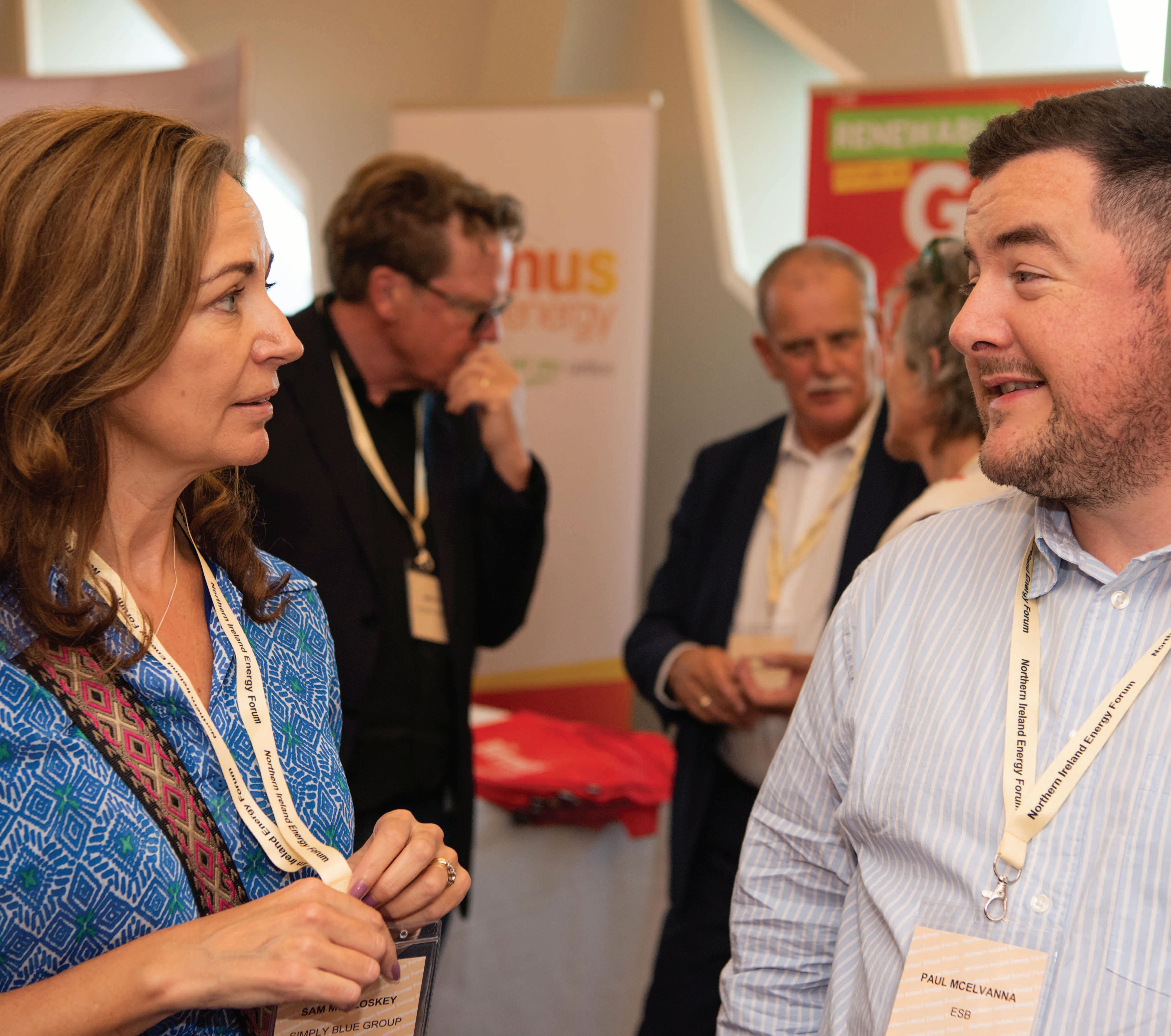





Sponsored by


Groundbreaking Research – saving and improving lives

The British Heart Foundation (BHF) is the largest independent funder of heart and circulatory disease research in Northern Ireland. Formed over 60 years ago, the leading heart charity has revolutionised the treatment and care of heart and circulatory disease.
Its ground-breaking research has saved countless lives and the charity continues to fight for the 225,000 people living here with heart or circulatory conditions such as coronary heart disease, heart failure, and stroke.
Head of British Heart Foundation Northern Ireland, Fearghal McKinney, tells agendaNi about the progress the charity is making in heart health and why its life-saving research is more vital than ever.
We have come a long way since the BHF began over 60 years ago. In the 1960s, more than seven out of 10 heart attacks in the UK were fatal. Today, over seven in 10 people survive. This is tremendous progress, but our work is far from over.
In Northern Ireland, despite all the good progress, around 225,000 people are living with heart and circulatory disease.
These conditions are responsible for nearly a quarter of all deaths here, tragically claiming an average of 11 lives every single day.
And alarmingly, more people under the age of 75 are now dying from these diseases than at any time in the last 14 years. This is a wake-up call that means we must act now, to continue that vital research journey.
Innovation and determination were the focus of one remarkable story that highlights the lifesaving impact of BHF research. Professor Frank Pantridge and his team, who were modestly funded by the BHF in Belfast in the 1960s, revolutionised emergency care worldwide.
He developed the first portable defibrillator, a device that has since saved countless lives. His legacy is a testament to the power of research –and to the vital role your support plays in funding it.
Today, thanks to our supporters’ generosity, we are funding pioneering research at Queen’s University Belfast into conditions like heart failure and heart attack recovery.
Recently, we brought together researchers from Queen’s and Ulster University with our new Chief Scientific and Medical Officer, Professor Bryan Williams, to chart an exciting new direction for research here in Northern Ireland.
But our research is needed now more than ever. Earlier this year, we launched a campaign on the urgency of tackling sudden cardiac death. Twelve poignant murals were created across the UK by the BHF to highlight the tragic reality that 12 young people under the age of 35 are lost every week to sudden cardiac death in the UK.
One of these striking artworks was unveiled on Linenhall Street, Belfast and depicted popular barman and electrician Joseph Burns, who suffered a sudden cardiac arrest at his parents’ home 10 years ago in July 2014.
Too many lives, like Joseph’s, are being taken too soon by sudden cardiac death. No one should have to experience the sudden loss of their child, sibling, or parent, but sadly that is the cruel reality of heart disease – it does not discriminate.
The BHF is already carrying out groundbreaking research, to treat and prevent the causes of sudden cardiac death.
BHF researcher, Kathryn McGurk, whose family hail from Northern Ireland,

“BHF continues to work every day on tackling health inequalities within cardiovascular care.”
is one of a team of scientists working to develop a cure for inherited heart muscle diseases which affect around 8,000 people here.
BHF’s £30 million CureHeart programme – the most ambitious research grant in the BHF’s history –aims to develop the first cures for inherited heart muscle diseases.
BHF can only invest in transformational research like this thanks to the generosity of our loyal supporters – so it is vital we have continued and increased support if we are to keep backing lifesaving research like CureHeart – but there is still more to do.
Our efforts also extend beyond research. We successfully campaigned for CPR training to become a mandatory part of the school curriculum here and worked with the Department of Education and the Northern Ireland Ambulance Service to make that happen.
Every year, we distribute 28,000 heart health resources across Northern Ireland, and our life-saving tool RevivR, offers free CPR training in just 15 minutes – available to anyone, anywhere, with just a cushion and a phone.

We are also working closely with sports teams, community groups, schools and businesses to expand this lifesaving training. Earlier this year, during Heart Month, we teamed up with the Northern Ireland Football League to train football clubs in CPR, and we have plans to work with many other organisations in the coming year.
Our influencing work over the last number of years has helped deliver significant change, most recently in the area of organ donation legislation. As of June 2023, all adults in Northern Ireland are considered potential organ donors unless they choose to opt out or are in an excluded group. The Organ and Tissue Donation (Deemed Consent) legislation, known as ‘Dáithí’s Law’ in honour of young Dáithí Mac Gabhann, changed the way consent is granted and follows similar law changes in Wales, England, and Scotland.
Over the past year we have been working with the NI Agri-Rural Health Forum and Farm Families Health Checks team to drive work on blood pressure awareness amongst the farming community. This culminated in an event we held at the Balmoral Show with attendance from the health and agriculture ministers as well as many
agri-rural stakeholders. We continue to work with this important community in Northern Ireland through driving awareness of lifesaving skills.
Our ambition in influencing government and the health system is to achieve the best outcomes for patients. We are working with the cardiology network and leading cardiologists and heart nurses to, amongst other things, prevent heart disease by targeting blood pressure and cholesterol, improve treatment and care for those with heart failure, and increase opportunities so everyone can take part in cardiac rehabilitation.
Critical to the survival journey is the defibrillator but knowing where to find one in an emergency can be the difference between life and death. That is why we developed The Circuit in partnership with the Association of Ambulance Chief Executives, Resuscitation Council UK, St John Ambulance, and NHS England.
The Circuit is the national defibrillator network that maps defibrillators across the UK. This system allows ambulance services to direct bystanders to the nearest defibrillator, potentially saving lives in those critical moments.
But there is still work to be done. We have registered over 98,000 defibrillators on The Circuit, and more than 3,500 in Northern Ireland, but we know there are many more out there that remain unregistered. In the coming months, we will be campaigning to reach 100,000 defibrillator registrations, ensuring that more lives can be saved in emergencies.
BHF continues to work every day on tackling health inequalities within cardiovascular care. Our focus has been on primary care with blood pressure and cholesterol checks as well as women’s health.
We recently launched our Bias and Biology: The Heart Attack Gender Gap report timed to coincide with development of a women’s health action plan by the Department of Health to highlight that there can be no consideration of any health without considering heart health as a vital component.
This is the first BHF report into women’s heart attack outcomes in Northern Ireland that addresses socio-economic differences and makes recommendations across themes of awareness, diagnosis and treatment.
Non-communicable diseases (NCDs) such as heart disease, cancer, stroke, diabetes, lung disease, and liver disease are some of the leading causes of death and disability.
In fact, research commissioned by BHF Northern Ireland in 2023, estimates the overall annual cost to society of smoking, alcohol consumption and obesity in Northern Ireland is around £1.9 billion – equivalent to 4.5 per cent of the Northern Ireland economy.
NCDs place a huge burden on society and our health and social care system. They also disproportionately affect the most deprived in our communities, contributing to health inequalities.
Many of these deaths and lost years of healthy life could be prevented through public health action to address NCD risk factors. Investing in population-wide action to reduce rates of smoking, harmful alcohol consumption, and overweight and obesity is also important for the longer-term resilience of our health service and the wider economy.
As Chair of the NI NCD Alliance, BHF NI is working alongside a number of key stakeholders to help prevent heart and circulatory disease and other NCDs by campaigning for urgent, population-level action to reduce rates of smoking, harmful alcohol consumption, and overweight and obesity.
Heart and circulatory diseases cause nearly a quarter (24 per cent) of all deaths in Northern Ireland but there is a gap in the strategic direction to addressing cardiovascular conditions. The previous service framework for cardiovascular health and wellbeing expired in 2017. Despite the prevalence of heart and circulatory disease in Northern Ireland, there has been no updated strategic approach for improvement of the care of patients with heart and circulatory disease.
At the end of last year BHF NI brought together over 150 local staff, patients, and leading voices in heart and circulatory diseases from across UK, Ireland and Europe, to shine a spotlight on heart disease within Northern Ireland and the need for a renewed strategic approach.
“Lifesaving research is more vital now than ever and your support in that ambition is vital too.”
The audience was made up of clinicians, some stakeholders and officials as well as a panel of MLAs. We had a range of high-profile speakers including Professor Rafael Bengoa, alongside international speakers from the European Society of Cardiology, Scotland, Ireland and England.
Our health and policy teams are working to identify gaps in services and map out a range of actions and interventions that are practical and cost effective that can form the core of a heart disease campaign.
We will aim to support and enhance the cardiac network, produce recommendations to reduce the Northern Ireland postcode lottery of services, reduce demand on stretched services, improve life expectancy and reduce the burden on care.
At a national level, BHF is calling on the new UK Government to make a meaningful difference to the lives of people affected by heart disease by committing to bold co-ordinated action on three fronts; better prevention of heart disease and stroke by addressing drivers like obesity and smoking, prioritisation of heart care and supercharging research to unlock future treatments and cures.
None of what we do would be possible without public support – all our income comes from the public, whether it be face to face fundraising events organised by our local fundraisers, charity partnerships, contributions from wealthy donors, or those who think of us kindly in their wills.
And we also have seven shops across Northern Ireland where we sell clothing, jewellery, books, games and much more, donated to us by the public.
We recently held a supporter event at Belfast City Hall, with over 100 of our amazing supporters in attendance. It offered the opportunity to connect and share stories on the lifesaving work the BHF does in heart and circulatory research and strengthen our collective commitment.
Many of the wonderful families we work with closely were in attendance as well as new supporters who we are excited to get to know better.
Our supporters’ contributions whether through fundraising, volunteering, or simply by spreading awareness, have made the British Heart Foundation the largest independent funder of heart and circulatory disease research in Northern Ireland.
Lifesaving research is more vital now than ever and your support in that ambition is vital too.
Contact BHF NI
Órla Copeland, Fundraising Manager T: 07714 069129
E: copelando@bhf.org.uk
Liam Duggan, Policy and Public Affairs Manager T: 07974 901087
E: dugganl@bhf.org.uk
Karen McCammon, Health Service Engagement Lead
T: 028 9002 3545
E: mccammonka@bhf.org.uk

Minister of Health Mike Nesbitt MLA has outlined his primary policy pieces to complete the health reform jigsaw, the details of which have been met with some scepticism by Executive partners and opposition colleagues alike.
In July 2024, the Health Minister issued a Written Ministerial Statement to update MLAs on his policy priorities. In a previous speech, his first to the Assembly since assuming the portfolio in May, Nesbitt identified health inequalities as his predominant focus. Outlining his intention to “reboot the public conversation about health reform”, the Minister announced his intention to publish two associated documents:
1. a draft hospital reconfiguration framework; and
2. a three-year strategic plan for health and social care focusing on stabilisation, reform, and delivery, with an overriding objective of producing better outcomes for patients.
Furthermore, the Basque public health and management specialist, Rafael Bengoa was invited by the Minister to return to Northern Ireland where he
was the keynote guest speaker at the October 2024 ‘Health and Social Care Reform: Accelerating Change’ conference.
Speaking ahead of the conference, Bengoa said: “The analysis in Systems Not Structures [the Bengoa report] is just as valid today as when it was published. The need for transformation, backed by sustained resources, is ever more pressing.”
After eight years, Bengoa’s one-day return was showcased as a significant component of the health reform “reboot”.
In the same month, the Health Minister published Hospitals: Creating a Network for Better Outcome, a draft reconfiguration framework for hospitals
which outlines the principles informing the creation of an interdependent hospital network. The foremost principle of the draft framework is that while all existing hospitals will have a role to play, they cannot provide all services.
With modern medicine driving increasing clinical specialisation and subspecialisation, change, Nesbitt argues, is inevitable. As such, while stressing that “no acute hospitals will close”, he asserts that not every hospital can provide every service, and the roles of specific hospitals must change.
The Minister said: “We need to see each of our hospitals as part of something bigger and wider – fitting into a network in which each plays a key part. This is essential if we are to deliver better outcomes for patients and staff.”
Referencing Bengoa’s 2016 report, Systems, Not Structures: Changing
Health and Social Care and the 10-year plan produced in response, Health and Wellbeing 2026: Delivering Together, the draft framework places acute hospitals into four main categories within a wider network.
1. Local: delivering primary, secondary, and community care services in support of general and area hospitals. This includes Ards Hospital, Bangor Hospital, Dalriada Hospital, Downe Hospital, Lagan Valley Hospital, Lurgan Hospital, Mid-Ulster Hospital, Moyle Hospital, Omagh Hospital and Primary Care Complex, Robinson Hospital (Ballymoney), South Tyrone Hospital, Waterside Hospital, and Whiteabbey Hospital.
2. General: delivering defined secondary care services, including the delivery of some unscheduled care alongside elective care for a specific geographic location. This includes Causeway Hospital, Daisy Hill Hospital, and Southwest Acute Hospital.
3. Area: delivering a full range of secondary care services within a geographic area defined by the five health and social care trusts. This includes Altnagelvin Hospital, Antrim Area Hospital, Craigavon Area Hospital, Belfast Hospitals Campus, and Ulster Hospital.
4. Regional: delivering specialist inpatient services for the entire population. This includes: Altnagelvin North West Cancer Centre, Belfast City Hospital including the Cancer Centre, Musgrave Park Hospital, Royal Belfast Hospital for Sick Children, Royal Jubilee Maternity hospital, Royal Victoria Hospital, and Ulster Hospital Regional Centre for Plastic Surgery and Maxillofacial Surgery.
Furthermore the draft framework establishes five enablers and 13 actions to support the delivery of a connected hospital network.
The five enablers are: workforce, funding, communities and people, digital solutions, and cross-HSC trust collaboration, while actions include consideration of:
• available travel supports;
• maintaining core general hospital services in the short to medium term;

“Reconfiguring hospital services remains an important part of the overall jigsaw.”
Minister of Health, Mike Nesbitt MLA
• moving specific activities out of specialist regional centres into area hospitals;
• aligning clinical training with projected population health demand;
• reviewing how vulnerable specialist services might be consolidated via closer collaboration with Britain and the Republic.
The draft was opened to public consultation on 2 October 2024 and closes on 22 January 2025.
In a letter addressed to all MLAs on 30 September 2024, the Minister promised MLAs that his department would publish the three-year plan determining the health and social care strategy for the Assembly’s remaining mandate within weeks of Bengoa’s departure. At the time of writing, this document has yet to be published.
In the same letter, Nesbitt warned: “The current financial position makes progress all the more difficult... While the Programme for Government sets out the limits that the present budgetary situation places on efforts to reduce waiting lists, I will continue to make the case for significantly more funding for health.
“I have no time for the argument that money alone is the solution to the health service’s ills. Equally, anyone who suggests it is not part of the answer is sadly mistaken.”
As such, the public now awaits the publication of the three-year plan as the final piece of the health reform jigsaw, and its subsequent implementation alongside the hospital reconfiguration.
In the meantime, considering the one element of reform that has been published to date – the draft hospital reconfiguration framework – the response of the Minister’s Assembly and Executive colleagues has been less than positive.
From an opposition perspective, the SDLP’s health spokesperson Colin McGrath MLA commented on the proposed reconfiguration saying: “We cannot escape the fact that there is very little detail in the Minister’s statement today about what transformation will look like or what form it will take.”
Likewise, while welcoming the announcement, Alliance Health spokesperson Danny Donnelly MLA asserted: “We do not need more reviews and frameworks... We need decisions now. There is some concern around the lack of detail on how this will work in practice.”
At the same time, Sinn Féin MLA Liz Kimmins insisted: “Consideration must also be given to ensure those in more rural areas are able to access hospital services in a timely manner when they need to.”







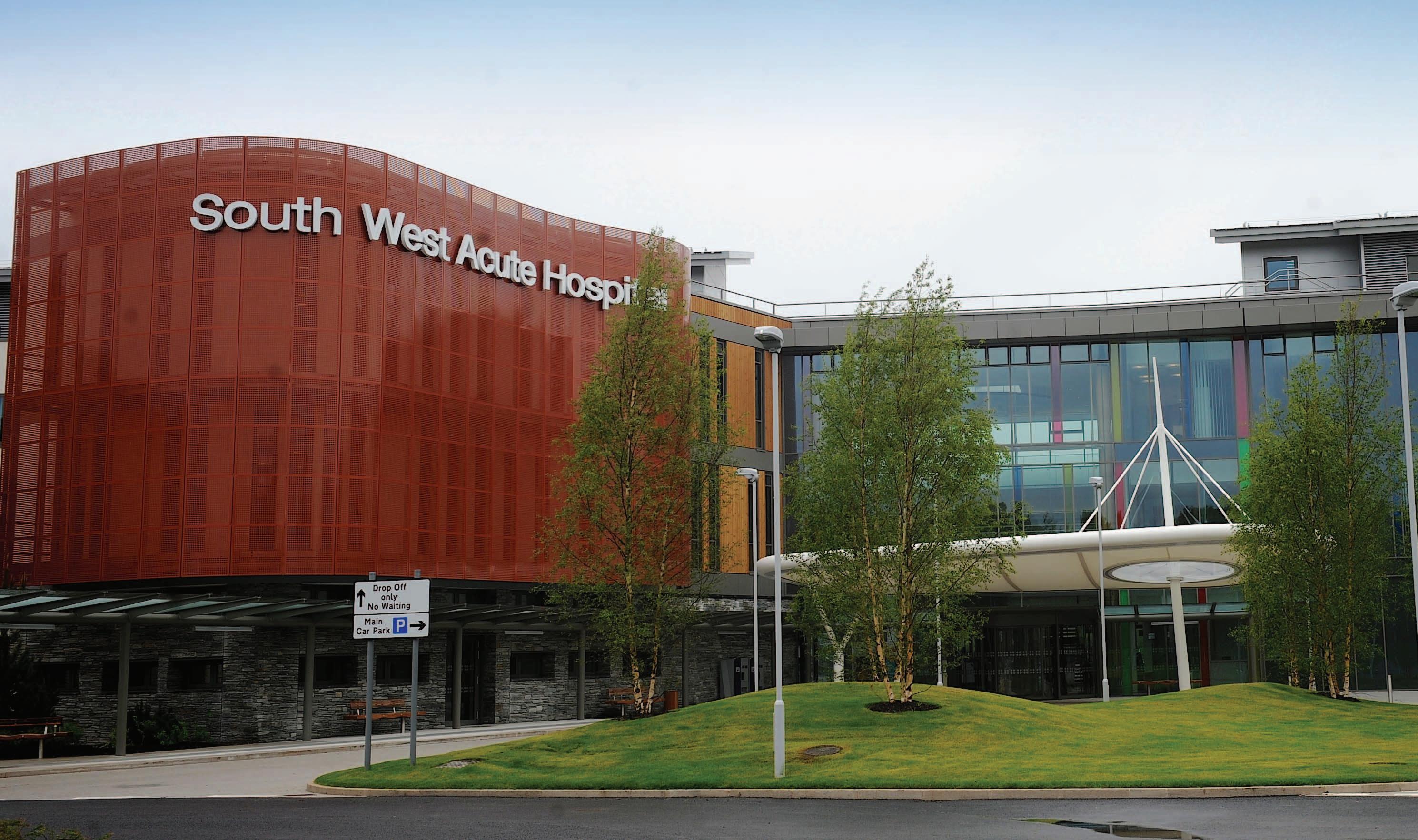














































“According to Professor Bengoa, the cost of not doing reform is that, by 2040, health will absorb the entire – the entire – Northern Ireland Executive Budget. There will be nothing for schools or infrastructure — nothing for anything except health. We have to do it,” declared Health Minister Mike Nesbitt MLA when asked about the cost of not transforming the health service.



Nesbitt was taking questions from MLAs in the Assembly shortly after the publication for consultation of a new plan to reform Northern Ireland’s hospital network.




Hospitals: Creating a Network for Better Outcomes navigates away from the politically sensitive subject of hospital closures – despite that being the recommendation of successive health reviews stretching back to 2001 – through a reconfiguration of services provided by existing hospitals, rather than closing facilities.














An uncosted plan to reform Northern Ireland’s hospital network will require “every square inch of current acute hospital capacity”, Health Minister Mike Nesbitt MLA has outlined.









In essence, patients will be asked to travel further for certain types of care but will be seen faster, as some services are consolidated in a bid to avoid duplication and competition for resources.
















Details of exactly what this consolidation will look like is absent from the plan, as is any form of costing – with critics understandably cynical given the framework is the latest in a line of healthcare reviews, all of which have been unsuccessfully implemented.




The Minister has stated that the framework should not be viewed in isolation “but as an important piece of the overall puzzle that will deliver better outcomes”.
Interestingly, the framework was published shortly before a visit to Northern Ireland by Raphael Bengoa who led the delivery of the 2016 Systems, Not Structures review, a foundation for the 10-year Health and Wellbeing 2026: Delivering Together strategy






















Bengoa’s visit could be read as an attempt by those leading health reform to emphasise that work remains ongoing, and perhaps re-energise the conversation around why change is necessary.




Talk of radical reform to the hospital network first emerged in 2001, when the Maurice Hayes


























review recommended, amongst other things, reducing the total number of hospitals. The 2011 Compton Review included a recommendation to cut the number of acute hospitals from 10 to five, while in 2014, the Donaldson report suggested closing some local hospitals in recognition that expertise was being too thinly spread across Northern Ireland’s network.


Bengoa’s report was the fourth health review in less than a quarter of a century that has suggested cutting or changing the number of acute hospitals, but change to date has been piecemeal.


2. In relation to transport and travel challenges, including ambulance services, the plan recognises that the movement of both patients and staff between services and sites will require crossdepartmental working alongside other key partners to address challenges around road infrastructure, the public transport network, and digital connectivity in rural areas.

A number of barriers have curtailed health transformation, primarily, political instability as well as a shortage of public finances. A further recognised barrier is that closing services is deemed politically unpopular.
Navigating this, Nesbitt has made it clear in his foreward to the new framework that “no acute hospital will close”. Instead, the framework indicates the need to develop regional centres of excellence or surgical hubs for some inpatient services.
“The reality is that we will continue to need every square inch of current acute hospital capacity,” the framework states, adding: “The roles of some hospitals will change to better deliver the health needs of the community and keep pace with modern medicine, as well as contribute to regional delivery. Services may be relocated in some cases from their existing locations, but all hospitals will continue to play a central and vital role in our health service and in their local communities.”






3. On patient pathways, the plan states: “Patient pathways or a person’s route to treatment must be at the heart of system reconfiguration and discussed at the earliest possible opportunity. Pathways must be mapped with serious consideration given to stakeholders required to ensure pathways work in a seamless way and in the end create a more efficient and effective outcome for both patients and staff.”

The framework categorises Northern Ireland’s acute hospitals into four specific main types: local hospitals; general hospitals; area hospitals; and regional centres. Outlining that it is unsustainable for all hospitals to provide all services, the Department of Health says that the framework will seek to identify the core services in each of these types of hospitals and consider the key challenges to sustainably deliver these. However, while the framework proscribes a future action plan, no timeline has been set for delivery.







Hospitals: Creating a Network for Better Outcomes proposes a total of 13 actions ranging from a review of the Department of Health’s Transport Strategy, through to designating Causeway as an elective care centre, and the definition of a suitable level of protected bed base, diagnostic and theatre capacity for regional specialist services.


















Importantly, the framework highlights that hospital network reform is not without challenges, and pinpoints three key areas where action will be required.

1. On workforce challenges, the plan says that actions will need to be taken to proactively address challenges in working across HSCT areas such as travel, recruitment, retention, and equity in the division of workloads.






Opening the consultation to the plan in early October 2024, Minister Nesbitt said: “While every hospital cannot provide every service, each hospital will still play a vital role, not just in their local communities but as a valued part of a planned regional system.





“This document can help assure communities that reconfiguration of services is not about cutting costs or closing hospitals. It is about managing change in a controlled way and demonstrating the benefits. It’s about showing how each hospital can fit into the network and best serve patients.




























“Change is happening. We see that with the increasing shift towards centres of excellence such as standalone elective care hubs. This is reform in action but there is much more to do. A collaborative approach can better sustain our network to the benefit of patients and staff.”






However, publication of the document was met with some scepticism from MLAs. Diane Dodds, the DUP’s health spokesperson described the plan as “underwhelming”, and pointed to a lack of detail in the publication.
“Eight years on from the Bengoa Report, why is the focus still on principles? Surely we have had all the frameworks we need?” she stated.
























Similarly, the SDLP’s Health Spokesperson Colin McGrath MLA said: “Without concrete proposals or timescales there is genuine concern that transformation could once again be allowed to drift. We have heard
























































multiple health ministers pay lip service to the notion of transformation but what we need now is delivery to transform our health service and make it fit for purpose to provide patients with the care they need.”



Health Minister Nesbitt has indicated that Hospitals: Creating a Network for Better Outcomes was the first of a series of planned announcements and publications aimed at setting health and social care services on a clear path to recovery.
















Following the publication of the plan, the Minister has set out plans to publish a major review of maternity services and a three-year strategic plan for the remainder of the mandate.




Action 1: The Department will work with the Executive departments to consider carefully the travel support available for our population.
Action 2: DoH to review 2007 Transport Strategy for Health and Social Care services in Northern Ireland.








Action 3: HSC Trusts to continue to consider how their local hospitals can best and most sustainably meet local population needs.




Highlighting that the current financial position makes progress more difficult, he adds: “While the Programme for Government sets out the limits that the present budgetary situation places on efforts to reduce waiting lists, I will continue to make the case for significantly more funding for health.
















“I have no time for the argument that money alone is the solution to the health service’s ills. Equally, anyone who suggests it is not part of the answer is sadly mistaken.”



Action 4: Consideration to be given as to how in the short to medium term HSC Trusts can work in collaboration to maintain these core general hospital services.







Action 5: Consideration to be given to designating Causeway as an Elective Care Centre.






Action 6: Consideration to be given as to the most sustainable allocation of resources across area hospitals to minimise inequities in access to services.




Action 7: Consideration to be given to moving suitable activity out of specialist regional centres into area hospitals.


















Action 8: Consider approach to clinical training to ensure that job roles best match current and future population health needs.
Action 9: Consider how the allocation of doctor training places and development of new roles such as advance practice roles can best support service sustainability across the hospital network.































































2001 Maurice Hayes Review:
The review recommended reducing the hospitals, amalgamating health boards into one, integrating health and social care, removing accident and emergency services from five of Northern Ireland’s smallest acute hospitals.













Action 10: Continue with a rolling programme of speciality specific workforce reviews, to encompass all skill mix roles.








Action 11: Review regional specialist services and identify those most vulnerable. Consider how vulnerabilities can be mitigated, for example through strengthening links with colleagues in Britain and the Republic.




Action 12: Define a suitable level of protected bed base, diagnostic and theatre capacity for regional specialist services.












2011 Compton review:



Action 13: DoH to explore with HSC Trusts and NICON how provider collaboration might help to support and sustain the hospital network.











Transforming Your Care: A Review of Health and Social Care in Northern Ireland offered a range of proposals including a 50 per cent reduction of Northern Ireland’s 10 acute hospitals and the opening of new health and care centres in Banbridge, Ballymena and Omagh.












2014 Donaldson Report:




2016 Bengoa Report:



The review recommended closing local hospitals and self-management of chronic disease based on an understanding that there too many hospitals and expertise was being too thinly spread.






























The basis of a 10-year plan introduced by then Health Minister Michelle O’Neill, the review set out 18 timespecific action points aiming to improve services, cut waiting list times and improve care for an ageing population. Underpinning the review was the need to transform heath and care service delivery on the understanding that the existing model was unsustainable.



































The PCC provides independent advocacy support to the public who may have an issue in health and social care. Our focus is on working with HSC organisations to find a resolution to
Advocacy support is not only vital for individuals and families, it is a key part of assurance within the HSC system; it can reduce the potential for compounded harm, build trust in services, enhance potential learning, and address inequality and inequity in complaint and engagement processes.




Being able to hear, understand, and strategically address people’s issues is vital to tackling the causes of persistent health inequalities, writes Patient and Client Council (PCC) CEO, Meadhbha Monaghan.





One of Health Minister Mike Nesbitt MLA’s key areas of focus is tackling the persistent health inequalities which exist in Northern




Programme for Government and the Live Better initiative place a clear and welcome focus on this issue.


We know there are numerous social and economic determinants of health inequalities and it is right to recognise that addressing these will require a cross-cutting and cross governmental



















This is underpinned by the need to change the nature of the relationship between the public and services, from one of passive recipients to active partnership.




In an effort to make our services more accessible, over the coming months PCC are working with voluntary and community organisations and others already embedded in local communities, to bring our trained practitioners to different locations across the region. Our aim is to reach members of the public who may not usually access our services. By building relationships with local communities and voluntary and community organisations, we aim to work collaboratively to do our part in helping reduce health inequalities through accessible advocacy support.






Through their lived experience, the public know what their needs and those of their communities are, what has worked and what has not. To this end, there is a growing recognition of the need to more effectively involve the public in policy development, public sector reform, and in delivering effective and safe services.





A strategic and cross-governmental approach to public participation, which embraces the public as assets and has the ethos of partnership at its core, has the potential to shift the dial on delivering much needed public sector reform and sustainably tackling health inequalities. With the statutory duty of Involvement that exists across the health and social care (HSC) system, there is the potential for the HSC to lead in this area.
































Being able to hear, understand, and strategically address people’s issues is vital to shaping services which meet the diverse range of people’s needs and to tackle the causes of persistent health inequalities. People who are facing health inequalities often face difficulties accessing, navigating, and resolving issues about HSC services, which can be extremely complex. They can often go

















The overall landscape of advocacy service provision is, however, fragmented. At the PCC we are making the case for regionally commissioned independent advocacy services. Such an approach would give assurance that the public has consistent access to advocacy support. This, in turn, would help develop a strategic approach to public participation and tackling longstanding health inequalities.











T: 0800 917 0222







E: info@pcc-ni.net

W: www.pcc-ni.net

X: @PatientClient








































































With such an enormous impact now and into the future, we cannot afford to ignore dementia

Many of you reading this will personally know the impact of dementia on those living with it. It is a profound personal and family challenge, but the impact does not end behind closed doors. The pressure on the health and social care (HSC) system, and the huge personal and economic costs present the most urgent health challenge of our time, writes Ruth
Barry, National Influencing Manager at Alzheimer’s
Society.
The numbers are daunting. The cost of dementia in Northern Ireland is £1 billion a year now, forecasted to reach £2 billion in just 15 years. Tragically, that cost falls most heavily on those living with the condition and their carers (63 per cent). We, at Alzheimer’s Society, are determined to change this and, not only shine a light on the scale and urgency of the challenge but – for the first time –clear, evidence-based actions to ease pressure and reduce cost.
Around 25,000 people are living with dementia in Northern Ireland today, and at least a third of these people do not have a diagnosis. Research commissioned by Alzheimer’s Society estimates the number of people living with dementia will increase from approximately 25,000 to 37,500 by 2040. The scale of the increase is the highest amongst equivalent figures for England and Wales.
We can, and must, challenge the status quo. Policymakers have not prioritised dementia, and the rising costs and pressures are relentless. There are clear, positive choices that can be made NOW and must be made to support the HSC system to address the challenge presented by dementia, now and into the future.
At the recent NICON conference, Heath Minister Mike Nesbitt MLA stated that if we do not make radical changes within the next 15 years; the health service will swallow up all public funding.
Let us choose to take a different path.
Today, across the UK, almost one million people with dementia access A&E every year, one in every six hospital beds are occupied by someone with dementia, and people with dementia make 16.2 million visits to GPs every year.
We are not simply pointing out problems in the system, we are presenting an overwhelming, evidence and policybased case for change. Our evidence shows that people who are undiagnosed are disproportionately drawing on healthcare resources. Those who are undiagnosed are three times more likely to visit A&E than people without the condition. Undiagnosed people with dementia visit A&E more than people with mild, moderate, and severe dementia. If we do not act now, the health service will be completely overwhelmed.
The current diagnostic pathway is slow and disjointed, with significant variation in the quality of diagnosis services across Northern Ireland, including speed of delivery, accuracy and referral to support services. On average, a dementia diagnosis takes 3.5 years from the onset of symptoms, with no specific national target included in the Regional Dementia Pathway published in 2018 (which remains to be fully funded and implemented).
We have clear evidence that demonstrates the importance of early and accurate diagnosis yet spending on diagnosis and treatment in the UK is equivalent to just 1.4 per cent of dementia healthcare costs – in contrast, a third of all dementia health spend is in unplanned hospital admissions. We need to invest in dementia diagnosis through enhancing access to diagnosis services and collecting national and local

diagnosis data. Without this, people will not be able to access existing treatments and interventions to help manage their symptoms today or be ready for the disease-slowing treatments of tomorrow.
Diagnosing someone with the UK’s biggest killer is more than just a moral duty. It unlocks access to support and potential treatments or interventions which directly translates into reduced system pressure.
We now know, through the research Alzheimer’s Society commissioned from Carnall Farrar, that the average annual cost of dementia per person increases as the condition progresses, going from £29,000 for mild dementia to £81,000 for severe dementia. These are enormous cost differences and anything we can do to intervene early and effectively is critical.
By diagnosing people just one year earlier and providing access to these NICE-approved treatments where they are effective, modelling suggests there could be savings of tens of thousands of pounds by delaying the onset of severe symptoms. By delaying the impact, people with dementia can enjoy their independence and a better quality of life for longer, meaning that nursing home admission and expensive, intensive care required for more severe dementia, comes later down the line.
More research is needed to fully understand the impact of the available treatments. What we do know is that they are most effective the earlier they are given. To achieve these savings, we first need to diagnose people and diagnose them earlier.
Minister Nesbitt has set out his priorities, an intention to ‘reboot Bengoa’ and a renewed focus on dementia through the Regional Dementia Project Board. We know in starker terms than ever before that the foundations for delivering better care for people, for easing pressure, for reducing cost – begin with improving diagnosis.
As Lord Darzi says, citing our evidence in his recent report on the state of the NHS in England: “There is an important challenge to improve the quality and quantity of care for people with dementia.”
I could not agree more.
It will take a society to beat dementia. This is a challenge which must be faced and faced now. It will take all of us together.
Call: 0333 150 3456. If you are affected by dementia, worried about a diagnosis or a carer, trained staff are ready to give you the support you need.


Chief Digital Information Officer at the Department of Health, Dan West, discusses the current and future benefits of ongoing digital transformation in the health and social care sector.
Outlining the vision of the Department of Health’s 2022 Digital Strategy to deliver, before the end of the decade, the transformation of health and social care into a highly integrated and personalised system, with services tailored to an individual’s genetics, being data driven, and optimised by advancements in digital technology, West is quick to point out an existing projection that, without successful interventions, by 2040 the entirety of Northern Ireland’s block grant would need to be dedicated to health and social care services, due to the current trajectory of healthcare inflation.
“It is a stark figure and driving the digital transformation of health and social care in that financial context is not straightforward,” he explains.
The Department of Health’s Digital Strategy, alongside underpinning data, cyber security, and innovation
strategies, outlines the strategic intent to 2030 and represents a £1.3 billion investment portfolio. Outlined in the strategy is an overarching vision of “making lives better for the people of Northern Ireland, using digital to transform the way we deliver health, care and wellbeing services”.
Underpinning this vision, West explains, is a recognition that without transformation: “Our children will not be able to get health and care in the way we expect to get it, unless we do something bold and different in the way we deliver those services.
“We need to change experiences, both for staff who give the care, and for service users who receive the care, and we need to drive transformation in a very different way than we have done over the last few years. This strategy helps us to understand that,” he says.
Currently, says West, the Department is
doing a lot of “programmatic delivery”, which he explains is aimed at addressing technical debt and historic underinvestment.
Offering a high level look at the investment portfolio, he points to the development of the ‘Encompass’ single electronic health record (EHR) being delivered on top of the Northern Ireland Digital Identity Service (NIDIS), both of which launched in 2023. This has enabled the ongoing rollout of converged clinical platforms, including Northen Ireland Laboratory Information Management System (LIMS) and the Northern Ireland Picture Archive and Communication System (NIPACS+), across secondary hospital care, mental health, community and social care services.
Wider again is the current delivery of some 80 projects in the enterprise portfolio delivery phase, with a further

Source: Department of Health
80 in earlier stages of discovery, business case development, procurement or design –all aiming to improve care services and data capabilities. Included in the next wave of transformation are two investments that replace significant and outdated IT infrastructure and systems: the Northern Ireland Blood Production and Tracking project, to build a new vein to vein blood product tracking platform, and the Equip programme, which replaces current backoffice systems with the new Oracle Cloud platform.
“Equip is a hugely impactful programme, and a really important next step for Northern Ireland – it will drive convergence and modernisation in our back office and provide a new technology platform for delivery of finance, procurement, logistics, HR and payroll”, explains West.
Highlighting recognition that much of the early work has been centred on technology, but that technology is not the end in itself, he stresses that improved services are about improved economic outcomes and improved health and social care for society.
“We need to pivot away from the big delivery activities of the last few years, and having broken the back of our technical debt, start thinking more about how we leverage the new platforms, build our capabilities to do transformation at the front line of service delivery, and make care better for people in this region.
“Building a new digital transformation and innovation capability collectively from the centre out to all of the care delivery organisations and care professionals is a large area of focus for my team currently.”
Reflecting on the successes of the last few years, West outlines what has been a busy implementation roadmap.
Since 2019, the Department has been developing a range of business cases, and working with stakeholders, particularly financial leaders with economic responsibility to approve the investment portfolio. While the outbreak of Covid-19 served to disrupt the planned digital journey, West explains that much progress was made on digital transformation during this time.
Pointing to the rollout of a completely new Microsoft environment, the CIO explains that this underpinned the convergence of clinical services and the enablement of remote working during the pandemic.
West goes on to explaining that by May 2025, the Department will have completed the roll out of Encompass, which will be “globally unique” as a single, national platform including both health and social care services being supported by a single system.
Discussing the impact of progress to date, West says: “‘Once of Northern Ireland’ should not be overlooked.


“The fact that we now have a single converged platform for all organisations and services in secondary care, mental health, community services, and social care, to deliver care models and care outcomes, is a huge accomplishment. Health and social care delivery is understandably complex, so the ability to simplify this by delivering a single platform brings a lot of benefits.
“The single digital environment brings all professions and services into one information environment, digitally enabling a range of workers who would not previously have had access to technology. We have rolled out masses of end user devices and end points to staff who otherwise would not have interacted with digital records as part of the way they do their jobs.
“A second advantage is the ability to track for safety and quality. We now have a single place to automate the movement of work around our system. Diagnostic tests in laboratories and in medical imaging currently move digitally through the system, based on the new platform. Now, we can bring diagnostic results into clinical workflows and provide protocolised alerts to clinicians involved in the care of an individual.”
Other benefits outlined by West include better teamwork and efficient care transitions; better service user experiences; service users as engaged participants; and the reduction of errors in end-to-end workflows.
Returning to the vision of helping clinicians to transform the services they
Source: Department of Health
deliver, West recognises that between 80 to 90 per cent of all healthcare interactions occur in primary care, he says: “Having made some headway in digitising secondary care, we need to shift focus to think about how we are going to work with stakeholders to help transform primary care, including community pharmacies – there is huge benefit in working with GPs to continue to improve digital capabilities in practices and in how our GPs enable services for citizens.”
West reflects on the fact that the investments are not about digitising the current operations “What we have built and bought for ourselves is an ability to drive change in a very different way than we did before. Converged platform and converged capabilities allow us to influence change more easily than we were able to before.
“We have got better connectivity, and will be able to ingest a broader range of data sources, including wearables, in order to manage chronic diseases, without putting the burden onto clinicians for dealing with that data.”
Concluding, West says: “The goal is not the technology, the technology is a means to an end – the ultimate goal is improved care outcomes, better care experiences for service users and staff, and a more sustainable health and care economy for our children. Healthcare is not about technology, it is about people.”

Although more than 28 per cent of individuals who died by suicide in 2022 were in contact with the relevant authorities before their deaths, the Department of Health has extended Protect Life 2, its existing suicide prevention strategy, by three years.
In October 2024, the Department of Health extended Protect Life 2: A Strategy for Preventing Suicide and Self Harm in Northern Ireland 20192024. When it was published in 2019, the Protect Life 2 Strategy aimed to achieve a 10 per cent reduction in suicide rates across Northern Ireland by 2024, a figure which may have been achieved, but classification of deaths means that the data thus far is too unreliable to decipher whether this target has been met.
Despite this potential progress, the most recent statistical release on deaths by suicide by the Northern Ireland Statistics and Research Agency (NISRA) shows that more than 28 per cent of individuals who died by suicide were in contact with relevant authorities before their deaths.
Furthermore, suicide rates in Northern Ireland’s most deprived communities remain three-times higher than in the least deprived areas, even after the efforts initiated under Protect Life 2. The strategy’s broad-based initiatives, have failed to meaningfully address these community-specific vulnerabilities, such as poverty, limited access to mental health services, and
higher social isolation. More targeted, and adequately funded, interventions tailored for at-risk populations are essential to address these gaps effectively.
Although Protect Life 2 underscores the importance of a multi-agency approach, evidence suggests weak levels of collaboration between health, education, and social services, particularly in rural and economically disadvantaged areas. The progress report indicates that while local groups met to advance strategy goals, a coordinated, overarching structure for cross-departmental action remains lacking. As a result, existing initiatives are fragmented, leaving many at-risk individuals without cohesive, accessible support systems.
The strategy’s extension suggests a continued need for robust crisis and postvention support, especially in rural areas where crisis intervention resources are sparse. Services like the Multi-Agency Triage Team (MATT) and the Lifeline helpline have helped address acute mental health crises, but analysis shows that these programmes are limited by underfunding and are not universally accessible. Effective,
region-wide crisis response remains crucial for de-escalating crises and supporting those bereaved by suicide, yet this component is currently underresourced.
Protect Life 2’s funding – £8.7 million annually – has proven insufficient to meet the needs of Northern Ireland’s most vulnerable populations. Additionally, data limitations hinder timely responses and targeted adjustments, with a recent review of suicide data from 2015 to 2020 revealing inconsistent classifications of deaths, thus complicating long-term tracking of suicide trends and areas needing immediate attention.
Speaking upon publication of a review designed to examine these failures – in spite of the review coinciding with the extension of the existing strategy –Health Minister Mike Nesbitt MLA stated that it is “clear that the research supports the need for collective action and sustainable funding and investment if the Executive is to deliver on the Protect Life 2 Strategy”, and further committed to develop a new draft action plan to be taken forward by Executive departments and delivery partners.
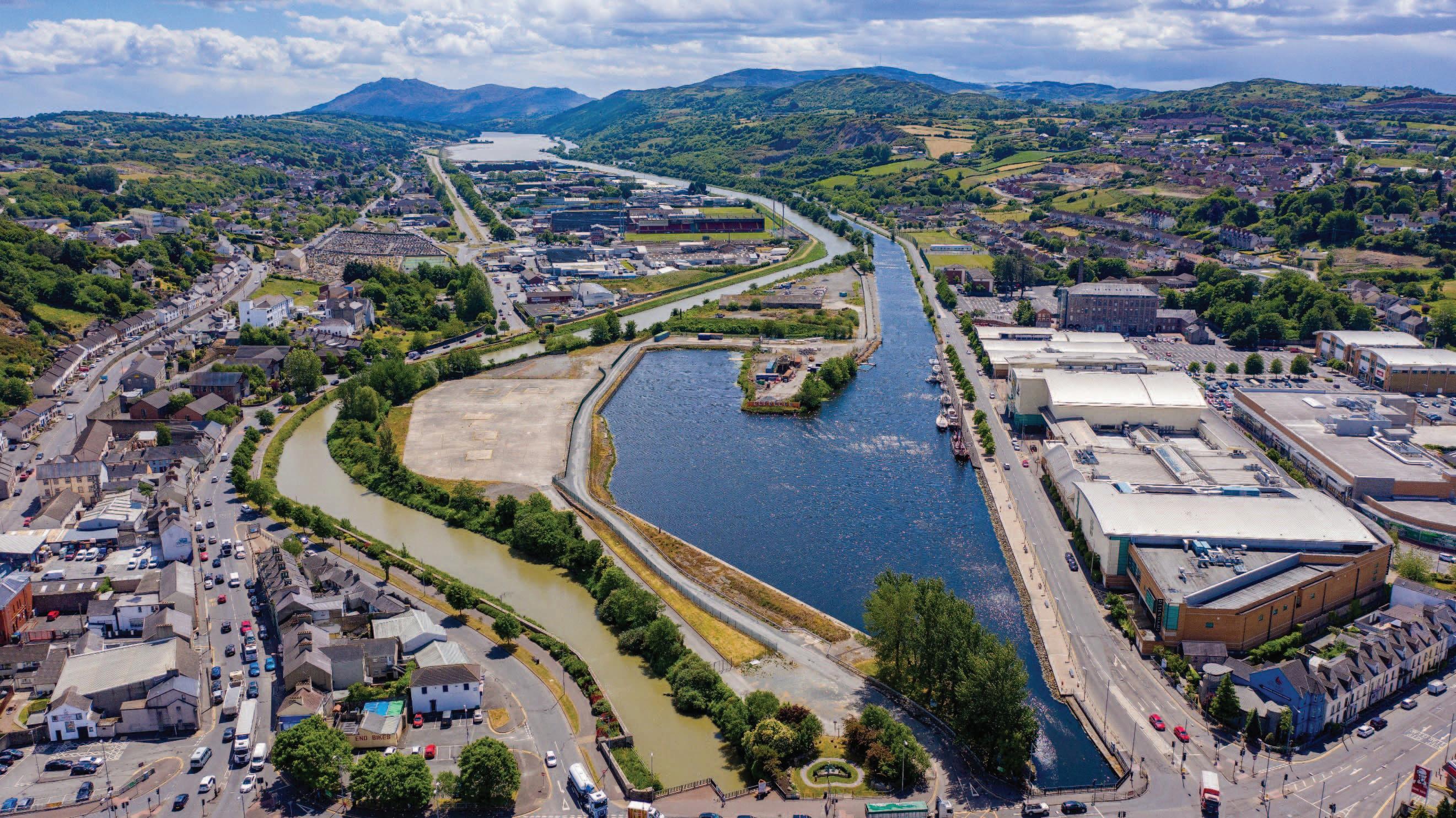
With its mission of a healthy and sustainable district, which provides better economic, environmental and social outcomes for all, Newry, Mourne and Down District Council is blessed with both significant natural assets and an enviable level of outside investment.
Key projects ranging from the multi-million pound Newry City Park to the Be Active for Life programmes in local leisure centres are being delivered to equip and encourage its citizens to improve their health and wellbeing by becoming more active.
Improving the health and wellbeing of its approximately 181,363 residents and reducing health inequalities has been a key strategic objective for the Council area, which spans the south east of Northern Ireland, bordered by a 150km coastline. Overlooked by three Areas of Outstanding Natural Beauty, it is an area now proudly home to the Mourne Gullion Strangford UNESCO Global Geopark.
As per the Council’s Corporate Plan (2021-2023), to “continue to improve the health and wellbeing of everyone in the district and reduce health inequalities” and to “enable and support people to engage in inclusive and diverse activities in their community” were two key drivers for investment into a series of projects. This resulted in more people participating in targeted health programmes and facilities to encourage more active lifestyles. Improving the health and wellbeing of everyone in the
district will also remain a key priority of the new Corporate Plan being delivered for 2024 to 2027.
By way of a stocktake, and in identifying the needs of the district, Newry, Mourne and Down District Council has worked with partners and stakeholders in the public, private, community and voluntary sectors to create key strategies which have shaped the direction of investment. These include a Sports and Physical Activity Strategy 2024-2029, Play Strategy Review, Sports Facilities Strategy and Sports Hub Review. Through these strategies, key areas for enhancements have been identified and the Council will be working with external funders to support the projects.
One key project is the development of Newry City Park, to be located on a 15acre site at the Albert Basin within the heart of Newry city centre.
The Council’s Outline Business Case for Newry City Park was approved by the Department for Communities and a Contract for Funding was issued in December 2023 — opening access to £16.2 million from the Executive’s City Deal Complementary Fund. The Council is providing £2.4 million of match funding
to deliver the 15-acre City Park as part its Newry City Centre Regeneration Programme of works, and it is anticipated a planning application for the park will be submitted in the coming months.
The park is set to provide a state-of-theart facility encompassing a sensory garden, urban sports areas, an inclusive play park, water sports facilities, an events plaza and woodland trails. With an absence of any such provision currently within the city, this facility will significantly attract footfall from across the district and beyond whilst increasing participation amongst an array of sport and leisure amenities.
With more of our residents spending a greater amount of time outdoors, the Council in conjunction with the Department of Agriculture, Environment and Rural Affairs (DAERA), Sport NI and the Woodland Trust have invested £1.9 million from 2017 to the present day in creating and updating 13 walking trails, covering 40km.
The trails are located in Glendesha Forest in Forkhill, Seaforde Plantation Wood, Corry Wood and Bunkers Hill near Annsborough, Drumkeeragh Forest, Windmill Hill/Lough Park near Ballynahinch and Ballynahinch Rugby Club, Glasswater Wood and Tobar Mhuir Wood near Crossgar, St Patrick’s GAC in Saul, Aughrim Hill Trail near Kilkeel, Tievenadarragh Wood near Drumaness, and Daisy Hill Wood in Newry. 263,364 visitors accessed the trails in 2023/24.
The Council’s Play Strategy (2017) was established to create an effective strategic framework for decision making in relation to the development, maintenance and roll-out of play opportunities across the district.
Following a £3.2 million investment between 2017-2024 by the Council and the Northern Ireland Rural Development Fund (DAERA), six new play parks have been developed and over 30 existing parks have received significant enhancements which has increased the Council’s Play Value by 23 per cent amongst low value play parks and 23 per cent also amongst mid value play parks.


Newry, Mourne and Down District Council recently completed a Play Strategy Review, which has identified another 14 parks that will be upgraded over the next four years, demonstrating both Council and funders’ clear commitment to supporting the Child’s Right to Play as articulated in the UN’s Convention of the Rights of the Child, Article 31.
The Sports Facility Strategy commissioned in 2017 also identified sporting facilities throughout the district which required upgrades. Having completed this assessment, £1.8 million was invested both directly by Council through Capital Projects and via the Council’s Financial Assistance Grants, to upgrade facilities. On completion of the Sports Facilities Strategy, the Council carried out a Multi Sports Hub Review in 2022 addressing the need of eight sports such as association football, Gaelic games, rugby and athletics.
A projected budget of £3.5 million has been set to deliver large multi-sports hubs in each of the seven district electoral areas, for example The Donard Park Project in Newcastle and Jennings Park multi-sports Project, Newry.
In terms of targeted, measurable health improvements, Newry, Mourne and
Down District Council deliver a bespoke programme called Be Active for Health and Be Active for Life.
The latter is a Newry, Mourne and Down District Council initiative which delivers physical activity classes to a broad demographic from teenagers, to parent and baby, to older and less active residents. The programme, funded fully through the Council, delivers a series of low-to-moderate intensity classes. It attracts those who are new to physical fitness or want to embark on a journey of increased movement and physical and mental wellbeing.
In relation to the Be Active for Health programme, the Council is committed to the Physical Activity Referral Scheme (PARS), a GP referred, 12 week physical activity programme which is delivered in partnership with the Public Health Agency.
Those on the programme benefit from prescribed physical activity such as walks, group-based exercise classes and gym based programmes in a social setting, which collectively aid the rehabilitation of health conditions such as hypertension, elevated cholesterol, diabetes, heart disease, asthma, bronchitis or COPD, musculoskeletal disorders and mild or moderate mental health problems.
Through the delivery of the Council’s Be Active for Life and Be Active for Health programmes, over 10,805 participants have benefitted from targeted physical activity programmes in 2023/24.
Whilst such investment from government departments and organisations has delivered quantifiable outputs against health and wellbeing objectives, this investment is having a positive impact on other strategies. Through the provision of these facilities and programmes, it contributes to other objectives such as increased activity tourism, investing in job creation, enhancing our environment and promoting the revitalisation of our city, towns, villages and rural communities.
The Belfast Region City Deal, together with complementary fund investment, will see almost £200 million invested in the Newry, Mourne and Down area over the next 10 years, in what is a once-in-ageneration opportunity for the district.
It is a district positioning itself as one of the best places to live, work and visit, and improving the health and wellbeing of its residents will remain central to the quality of life to be enjoyed in Newry, Mourne and Down as it transforms over the next decade.
T: 0330 137 4000
E: info@nmandd.org
W: www.newrymournedown.org

In May 2024, the Health and Social Care (HSC) announced that it would broaden care service provision through the integrated care model, unique to Northern Ireland.
An integrated model is a single, joined-up system, based on bringing different parts of the health and social care system together with others who have a role in the wellbeing of the Northern Ireland population to understand what is needed, and how we can best deliver that with the resources we have.
In a review in June 2024, the British Medical Association (BMA) asserted that the significant pressures in social care in Northern Ireland is “a direct result of inadequate resourcing”.
The BMA adds that “there does not appear to be a mechanism to capture and disaggregate spending on social care, despite the integrated structure”. Aiming to overcome challenges such as rising demand, resource constraints, and significant health inequalities, the Integrated Care System (ICS) Framework shifts away from traditional, fragmented healthcare models towards a collaborative and population-focused system.
The ICS Framework emphasises the roles of preventive care, early intervention, and empowering communities in their health management. A key priority is to reduce health inequalities by targeting social determinants such as socioeconomic status and environment. This framework is anchored in a population health approach, which aims to enhance the wellbeing of entire communities rather than solely focusing on individual health outcomes.
Structurally, the ICS Framework operates through five area integrated partnership boards (AIPBs), each aligned with health and social care trust areas. These boards consist of representatives from various sectors, including HSC trusts, GPs, pharmacies, local councils, and the voluntary sector. AIPBs will create localised health and wellbeing plans based on a population health needs assessment, ensuring resources are directed toward the most pressing needs within communities. They work closely with the Strategic Planning and
Performance Group (SPPG) and the Public Health Agency (PHA) to align with regional priorities while maintaining local responsiveness.
At the regional level, the ICS Framework Partnership Forum aims to foster coordination across AIPBs and identifies opportunities for broader collaboration. This body provides AIPBs with strategic guidance and enables shared learning and best practice exchange, promoting a cohesive approach to addressing common challenges and scaling effective solutions across Northern Ireland.
The framework’s governance model ensures that each partner organisation maintains its statutory responsibilities while promoting accountability through outcome-based metrics tied to the overarching Strategic Outcomes Framework (SOF). The SOF guides longterm population health goals, while the System Oversight Measures (SOMs) offer short-term performance metrics to ensure progress toward these outcomes.
Budget 2023/2024 allocation: £7.3 billion
Over 73,000 HSC staff (as of December 2023)
Over 300 GP practices and over 1,400 GPs (excluding locums) with over two million registered patients (as of 31 March 2023)
Over 540,000 inpatient and day case admissions in 2022/23
Over 750,000 attendances at emergency departments (March 2023)
Over 119,000 patients waiting to be admitted to hospitals –over 77 per cent waiting more than 13 weeks (June 2023)
Over 22,500 people receiving 296,000 hours of domiciliary care each week in 2022/2023
Almost 23,000 children in need and over 3,800 children in care in 2022/2023
Source: HSC
The 2024/2025 Delivery Plan, published in July 2025 by the Social Care Collaborative Forum – a collaboration between the Department of Health and the Northern Ireland Social Care Council – is grounded in three primary themes: workforce sustainability, innovative care models, and improved commissioning and contracting. These themes inform each workstream’s actions and objectives, balancing immediate, actionable reforms with foundational steps for a robust future social care system.
1. Workforce sustainability: The social care sector’s workforce challenges are welldocumented, from recruitment hurdles to retention challenges exacerbated by Covid-19 pandemic pressures. The action plan’s workforce initiatives include implementing a new Social Care Workforce Strategy to guide workforce planning over the next decade, offering clear career pathways and opportunities for ongoing professional development. Efforts also include expanding international recruitment and enhancing support for foreign-trained staff, aiming to alleviate critical workforce gaps by March 2025.
2. Innovative care models: Recognising the need for capacity expansion, the SCCF is pioneering new models of home care delivery that go beyond traditional task-based approaches. A statutory digital home care solution is set for completion by December 2024 across all trusts,


promising efficiencies that could significantly reduce delays in service delivery. Additionally, the action plan aims to advance a regional brokerage system to streamline independent sector home care provision, facilitating quicker response times across trust boundaries.
3. Enhanced commissioning and contracting: Ensuring value and consistency in social care services is a central focus. By December 2024, the Department of Health aims to complete a comprehensive review of care home contracts, aligning standards with recent legislative and operational changes. The action plan further underlines that preparation is underway for preprocurement processes to facilitate streamlined, regionally consistent contracts that trusts can deploy starting in 2025. This reform aims to offer clearer contractual guidelines for providers, including potential VAT reclaim facilitation for restructuring independent sector providers.
Speaking in the Assembly in July 2024, Health Minister Mike Nesbitt MLA emphasised the critical role of integrated care in transforming healthcare quality and health outcomes.
He stated: “We need to reorganise hospital services and how we will manage our hospital system as an integrated network. This requires a shift from viewing individual hospitals as discrete units to embracing the idea of a network of interdependent hospitals.”

Despite a 10-year blueprint for mental health service improvement, “derisory” funding means that it will be impossible for this strategy to achieve its objectives, writes Deirdre Heenan, Professor of Social Policy at Ulster University.
Prior to the restoration of the devolved government, our politicians rarely missed an opportunity to reassure the public that addressing poor mental health was one of their key priorities. Notwithstanding these worthy pronouncements mental health services in Northern Ireland are being left to fail.
Patients and service users struggle to access both routine and urgent care. Their inability to access the help that is required is having a severe knockon effect on other parts of the health service. Frequently, people in crisis are forced to go to emergency departments in search of assistance. These busy, noisy, and challenging environments are completely inappropriate for those presenting with mental health issues.
In a recent report, the Northern Ireland Audit Office (NIAO) warned that Northern Ireland’s mental health crisis is costing the region more than £3 billion per year. Escalating waiting lists, underfunding, a depleted workforce, fragmented services, and lack of access to services are just some of the challenges.
Current waiting times have led to an increased level of stress for those living with chronic conditions, or acute conditions leading to a spiral of worsening physical and psychological health. The inability of the system to cope with demand in an appropriate way, means tragic stories of anguish to individuals, families, and communities are all too commonplace.
Recommendations from seriously critical reviews have not been implemented and the same errors are repeated. A lack of independent oversight means follow-ups do not happen and change is not followed through.
The voluntary and community sector which provides essential services, is under unsustainable pressure. A number of organisations are at a risk of closure as budget constraints mean that they are stretched beyond their limits. Their frustration is palpable. Despite their best efforts they are unable to secure appropriate care and support for those who had reached out for help. They describe a system that is profoundly broken.
Figures for December 2023 record a total of just over 17,500 people awaiting a first appointment to access mental health services. Within this, psychological therapies represent a disproportionate share, with around 6,500 people waiting to access services.
Alongside this, performance against waiting time targets has also continued to deteriorate. Worryingly, around threequarters of those on psychological therapies waiting lists, as of December 2023, had been waiting longer than the 13-week target time. As a result, service users and their families feel that they cannot get the help that they need.
Without timely treatment, however, peoples’ conditions will deteriorate, becoming more difficult and costly to treat.
“Mental
fail.”
Deirdre
Many mental health challenges are preventable and therefore the costs to society could be reduced or avoided. Research has shown that early intervention works and is cost effective. Yet, in March 2023 the only funded primary school counselling programme Healthy Happy Minds was axed due to budget cuts.
Waiting until someone is in crisis and asking them to navigate a system not designed for their needs is bound to end in failure. People are not getting the help that they need, they are not assessed quickly enough, and often are unable to contact crisis teams directly. Being turned away because you are not ‘suicidal enough’ or waiting for hours in a hospital to be told to contact your GP in the morning, is not unusual. There should be no wrong door for people seeking help and assistance.
Northern Ireland is reported to have the highest prevalence of mental illness in the UK. Yet, at 7 per cent, the proportion of the health budget allocated to mental health remains significantly lower than that of the other regions. The most recent figures indicate that the proportion in England is 11.39 per cent, in Wales it is 13.32 per cent and in Scotland it is 9.41 per cent.
In June 2021, the Department of Health published a 10-year mental health strategy; a blueprint to modernise and
transform services. In a welcome development, this strategy was accompanied by a funding plan which set out the money required to execute the actions.
To date, progress in implementation has been deeply disappointing. Given the lack of momentum, it defies belief that the Programme for Government states that “we will redouble our efforts to improve the physical and mental health outcomes of Northern Ireland’s population and reduce inequalities, through continued implementation of, for example, the Mental Health Strategy 2021-2031”.
This year the Department of Health have committed just one-eighth of the necessary investment to implement the plan. This derisory level of funding means it will be impossible for this strategy to achieve its objectives. Worse, if timescales and objectives must be revisited, money that has already been spent has essentially been wasted.
Vulnerable people and their families are being repeatedly failed, causing avoidable suffering and distress. We have a blueprint for change but without drive and funding, the devastating consequences of mental illness will continue to blight this society.

The reduction of waiting lists and delivery of excellent care is a shared goal, it is time for a plan that enables NHS patients to immediately access private sector resources, writes Mark Regan, CEO, Kingsbridge Private Hospital Group.
Our NHS ambulances are built by Mercedes, our drugs are manufactured by Glaxo/Pfizer and dispensed by Medicare and Boots. The very buildings that make up the NHS estate in Northern Ireland are built by Farrans and Lagan, so why does the narrative “NHS good, private bad” still exist locally?
In England almost 60 per cent of all cataract surgery is delivered by private hospitals and as a result, less than 1 per cent of the population wait a year or more. In Northern Ireland, more than 14 per cent of patients wait 12 months or more for treatment – 20 times worse than
England. Yet, we are still so opposed to embracing a partnership with the private sector that worked so well during the Covid pandemic.
It is time to change the narrative of NHS versus private healthcare. We both share the same end goal – to reduce waiting lists while delivering excellent, timely, and effective diagnosis and treatment for patients.
In times of crisis, we pull together. Why should it be any different when it comes to tackling the ever-increasing waiting lists we face in Northern Ireland? Our
colleagues in the NHS face an uphill battle with the trajectory getting steeper by the day and the independent sector (IS) can help.
I am not proposing anything radical. In fact, Kingsbridge Healthcare Group has been the principal partner to the public sector NHS/HSC since 2005, accounting for the majority of outsourced procedures during that period. We currently have over 100 live contracts, in all specialties, with the HSC, meaning that should funding become available, patients can be outsourced within days to Kingsbridge, and as per NHS core
principles, it would be free at the point of delivery to the patient.
Working in partnership with the NHS, Kingsbridge delivered more than 15 per cent of all surgery that took place in Northern Ireland last year.
During the Covid pandemic, we facilitated trusts by providing all of the main hospital beds and theatres on a not-for-profit, cost recovery basis to perform lifesaving operations for cancer patients whilst Belfast City Hospital was a nightingale hospital.
But there is an opportunity and a need to do more. We will only start to see any improvement when we move past the ‘private healthcare bad guys’ argument and recognise that efficient joint use of resources and capacity, in both the NHS and private healthcare providers is the only way forward.
The statistics speak for themselves. In Northern Ireland, 14 per cent of the total population are waiting more than a year for a consultation or surgery. To put that figure in perspective, this is 20 times higher than in England, where only 5 per cent are on waiting lists for this period of time.
In relation to cancer and specifically areas such as bowel, oesophageal, and stomach cancer, we know that 70 to 80 per cent of patients in Northern Ireland do not start treatment within two months of an urgent referral from a GP. Patients deserve better, and solutions only come with investment. Over the last two decades we have expanded our capacity as well as clinical capabilities and facilities through acquisition, capital expenditure, and new site development.
We pride ourselves on being pioneers bringing a number of firsts to Northern Ireland including the first private GP practice in 2008, a dedicated training academy for healthcare professionals including surgeons, new surgical techniques such as the Mako robotic surgery for hips and knee surgeries, and the very first private ICU opening at Kingsbridge in Belfast – that would allow us to assist the NHS in completing complex cardiac surgery.
Our team saw the opportunities in medical tourism and since 2015, under the Northern Ireland Planned Healthcare Scheme, we have treated over 61,222 cross border patients from the Republic.

In 2021, the HSCB, now the SPPG agreed that there was a need for a regionally accessible endoscopy centre. Despite the inability to secure any contracts from the public sector, Kingsbridge invested in a Diagnostic and Treatment Centre at the Kings Hall Complex. We now have the capacity to offer endoscopy to over 1,500 patients every month with urgent referrals able to access screening within seven days of referral from their GP.
These innovations should increasingly be made available to NHS patients, free at the point of delivery. The question is, how do we make this a reality?
The recent UK Autumn Budget saw an unexpected windfall of an extra £130 million for the Stormont Executive to spend on public services over the next two years with just under £100 million available for spending in the 2024/25 financial year.
While we all recognise the competing needs across the board, health should be a priority for the wellbeing of our local population if we are to meet the targets for increased productivity, and getting people back into work to secure our future economic growth and prosperity as outlined in the draft Programme for Government.
I would encourage our political leaders to seriously consider a plan of action that would allocate additional funding to health in a way that would allow NHS patients to immediately access private
sector resources, while the public sector takes the time to build its own capacity in the longer term. This move would effectively forge a path where, in partnership we can collectively make some serious headway in reducing waiting lists and delivering tangible benefits to the people of Northern Ireland.
The clock is ticking and the time for decisions is now. Let’s see some affirmative action that will allow us to move into 2025 with some much-needed good news and a positive plan for making a real impact.
Mark Regan
CEO Kingsbridge Healthcare Group reganm@kingsbridgehealthcaregroup.com
T: 028 9066 7878 W: www.kingsbridgeprivatehospital.com


The Department of Health’s Shaping the Future of Nursing and Midwifery in Northern Ireland: A Strategic Vision for 2023–2028, which aims to establish a healthcare system where nurses and midwives operate “to their full potential” has no budget allocated and it is unclear how the proposed reforms will be implemented.
The Department of Health states that its mission is to support and enable nurses and midwives in providing safe, effective, and compassionate care. Central to this mission is a “healthful culture” defined by collaborative decision-making, innovative leadership, and continuous improvement. This environment creates a workplace fostering well-being and professional respect, going beyond healthcare delivery to include meaningful, supportive interactions among healthcare staff, patients, and families.
However, while the goals for the future cultural workspace for healthcare professionals have been outlined, the means through which this will take place is less clear, as there is no budget allocation for the strategy and there has been no public comment by Minister of Health Mike Nesbitt MLA.
Three strategic themes structure the vision: workforce stabilisation, a population health approach, and role transformation within multidisciplinary teams. Each theme represents a pillar aimed at creating a resilient nursing and midwifery workforce capable of meeting the needs of Northern Ireland’s population.
1. Stabilising the workforce: Workforce stabilisation is essential to achieving safe and effective care. Addressing workforce shortages, optimising workload management, and providing structured career pathways are fundamental to this priority. Creating stable and supportive working conditions prevents burnout and encourages retention, especially given growing healthcare demands. This theme prioritises workload planning and staff well-being, both critical for enabling providers to deliver consistent, highquality care.
2. Implementing a population health approach: Adopting a population health approach allows the Department to integrate public health, prevention, and early intervention into nursing and midwifery practice. This approach aligns with global practices prioritising the social determinants of health, promoting healthy behaviours, and reducing disparities. By focusing on public health and prevention, Northern Ireland’s workforce can proactively improve community health and reduce the demand on acute services over time.
3. Transforming roles within multidisciplinary teams: Recognising the evolving nature of healthcare, the vision seeks to empower nurses and midwives by expanding their roles within multidisciplinary teams. This approach creates a healthcare environment that values each profession’s unique contributions. By broadening roles, the Department enables these professionals to become essential members of patient care teams, fostering comprehensive, patient-focused care. This also offers significant opportunities for career development and job satisfaction.
To bring the vision’s themes to life, the Department outlines four immediate priority actions:
1. Workforce and workload planning
Effective workforce and workload management are crucial to meet current demands. A stable, wellsupported workforce enables care continuity and allows providers to give the time and attention required for person-centred care. Addressing workload pressures and improving resource allocation supports sustainable, high-quality care delivery.
2. Education and training
Continuous education and training equip nursing and midwifery professionals with the skills necessary for changing healthcare demands. Investment in high-quality education ensures professionals deliver safe, evidence-based care. Additionally, training that adapts to new healthcare needs enables providers to expand their competencies, preparing them for a multidisciplinary care model.
3. Career pathways
Clear career pathways attract and retain skilled professionals. By providing structured opportunities for advancement, the Department aims to foster a resilient workforce with a long-term commitment to the profession. Defined pathways allow providers to develop specialisations, pursue leadership roles, and broaden skills, contributing to personal and professional fulfilment.
4. Quality assurance framework
A quality assurance framework ensures care standards remain consistently high, fostering public trust in the healthcare system. Through structured quality control, this framework enables continuous improvement to meet evidence-based standards and community needs. Emphasising cultural respect, safety, and compassionate care, a quality assurance framework ensures equity and accountability in healthcare delivery.
At the core of this strategic plan is establishing a ‘healthful culture’ that promotes shared decisionmaking, transformational leadership, and innovation. This culture fosters empowerment and value for both staff and patients. Transformational leadership, combined with a supportive, inclusive work environment, encourages providers to take initiative, share insights, and work collaboratively.
A ‘healthful culture’ is cited by the Department as “essential for addressing psychological safety, morale, and retention”. By creating an environment where staff feel secure and appreciated, the Department states that it aims to prevent burnout and support mental wellbeing. This approach reflects a broader understanding of healthcare delivery that values patients and those who care for them.
The 2023–2028 vision aims to foster a culture by stabilising the workforce, embracing a population health approach, and enhancing roles within multidisciplinary teams, with the broad vision of ensuring healthcare providers are well-prepared, supported, and valued.
While the Minister has yet to comment on the strategy, Chief Nursing Officer, Maria McIlgorm, at the time of publication, said: “It is important that we will continue to work together to provide the resources and conditions to ensure that everyone involved in providing nursing and midwifery care can confidently and safely provide high quality evidence-based care.”

A public consultation on a prospective replacement public health bill has now closed amid much recrimination from within the Executive and beyond. Whether it results in new legislation within the remaining mandate of this Assembly mandate is questionable.
Following a review of the current Public Health Act (Northern Ireland) 1967, it was determined that the legislative framework for public health should be updated to respond to modern public health emergencies.
As such, Policy underpinning the Public Health Bill (Northern Ireland), a 79-page consultation document was published by the Department of Health in July 2024, remaining open to public consultation until mid-October 2024.
This follows the framework provided by the Department of Health’s March 2016 review of the existing legislation, which concluded that “the 1967 Act is deficient in a number of respects”. Among its 18 proposals, the previous review recommended that “the
Executive should include a public health bill in its legislative programme for the next Assembly mandate” as an “entirely new piece of legislation”.
Now, in his July 2024 foreword to Policy underpinning the Public Health Bill (Northern Ireland), Minister for Health asserts: “The overarching principle of the draft Bill is to protect the population against various forms of infection and contamination including biological, chemical and radiological, in addition to infectious diseases.
“This all-hazards approach will enable broader surveillance, supporting more timely and effective interventions, controlling the further spread of infection and contamination.”
On top of this, the summary
recommendations of the proposal document indicate that the new legislation should:
• update specific powers in relation to restrictions on employment, quarantine, isolation, and medical examination;
• detail the roles and responsibilities of relevant authorities; and
• determine the “underlying human rights-based principles” guiding the implementation of “powers of intervention”.
Given the significant public interest generated by the consultation, the Department of Health subsequently published a ‘fact file’ at the beginning of October 2024 to address “some misunderstandings” surrounding the document.
In this fact sheet, the Department emphasises:
• existing public health legislation is obsolete;
• a public health bill has yet to be published (though this contradicts the document’s foreword);
• public health powers relating to households, businesses, and schools already exist and are rarely applied;
• individual rights would be protected by comprehensive safeguards;
• existing legislation already provides for infected persons to be detained via a magistrates’ court order; and
• the Health Minister is opposed to mandatory vaccination.
In late September 2024, amid significant public interest – and what the Minister referred to as “some misunderstanding” – the consultation was extended by two weeks, with


AConsultation Document
Dateofissue: 5July Actionrequired: Responsesby

emphasis placed on the subsequent Assembly scrutiny that any resulting draft legislation would face.

underpinning the Public Health Bill (Northern Ireland)
Date of issue: 5 July 2024
Action required: Responses by 14 October 2024
However, the Minister’s consultation document came under criticism from several quarters, not least from his Executive partners. Referencing her party’s response to the consultation, Sinn Féin health spokesperson, Liz Kimmins MLA, says: “Any proposals from the health department for a new public health bill must be consistent with people’s human rights and equality requirements.
“The absence of both an Equality Impact Assessment and a Human Rights Impact Assessment from this consultation document is a serious and unacceptable omission.
“The Department of Health’s proposals and the consultation are not fit for purpose and Sinn Féin does not support the approach being pursued by the Minister for Health.”
“I am determined that the planned ill will strike the correct balance between the state’s responsibility to protect the public’s health, our collective responsibility to protect each other, and the autonomy, rights and dignity of individuals,” he said.
Later, upon the closure of the consultation, the Minister insisted: “Public health interventions require legal backing, he says, adding: Unless we are to seriously argue that individuals have the right to knowingly or unknowingly cause biological, chemical and radiological contamination or otherwise put the health and lives of others at risk.”
Following the closure of the consultation, the Minister acknowledged that “the public consultation on a proposed new public health bill was always going to be controversial” and suggested that it had “aggravated the scars” imprinted by the Covid-19 pandemic and associated public health measures.
Now, the consultation responses must be evaluated before a public health bill is drafted. “Then it will fall to me to bring forward a bill and seek Assembly
support. I look forward to further robust debate, which will offer opportunities for amendments which remove proposals and add others,” the Minister explains.
Indeed, the “robust debate” is already well underway and will continue for some time. For example, in an oral response to the SDLP’s Colin McGrath MLA during an Assembly questions session in October 2024, Nesbitt indicated that he had “not yet had a briefing on the number of responses” and added: “No bill has been written, and the Bill’s composition will be dictated to an extent by the public’s reaction to that consultation process. However, it will also be up to the Assembly and the Committee for Health to decide the shape of the Bill.” The Minister also remarked that he is “personally not in favour of forced vaccinations”.
Likewise, in a written response to the DUP’s Stephen Dunne MLA, who queried the timescale between the reviewing the public consultation findings and formulating a new public health bill, Nesbitt was reticent.
“My department have received a high volume of responses,” he said, adding: “The process to consider the responses has commenced, the timeframe to complete this review, given the high volume of responses, is still under consideration.”
Likewise, the DUP accused the Department of Health of “huge overreach” and published its sevenpage response to the consultation. The party’s health spokesperson, Diane Dodds MLA, asserts: “The Health Minister’s refusal to scrap this consultation – despite bizarrely distancing himself from some of its most divisive elements – has undermined public confidence...
“We do not believe the proposals currently under consideration strike a fair balance between fulfilling public health objectives and defending personal liberty... All of this represents a huge overreach and must be rejected. The Department must go back to the drawing board.”
However, speaking with the BBC Radio Ulster’s Evening Extra, Chair of the British Medical Association (BMA) Northern Ireland, Alan Stout asserted that the proposed legislation “is very broad reaching” and should not examined “simply through the lens of Covid or actually vaccination itself”.
In the meantime, given the scrutiny that lies ahead, it remains to be seen whether the Executive can formulate a new legislative framework for responding to a future public health crisis, in a timely manner. Certainly, in the absence of a indicated timeframe, this journey – which began in 2015 – is likely to be an odyssey.


Following scenes of racist violence in August 2024 in parts of Northern Ireland, which left some healthcare staff feeling anxious, frightened, and unwelcome, Permanent Secretary for the Department of Health, Peter May, outlines the hugely valuable contribution of internationally educated and recruited professionals.
The landscape of society in Northern Ireland is evolving and our population is becoming increasingly diverse, reflecting the globalised world we live in. This diversity is perhaps most apparent within our health and social care (HSC) workforce.
It is important therefore that we foster a healthcare environment that is truly inclusive: we want all staff, regardless of their background or country of origin, to have the opportunity to thrive and excel in their careers, to deliver better outcomes for patients and to make a positive impact on the health and wellbeing of the community.
Our workforce is highly dedicated and resilient in the face of tremendous pressures. However, there are growing demands being placed on our health services, due to factors including population ageing and patients’ needs becoming
more medically complex. The current level of vacancies across professional disciplines is also a major challenge: at the end of June 2024, there were more than 5,300 vacancies actively being recruited across the HSC, with the highest number of vacancies being in registered nursing and midwifery. There was a total of 378 medical and dental vacancies.
Therefore, the utilisation of international recruitment is a key avenue in addressing our resource issues, enabling the strengthening of our HSC workforce and delivery of a sustainable health and social care system.
Since 2016, 1,700 international nurses have been recruited and remain in post regionally across the five HSC trusts through the well-established and highly successful International Nurse Recruitment project. Of those recruited 1,649 are in adult nursing roles and 51 in mental health roles. A
further 51 mental health nurses are scheduled to arrive in the coming months.
International supply now makes up 28 per cent of the doctors joining the HSC workforce in Northern Ireland – up from 7 per cent in 2014. Over the last three years, a total of 207 international doctors have been recruited to HSC trusts.
In the Southern Health and Social Care Trust, for example, a group of doctors recruited from India is working across a range of grades and specialties including general surgery, emergency medicine, urology, gynaecology, radiology, and orthopaedics. With significant vacancies and challenges recruiting and retaining doctors, the Trust’s human resources team launched an international recruitment drive and travelled to Mumbai, India, to interview candidates.
Work is now progressing to develop the potential for international recruitment for other healthcare professions including pharmacy, social work, and allied health professionals. That will, of course, be dependent on the availability of funding as well as the availability of recruits within specific professionalisms.
In recent years, there has been a marked increase in the number of trainees requiring a visa to commence medical training programmes in Northern Ireland, both general practitioners and specialists. Currently, there are 369 trainees requiring visa sponsorship (up from 270 in August 2023).
As part of NIMDTA’s VALUED Strategy, a ‘New to Northern Ireland (N2NI)’ project was established in 2021. A working group has helped to develop strategies to provide support to trainees and improve their training experience, including welcome events, enhanced induction programmes, and peer mentoring.
The health and social care system in Northern Ireland strives to provide excellent pastoral care for newly arrived international recruits, underpinned by adherence to ethical international recruitment principles outlined in the Department’s Code of Practice for International Recruitment, which aims to protect the rights of international


recruits across health and social care, including those employed within the independent sector.
Our HSC trusts have received recognition for their efforts to ensure that diversity is valued and celebrated within the workforce. In September 2024, Belfast Trust became the first health trust in the UK to be awarded the prestigious ‘Trust of Sanctuary’ Award, marking its commitment to providing a safe, welcoming environment for everyone, regardless of background, ethnicity, or origin.
The South Eastern Trust’s recent Diversity Celebration Fun Day, attended by more than 1,000 people, was
arranged for trust staff and their families to celebrate the richness of diversity within the Trust and to promote unity, inclusion, and cross-cultural understanding.
Such events are important to show the abiding commitment of the HSC to the principles of inclusion and unity as we respect the diversity of all our staff who by their dedication and skill are enhancing the quality of patient care every day.

Investment in Northern Ireland’s general practice services remains the lowest in the United Kingdom.
A new report published by the Department of Health (DoH) entitled Investment in General Practice, Northern Ireland 2019-20 to 2023-24, shows that the total investment in general practice throughout the region has seen a continued cut in real terms following the significant cut of 7 per cent in the previous financial year.
In 2023/24, the total investment in general practice, including the reimbursement of drugs dispensed in general practice was £388.2 million.
Compared to 2022/2023, which seen £374.7 million, this represented an increase in the total investment in GP practices of 3.6 per cent in Northern Ireland. However, in real terms and accounting for inflation, it equates to a decrease
of 2.48 per cent, as the final figure of investment for 2022/23 (in real terms) stood at £398.1 million.
The Northern Ireland Audit Office (NIAO) published a report in March 2024 entitled Access to General Practice in Northern Ireland. The report found that investment in general practice has increased steadily since the introduction of the General Medical Services (GMS) contract in 2004/05, and overall by just under 37 per cent in real terms between 2004/05 and 2022/23.
However, the 2022/23 financial year marked a slight reduction in investment compared to 2021/22 which saw £377.8 million in investment (£428.4 million in real terms). Similarly, funding per patient also fell slightly (from £188 to £185), marking the first reduction in funding since

2007/08 and given the levels of inflation in 2022/23, it represented a real term cut in of 7 per cent compared to 2021/22.
In response to the recommendation in the report of the Review Body on Doctors’ and Dentists’ Remuneration (DDRB), a 6 per cent uplift was applied for GP pay. In addition, there was a 6 per cent uplift for practice staff expenses and a 7.3 per cent uplift for other expenses (3 per cent recurrent) were also applied, representing an investment of £16.624 million (of which £2.182 million is non-recurrent).
However, the British Medical Association (BMA) Northern Ireland GP committee chair Alan Stout states that general practice is in “absolute crisis”, and criticised the Department of Health’s attitude towards the figures.
“Right across Northern Ireland, GP practices are facing spiralling costs, rocketing inflation, a huge increase in the need for appointments and everincreasing complexity and yet we see a real time reduction in funding to general practice,” Stout states.
“It is astonishing to see it clearly laid out that we are delivering so much while facing a real terms decrease in funding of 6.92 per cent.”
Per capita, investment in general practice in Northern Ireland has traditionally been lower compared to the other regions in the UK. There is evidence of some convergence in recent years (particularly with Wales), but the region is still lower than England and Scotland.
Nearly £68 million other payments were made during the 2022/23 financial year. Of this, almost £24 million related to premises and IT costs and a further £17 million covered other central and administered funds and services e.g., the cost of treatment room nurses. Another £28 million was allocated to GP out-of-hours services.
Published UK-wide data on investment in general practice was discontinued from 2018 due to changes in contractual arrangements in each country, meaning payment categories are no longer directly comparable.
Furthermore, the lower investment in general practice is reflected in lower earnings for GPs in Northern Ireland. While not taking account of hours worked, the latest available data for 2021/22 year indicates that on average, GPs in Northern Ireland earned £104,400 (after expenses but before tax) similar to GPs in Wales. This however, was £6,000 less that GPs in Scotland and nearly £14,000 less than GPs in England. Data for earlier years indicates that average GP earnings in Northern Ireland have been the lowest across the UK since 2016/17.
Moreover, the Labour Government’s first Budget in 14 years has drawn stark criticism among GP practices throughout the region. As part of the Budget, the Northern Ireland Executive has been provided with a £18.2 billion settlement in 2025/26. While the Budget did not specify spending on health, this includes a £1.5 billion top-up through the Barnett Formula, with a £1.2 billion for day-today spending and £270 million for capital investment.
According to the BMA, this means that the Northern Ireland Executive has “run out of reasons” not to “properly” cover GP indemnity costs. In addition, the UK Budget has been criticised for increasing the National Insurance which has left GP practices vulnerable.
Stout states that GP surgeries would be negatively affected by the Budget, saying that it would not be feasible for some surgeries to meet the National Insurance increase and the minimum wage increase. He warned that practices throughout the region were already under pressure and that there was a possibility that practices could close. Just one week after the Budget was announced, a surgery in County Derry announced it would close, with more than 2,300 patients being transferred to surgeries in the surrounding area.
Chair of the Northern Ireland General Practitioners Committee Frances O’Hagan says: “The Budget looks like it could be good and bad news for GPs. While we hope the allocation to Northern Ireland can address some of the issues, the costs GPs as employers will now face in terms of changes to the increase in National Insurance will be an additional financial pressure.”




Infrastructure Minister John O’Dowd MLA arrives on one of the first trains into Belfast Grand Central Station, welcomed by
Infrastructure Minister John O’Dowd MLA discusses the planning landscape almost a decade after reform and describes the ongoing work towards a “modern, fit for purpose planning system”.
Q: March 2025 will mark a decade on from planning reform in Northern Ireland, yet, as recent as 2022, the Northern Ireland Audit Office described the performance of the planning system as “appalling”. What are the plans to improve this?
A: I recognise that the planning system in the North plays a pivotal role that enables development to meet the needs for our economy and society whilst protecting our unique and special environment.
It is important to acknowledge that the planning system here has experienced major reform since 2015. This reform has resulted in a two-tier system and transferred a significant proportion, or 99 per cent, of all planning decisions to local councils. The reform also
introduced powers for councils to formulate and produce their own local development plans (LDP).
My department has an important strategic planning function and leadership responsibility, but it is also important to recognise that there exists the respective roles between the Department for Infrastructure (DfI) and councils in the reformed two-tier planning system.

Decisions made within the planning system are often made within a complicated and contested space where many issues must be carefully balanced and considered in the decision-making process. Global, regional, and local issues such as climate change, the protection of the environment, the need to provide housing, and deliver infrastructure also add to the complexity of the system set in a time where there are serious financial restrictions and against the backdrop of a pandemic.
The 2015 reform of the planning system has also delivered a significant increase
It was recognised by ministers at the time, that replacing a unitary planning system with 11 autonomous bodies responsible for their own staff, resources, and individual performance would inevitably bring some diseconomies of scale and create some fragmentation and legitimate variances in approaches to policymaking and decision taking. However, the Executive was of the view that these outcomes were offset by the advantages of bringing local planning functions closer to local politicians and communities, reflecting a better balance of powers between the Assembly and local government.

in public participation, with more third parties engaging the process in a more active and informed way and it has also led to increased political and media interest. In addition, the system has also become more litigious in recent years and the associated pressures and delays adds to the process.
The operation of the system is a collective responsibility – a reality that is often overlooked – involving many stakeholders, all of whom have an important part to play in delivering their roles effectively, including public sector planners and support staff, elected representatives, planning applicants and their professional agents, statutory (and non-statutory consultees), community, and lobby groups etc.
I am pleased during 2023/24 the proportion of statutory consultations responded to on-time (within 21 calendar days or longer agreed timeframe) was 74 per cent, this rate improved from the 72 per cent recorded on-time in 2022/23.
The decade of planning reform has led to the emergence of new LDPs. These documents are an integral feature for the delivery of local council aspirations for growth and development in local areas.
Q: The Planning Improvement Programme (PIP) was designed in the absence of an Executive. Having been in the post for almost 10 months, what do you identify as the areas most in need of action in the delivery of a more efficient regional and local planning system?
A: My department has led the way in the planning improvement agenda. Following engagement with local councils and other stakeholders, the PIP was developed comprising 40 actions across key thematic areas including governance; policy and legislation; local development plan; development management; performance; and engagement, and is being delivered in collaboration with council planning authorities. Good progress has been made in delivering the programme with achievements including the introduction of new legislation for validation checklists for planning authorities; planning fee uplifts; and a review of the Planning (Development Management) (NI) Regulations 2015.
Integral to improving the planning system is the role of statutory
“My officials are currently undertaking a process of engaging with local council colleagues and other stakeholders with the intention of moving the improvement agenda into a second phase whereby there is a refocus on key areas of action.”
Infrastructure Minister John O’Dowd MLA
consultees and the ongoing work that the Department has been conducting with them and local government through the Planning Statutory Consultee Forum (PSCF). Significant progress has been achieved through the forum, including the development of quarterly and annual reports on statutory consultation performance; a review of statutory consultee advice and published guidance; production of a protocol for statutory consultees, which sets out what involvement/support is required from them to support an effective and efficient planning system; and delivery of training to statutory consultee staff on the challenging and time-consuming area of Environmental Impact Assessment, as part of the Department’s Environmental Governance Work Programme.
However, I am keen that we take forward the lessons learnt to date and build upon this in a focused way to deliver improvements. My officials are currently undertaking a process of engaging with local council colleagues and other stakeholders with the intention of moving the improvement agenda into a second phase whereby there is a refocus on key areas of action with the most potential to positively impact on planning authority performance and the efficiency and effectiveness of the planning system going forward.
Q: How challenging is the current budget allocation to progressing improvement in the planning system, particularly within a shortened mandate?
A: One of the main challenges in the Department is the difficult financial environment created by underfunding
and austerity by consecutive British governments and this also impacts the planning system.
I continue to press for funding, but let me also be clear that I am investing hundreds of millions of pounds to improve our road, rail, water, and public transport infrastructure. I want to make every penny count to ensure that it is used wisely to boost the economy, address regional imbalance, and to improve people’s lives.
In that regard, I am delighted that my department’s ‘Transforming Planning’ bid to the Interim Public Sector Transformation Board has made it to Stage 2 of the process. This bid includes proposals to support and enhance the role of my department’s statutory consultees and to appoint persons to undertake, hear, and report work that the Planning Appeals Commission (PAC) has been unable to progress. I am hopeful that this bid will ultimately be successful and help us to place impetus behind the consideration of regionally significant proposals so we to provide clarity for all stakeholders involved.
Q: Amidst a changing landscape, there is evidence that the Planning Appeals Commission is under increased pressure. In your view, does the Department have a role in supporting the commission, and has any action been carried out in this regard?
A: My Department has powers to appoint independent persons to conduct certain matters such as hearings or examinations instead of the Commission, however, this is not necessarily a simple undertaking and is
“Continued collaboration is required to secure a modern, fit for purpose planning system which delivers the right socio-economic and environmental outcomes for our people.”

one which would require very careful consideration and would require additional funding.
As mentioned above, my department’s ‘Transforming Planning’ bid to the Interim Public Sector Transformation Board has made it to Stage 2 of the process. This bid includes proposals to appoint persons to undertake, hear, and report work that the PAC has been unable to progress. I am hopeful that this bid will ultimately be successful and help us to place impetus behind the consideration of regionally significant proposals so we to provide clarity for all stakeholders involved.
My officials are also now in the early stages of drafting a proposal for a ‘memorandum of understanding’ between key stakeholders, the PAC, departmental and local council officials in relation to the local development plan process.
Q: How important is improvement in the planning system to achieving Northern Ireland’s decarbonisation ambitions?
A: I am committed to delivering against decarbonisation targets but recognise that the Executive as a whole, and all stakeholders, need to work collectively towards the delivery of net zero.

The target of 40 per cent of electricity consumption from renewable sources by 2020 was easily met and exceeded, the challenging commitments in the Energy Strategy and the Climate Change Act, which has established a renewable electricity consumption target of 80 per cent by 2030, are acknowledged. My department has and continues to engage with the Department for the Economy, the renewables industry, and local authorities in terms of the challenges that lie ahead, given these ambitious targets, with a view to encouraging better quality of submissions on appropriate sites.
Work on the review of Regional Strategic Planning Policy for renewable and low carbon energy is at an advanced stage of completion and I hope to be able to publish it as soon as possible, subject to Executive agreement. I expect that the policy change to the Strategic Planning Policy Statement will make a positive contribution to supporting the wider efforts of this Executive in the transition to a net zero carbon economy.
Q: How does proposed change to the Strategic Planning Policy Statement (SPPS) align with progress of LDPs?
A: The local development plans contain bespoke policies for renewable energy development, and these will
have taken account of planning policy in the SPPS. Councils are required to review their LDP every five years. Councils may review their LDP sooner, if necessary, should the annual monitoring of the plan identify new evidence that would support a different approach. Although many of the current plan documents were published before the provisions of the Climate Act 2022 came into effect, these documents may be reviewed as necessary in light of future policy changes and my officials continue to engage with all councils as part of their plan preparation.
Q: How important is planning system improvement to the overall opportunity for economic growth for the region, and what would you consider success in the remainder of the mandate?
A: Progress is being made but we must continue to focus on what we can do to make the difference our society needs.
We must ensure that the planning system works for businesses, people, and the environment. The Executive’s draft Programme for Government seeks to improve the planning system here as part of our commitment to investing in our public infrastructure and reshaping how our services are delivered.
Success means getting infrastructure right. This requires investing in it accordingly and planning for our future by building the foundations for better urban and rural communities.
The new Grand Central Station, for instance, is a shining example of the importance of infrastructure and the transformative changes my department can deliver.
However, I would stress that collaboration across many agencies has been key to this project’s success and continued collaboration is required to secure a modern, fit for purpose planning system which delivers the right socio-economic and environmental outcomes for our people.

Andrew Ryan, planning and environment partner at TLT says that councils, as planning authorities, can help foster learning and best practice through a proactive approach to legal risks.
April 2025 marks a decade since planning powers were transferred to local councils in Northern Ireland.
Allowing planning decisions to be made locally by elected representatives is generally positive, but the system has its flaws, particularly through delays and inefficiencies impacting timely decisionmaking.
A significant contributor to delay in the planning process is the threat of judicial review (JR). A legal challenge, whether successful or not, can extend final decision times by months, if not years. Northern Ireland has a disproportionately high rate of litigation, and the frequency of planning challenges is rising, partly due to the emergence of experienced self-litigants and the availability of statutory cost caps, which make such proceedings more accessible. The situation is perhaps worse than many
think – JR applications often do not progress to a published judgment because planning authorities quietly concede at an early stage upon identifying flaws.
While legal challenges are an accepted part of the planning landscape, councils can take steps to mitigate their impact. A JR is not a re-examination or appeal of the original application; rather, it must identify a legal flaw in the process—such as a misinterpretation of policy or failure to adhere to legislative requirements. Many JR grounds are often thinly disguised merit-based challenges questioning professional judgment. The courts are becoming less tolerant of such challenges, particularly where they become ‘battles of experts’, typically dismissing them unless such decisions are deemed ‘irrational’, which is a rare occurrence. Councils are also becoming
more willing to resist ‘merits’ cases which can deter a potential litigant at an early stage.
Successful challenges usually revolve around two main issues: failure to follow legislation and procedure, or misapplication of planning policy. For the former, environmental assessments in particular present a risk for potential challenges. The introduction of new local development plans could increase instances of alleged policy misapplication, and ultimately it will be for the courts to interpret the new wording.
To address these challenges, planning authorities must ensure they receive clear legal advice early in the process, particularly where an application is proving controversial and generating many objections. A significant part of a planning solicitor's role is to provide this legal and procedural guidance. Often this is developer side, but councils also have access to legal expertise, and utilising it proactively can ultimately be costeffective.
Resolving legal risks early might head off a challenge (such as in the aforementioned ‘merits’ cases) or at least minimise chances of success. This proactive approach helps foster learning and best practice within councils, ultimately enhancing long-term decisionmaking.
While no amount of legal advice can entirely eliminate the risk of judicial review, obtaining sound legal counsel before making decisions is essential, especially as pressures on councils increase to deliver robust planning decisions in a reasonable timescale.
T: 0333 006 0967
E: Andrew.Ryan@tlt.com
W: www.tlt.com


Minister for Infrastructure John O’Dowd MLA has said that the Planning (General Development Procedure) (Amendment) Order (Northern Ireland) 2024, set to come into operation on 1 April 2025, will “improve planning performance with better quality applications entering the system”.
By amending the 2015 Order, the reform brings Northern Ireland’s planning practices in closer alignment with environmental regulations and introduces enhanced powers for councils.
Under the reforms, councils are granted increased authority and accountability as they will now possess explicit authority to determine the required scope of validation for applications, enhancing their capacity to manage the planning process rigorously. The stipulation that validation requirements be reasonable and relevant is centred on enhancing accountability, as councils must justify these standards based on material considerations.
To streamline application processes, validation particulars and verification procedures aim to reduce the number of incomplete or poorly documented applications, which in turn should accelerate the overall review process. Councils are expected to benefit by having better-prepared applications, while applicants gain from a structured process that minimises ambiguity. Over time, it is theorised that this may lead to reduced backlog in local government planning departments and faster decision-making for standard applications.
The alignment of statutory consultee timeframes with the Climate Change Act (Northern Ireland) Act 2022 is stated as reaffirming the Executive’s commitment to tackling climate change. Under the reforms, planning decisions are legally required to incorporate adequate environmental scrutiny, particularly for large-scale developments with potential ecological impacts.

Empowering councils to specify validation requirements (New articles 5A, 12A, and 12B)
Notice of non-compliance with validation requirements (New Article 12A)
Enables councils to specify the necessary details (validation particulars) and verifying evidence required for planning applications and approvals of reserved matters. This power allows councils to publish a ‘validation checklist’ on their websites, clarifying the evidence that applicants must provide. Under Article 5A, councils must ensure these requirements are reasonable, relevant to the development’s nature, scale, and location, and consider material aspects relevant to the application.
If an application lacks the required particulars or evidence as specified by the council, the council must issue a ‘notice of non-compliance’ detailing the missing information and reasons for the refusal. This notice functions as an automatic refusal of approval under Section 58(1) of the 2011 Act, meaning that an incomplete application does not advance further in the review process.
Grants councils greater control over ensuring applications are well-documented, reducing ambiguity and enhancing decision-making efficiency. Aims to ensure councils can better manage complex planning cases, particularly those with environmental, community, or infrastructural significance. Aims to streamline council reviews by ensuring that only complete and compliant applications are reviewed.
Aims to promote transparency by compelling councils to clarify why an application does not meet validation standards. For applicants, the notice establishes clear expectations around documentation, aiming to avoid procedural delays. Overall aim is to have faster decisionmaking, as applications without adequate supporting materials are quickly filtered out rather than undergoing protracted reviews.
Introduction of a right to appeal (New Article 12B)
Technical amendments to align planning timeframes with environmental standards
Applicant may appeal a notice of non-compliance if they believe the application has met the specified validation requirements or if they find the council’s request unreasonable. The appeal can be submitted on four grounds: Compliance with the specified particulars or evidence was already achieved the particular or evidence cited was not included in the council’s direction the council’s validation request was unreasonable and the application is outside the scope of the council’s direction.
Appeals are filed with the Planning Appeals Commission, which can allow, dismiss, or vary the notice. This appeal mechanism adds a procedural safeguard for applicants, providing recourse if they believe validation standards were misapplied or exceeded by councils.
Amendments to Articles 13, 15, and 20:
· Extended timeframes: Articles 13 and 15 now provide statutory consultees with 30 days (up from 21 days) to review planning applications accompanied by an Environmental Statement (EIA applications). This aligns with the Environmental Impact Assessment (EIA) Regulations (Northern Ireland) 2017, reflecting the increased complexity of environmental reviews.
· Planning permission definition update: The amendment aligns the definition of ‘outline planning permission’ with Section 62 of the Planning Act (Northern Ireland) 2011, refining legal consistency across planning statutes.
By mandating councils to provide notices of non-compliance and establishing a formal appeal mechanism, the reforms promote procedural transparency as applicants are better informed about application requirements, and avenues exist to contest decisions.
Introduces a system of checks and balances, ensuring that councils exercise validation requirements fairly and reasonably. It may also incentivise councils to carefully frame and communicate their validation expectations to minimise appeal cases. For applicants, the appeal option safeguards their right to contest what they may perceive as overly stringent or irrelevant requirements.
Establishment of procedural coherence across different legislative frameworks, aiming to reduce potential conflicts and streamline review times. The 30-day period for EIA applications acknowledges the complexity of environmental considerations, granting consultees adequate time for comprehensive assessments. Aims to benefit councils and applicants by providing greater predictability and consistency in planning timelines, particularly for developments involving significant environmental impacts.
Speaking in October 2024, the Minister for Infrastructure John O’Dowd MLA said that the reforms are designed to “improve planning performance with better quality applications entering the system, resulting in shorter processing times, more efficient consultee responses and quicker planning decisions”. He adds: “I am committed to improving the planning process and these legislative amendments have been introduced as a result of the Department’s Planning Improvement Programme, which is aimed at creating an efficient, effective, and equitable planning system trusted to deliver high quality, sustainable, inclusive and healthy places.”

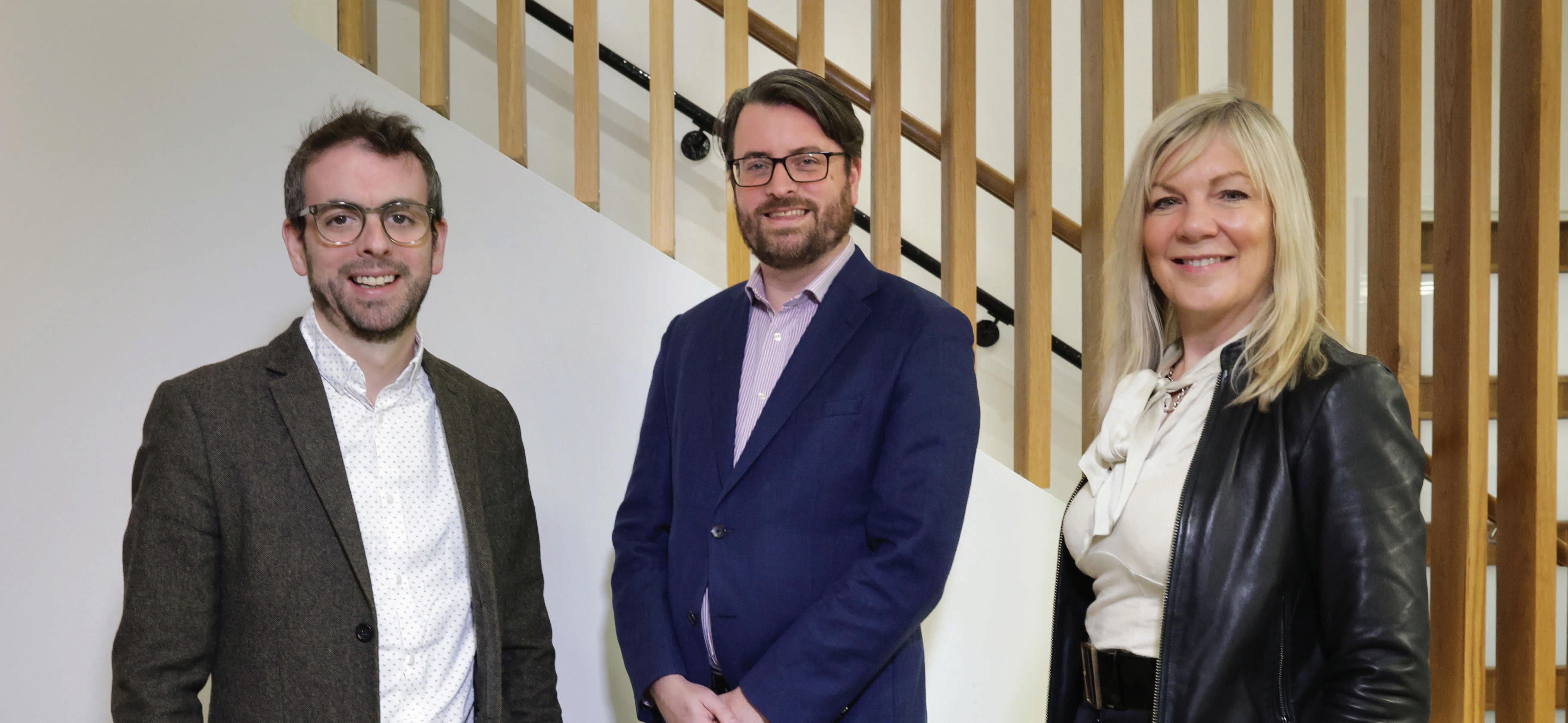
NI Chamber and Turley on why ‘swift action’ across all parts of the planning system is critical if Northern Ireland’s planning system is to become an enabler of economic growth.
With growing consensus across government and business about the need to deliver significant improvements to Northern Ireland’s planning system, earlier in 2024, NI Chamber and Turley published a comprehensive set of recommendations for the reform of the region’s planning system. The plans included a far-reaching combination of system improvements, legislative and regulatory changes and proposals, which would ensure that, in future, the planning system is held to account for its performance.
Designed to accelerate Northern Ireland’s progress towards net zero, facilitate economic growth, and deliver
much-needed affordable housing and infrastructure, the recommendations received broad political buy-in and since then, there have been some signs of progress. Now, the report’s authors say it is time to build on that momentum and pick up the pace in doing so.
Suzanne Wylie is the Chief Executive of Northern Ireland Chamber of Commerce and Industry, one of the region’s largest business representative organisations with more than 1,000 members across the province. She has real concerns about both how the planning system is functioning and the corresponding impact on investment across the region.
Planning permission for 1,500 vital new homes on the Skeoge Link Road was first granted to a private developer in 2016, after almost 11 and a half years in the planning system.
In 2023, Apex Housing Association began developing the land for social housing but, to redesign some of the homes to Housing Executive specifications, has had to re-engage with NI Water through the planning process and before commencing development.
Despite NI Water previously confirming capacity for the previous private permission, and work having commenced on 262 units in phase 1 east of the project, planned wastewater upgrades by NI Water have not been completed due to a lack of sufficient funding.
As a result, planning permission for the remainder of the homes is uncertain, and Apex are in the precarious position of either having to pause construction of phase one, or continue with the possibility of having completed homes with no water or sewage connections.
“An efficient and effective planning system is a key economic enabler for any economy but, for Northern Ireland right now, the system here remains one of the biggest issues facing businesses in a whole range of sectors. Certainty in the function and performance of planning is key to instil confidence in the market for potential investors and for local businesses alike. For too long now, the performance of the planning system here has been a deterrent rather than an enabler for investment and growth. If our planning process is to deliver for them and for our planet, we really do need to take action now, which is why we commissioned this report to act as a catalyst for real change.”
The report was prepared by planning consultants Turley, co-authored by Senior Director, Michael Gordon, Director Philip Stinson, and Head of Strategic Communications, John Davison. Michael Gordon sets out the context for the report’s recommendations.
“Planning is a complex area but many of the proposed improvements and solutions have already been proposed. This report was about prioritising the actions that we believe will have the most positive impacts for the economy as a whole.
“Following three significant reviews in 2022 by the Department for Infrastructure (DfI), the NI Audit Office (NIAO) and the Public Accounts Committee (PAC), there is broad agreement around the need and
“For too long now, the performance of the planning system here has been a deterrent rather than an enabler for investment and growth.”
Suzanne Wylie, Chief Executive of Northern Ireland Chamber of Commerce and Industry
steps required to deliver constructive improvement to the performance of the planning system, albeit that there are no quick fixes. This requires a blend of immediate actions, cultural and system improvements. Some will require additional financial resources, personnel and expertise across the whole system of local authorities, consultees and departments.”
Whilst retaining its independence from any government department, back in January 2024, NI Chamber and Turley recommended that the performance of the Planning Appeals Commission (PAC) should be reviewed by the NIAO, given its importance to the system.

Since then, the NIAO has announced that it will be undertaking a strategic review of the overall role and function of the PAC. That review includes consideration of the range of challenges currently facing the PAC and, crucially, the options available to improve performance and wider planning outcomes in Northern Ireland. The NIAO will report on its findings in the Spring of 2025.
The report also suggested that the Department for Infrastructure uses its existing legislative powers to appoint independent commissioners to address some specific requirements, including the independent examination of local development plans (LDPs). In a welcome development, in September 2024, Infrastructure Minister John O’Dowd MLA announced that he had also made a bid to fund the appointment of independent commissioners to alleviate pressures on the PAC.
One of the most significant recommendations related to funding the system is to ensure that the whole planning system is properly resourced, from the Department for Infrastructure to local councils, to statutory consultees and the Planning Appeals Commission. There has been more progress on this front too, with the Minister informing the Northern Ireland Assembly’s Infrastructure Committee that he has made a funding bid to the Executive Transformation Fund to resource statutory consultees in the handling of planning applications.
It also proposed the medium-term introduction of penalties for planning authorities and statutory bodies that fail to meet their statutory timeframes for the processing and determination of regionally significant and major planning applications, once other measures such as additional resources are put in place. This is in addition to a proposed restructure of the distribution of Planning Fees to incentivise the performance of statutory consultees; and introduce penalties for consultees who do not respond within agreed timeframes.
Significantly, the report also suggests that consideration should be given to identifying a more suited sponsor department for the Planning Appeals Commission, which achieves the right balance between priority setting and independence.
Lead author of the report, Philip Stinson, explains the urgent need for further improvement: “There has been some improvement in application processing times in the first quarter of this year, but this has happened in tandem with a significant fall in the overall number of major applications that local council authorities have had to determine – and on average they continue to far exceed the 30-week target. Whether this is because of reduced investor confidence, or constrained public sector funding for social housing, schools, and healthcare, the planning system remains a constraint rather than an enabler of critical infrastructure.
“This steep fall in applications is most significant in renewable energy, which make up the majority of regionally significant applications with the Department for Infrastructure. As we face into a deepening climate emergency and looming climate change obligations, last year processing times for renewable energy applications rose to almost a year, and often much longer for regionally significant proposals – and yet the number of new applications have reached an all-time low – a symptom if not a direct result of the complexity and unpredictability of the planning process. Many regionally significant proposals have not progressed through the planning system due to a backlog and resourcing issues within the Planning Appeals Commission – underlining the need for its review.
“The importance of planning improvement is recognised in the draft Programme for Government, but for planning transformation to occur greater momentum is required and it must be prioritised as the means to delivering critical infrastructure for a sustainable future.”
Following publication of the draft Programme for Government, NI Chamber has called for the introduction of an additional, tenth priority which is focused on enabling critical infrastructure such as transport, grid connectivity, upgrading Northern Ireland’s mobile network and most pressingly, the region’s ailing wastewater infrastructure.
Stuart Anderson, Director of Public Affairs at NI Chamber explains: “Constraints in
Northern Ireland’s existing funding models for public infrastructure are hampering our ability to deliver on housing, decarbonisation, and wider economic development.
“In combination with an inefficient planning system, our inadequate water treatment capacity is having an immediate impact on housing delivery this year, with 2024/25 anticipated to deliver the fewest new homes in Northern Ireland since World War II. There are also signs of more immediate environmental impacts, including those already seen in Lough Neagh.”
The NI Audit Office produced a report on the planning system in 2022, and NI Chamber and Turley prioritised many of its recommendations in its own paper. Whilst some progress has been made, improvement quickly needs to become transformation.
By the same token, in March 2024 the NIAO also called for a quick and ‘comprehensive review of alternative arrangements, led by suitably qualified experts’ to address how NI Water sustainably funds wastewater infrastructure. This urgent review must be considered as the Executive consults on its 2025/26 Budget.
Turley’s Head of Strategic Communications, John Davison, highlights the differing political urgency outside Northern Ireland: “Efforts to improve the planning system and wastewater infrastructure have been prioritised by the Irish Government with the recent consent of the Planning and Development Bill 2023, and through additional funding for Uisce Éireann for investment in wastewater treatment plants and upgraded infrastructure. The UK Government has made planning reform a key plank of tackling the housing crisis and stimulating economic growth. By contrast, we simply have not prioritised the physical infrastructure and policy framework that generates investment – we are in danger of falling further behind – and this will harm our competitiveness as a region.
“Simply put, the bureaucratic and intricate nature of planning policy is not glamourous, and we seldom think about the importance to our economy or the environment of the drains beneath our feet. However, if we look south and east, both these issues have never had greater political focus – and in the clamour of our Executive to promote housing, healthcare, environment, and

“We simply have not prioritised the physical infrastructure and policy framework that generates investment – we are in danger of falling further behind – and this will harm our competitiveness as a region.”
John Davison, Head of Strategic Communications, Turley
the economy our parties are in danger of ignoring the means by which these priorities can be delivered.”
From developing renewable energy to building sustainable and affordable housing, to improving our water quality, there is much that needs to be done at pace to enable the infrastructure we need for a sustainable future. A functional planning system is as foundational to this as the drains beneath our feet.
Planning transformation presents an opportunity to open the door to significant sustainable growth and unlock Northern Ireland’s pathway to a decarbonised economy and is vital to deliver the enabling infrastructure for industry,
economic growth, healthcare, education and new homes.
We know that most economic development begins with planning, and for that reason, the performance of our planning system must be competitive to attract and encourage investment.
Northern Ireland Chamber of Commerce and Industry
T: 028 9024 4113
E: mail@northernirelandchamber.com
W: www.northernirelandchamber.com
Turley
T: 028 9072 3900
E: michael.gordon@turley.co.uk
W: www.turley.co.uk


Ulster University lecturer in planning and development, Gavan Rafferty, explores the evolving role of planning in addressing public health, wellbeing, and liveability, using recent pilot projects in Belfast as case studies.
Rafferty’s project, which he conducted alongside Belfast City Council and other agencies, was inspired by the need to understand how health-centred, placebased interventions could reshape Belfast’s urban environment, especially in the wake of Covid-19 pandemic. His research aimed to promote a more vibrant, equitable, and sustainable city, addressing long-standing social, environmental, and infrastructural challenges.
Discussing the relationship between urban planning and public health, Rafferty notes that “the built environment begins to shape and influence us in our daily lives and our practices,” and that planning decisions affect not only physical surroundings but also “social wellbeing”. Further contextualising that, historically, urban planning has been centred on responded to health crises in cities, and today, health is increasingly a priority in planning systems across Ireland and Northern Ireland.
He adds that the Strategic Planning Policy Statement uniquely emphasises “improving health and wellbeing” as a core planning principle, underscoring a renewed commitment to using planning as a tool to enhance public health outcomes.

The pilot initiative of which Rafferty refers sought to analyse three Belfast-based interventions: the introduction of cycle lanes in the city centre, the regeneration of the Millennium Quarter (including social street life initiatives), and the revitalisation of the Cathedral Gardens.
Through these projects, he says that his team assessed how urban planning could support health and wellbeing, gather public feedback, and draw actionable insights to improve city liveability. This work, he adds, also revealed the complexity of defining and achieving “liveability”, especially in a city like Belfast, where health, transport, housing, and safety challenges intersect with the city’s unique sociopolitical history.
Rafferty outlines that the research found that a significant majority of survey respondents viewed health-promoting, liveable city spaces as essential. However, he states that, when asked if Belfast’s current infrastructure supports active and healthy lifestyles, the majority of respondents felt it “does very little in its current shape or form,” citing improvements in public transport, affordable housing, and climate action as urgent priorities.
He also notes that “liveability” encompasses “safe, attractive, inclusive, and environmentally sustainable places,” a definition that aligns well with health goals, Rafferty noted. However, he also says that translating this concept into planning policies and measurable outcomes remains challenging, noting that there is a need for more “cross-sectoral data sharing” to make “informed, health-centred planning decisions”.
Rafferty also states that, in Northern Ireland, limited data-sharing agreements and fragmented policies make it hard to monitor wellbeing outcomes and measure urban change, adding: “Effective liveability initiatives require interdepartmental coordination and the integration of health data.”
Rafferty offers several recommendations which he states can “overcome systemic barriers and promote liveability in towns and cities”.
The first recommendation is the adoption of a liveability lens in decision-making, clarifying that planners and policymakers should apply a liveability framework that prioritises public health, environmental sustainability, and social inclusivity, making these values central to urban planning
decisions. This approach, he states, could also “resonate more with the general public”, who he asserts would find the term “liveability” more relatable than abstract concepts like “sustainable development.”
Secondly, he recommends the formalisation of informal engagement practices, as one of the project’s key takeaways was the potential for more “co-produced, bottom-up approaches” to planning. Pointing to survey findings that “citizens felt they were not able to influence decisions,” Rafferty emphasises that integrating informal community engagement processes could enhance citizen input in planning, especially in Belfast city centre, where public participation in decision-making remains low.
Rafferty’s third recommendation is the promotion of cross-sector collaboration. Stressing the importance of “intersectional approaches” that involve collaboration between planning, health, transport, and housing agencies, he states that addressing Belfast’s health and liveability challenges “requires cooperation beyond the planning sector”. He also recommends improving data-sharing protocols, allowing more comprehensive analysis of urban wellbeing.
His fourth recommendation is prioritising health and wellbeing as planning outcomes. While economic growth and development remain key priorities in urban planning, Rafferty advocates elevating health and wellbeing outcomes “on a par with, if not above, economic outcomes”, suggesting that developing explicit health and wellbeing frameworks to guide planning decisions and measure their effectiveness. By focusing on health outcomes, he asserts that planners could work more effectively across disciplines, as health represents a common goal shared by multiple sectors.
Concluding, Rafferty acknowledges that achieving these goals requires patience, flexibility, and a willingness to re-examine established planning assumptions, further arguing that focusing on liveability allows planners to address multiple interconnected challenges, such as access to services, quality of housing, environmental sustainability, and social cohesion, in a way that is relevant to citizens’ everyday lives.
By embracing “outcome-based” planning frameworks, he says that planning in Northern Ireland could become more responsive to public needs, adapting urban spaces to support well-being as well as economic vitality.


The Judicial Review Court increasingly plays an important role in supervising Northern Ireland’s planning system. So, what is new in planning judicial review in 2024?
There has been a tendency to think that the test for granting leave or permission to bring a judicial review was the low hurdle of the points of challenge being arguable, regardless of whether they were likely to succeed at the substantive hearing, but the courts have stressed that the test is actually a dual one –“Leave should only be granted if the

court is satisfied that there is an arguable case having a realistic prospect of success” – Kinney J, Re McLaughlin, affirmed by the Court of Appeal in 2024.
In Re Glebe Homes Ltd, the applicant sought leave to challenge refusal of permission for two dwellings in
Hillsborough. Leave was refused because no arguable case with a realistic prospect of success had been made out, and in any event the challenger had the alternative remedy of appealing to the Planning Appeals Commission, which Humphreys J concluded was:
“... demonstrably more efficacious than judicial review. The latter could only result in a quashing of the planning decision and remittal back to the council for redetermination. The PAC... can allow the appeal and grant the planning application... the outcome desired by the applicant in a manner which is bound to be quicker and more cost effective. The PAC can weigh up material considerations and interpret planning policy in the same manner as the council.”
Something not always appreciated is that a planning decision being quashed does not reverse that decision but merely voids it, so that the matter is returned to the original decision-taker for redetermination. Importantly, redetermination must take place having regard to the material considerations in play at the point of redetermination, which are not necessarily the same considerations which were material at the time of the original decision. That was made clear by Humphreys J in Glebe Homes: “When a decision is quashed by a court and redetermined, the material considerations to be taken into account at the time of redetermination are those which exist at the date of the redetermination.”
Local Development Plan policy must be interpreted by reference to its aims and intent
In Belfast City Council v PAC, the challenge centred around decisions to refuse planning permission to enable retrospective change of use from residential to short term holiday let accommodation for two apartments at Citygate, Belfast. The PAC allowed the appeals against these decisions. The applicant sought to challenge that decision, arguing that it had misinterpreted the relevant planning policy. Humphreys J quashed the PAC’s decision, finding that it had misinterpreted policy HOU13 of the Council’s Plan Strategy when interpreting what the word ‘property’ meant:
“A word such as ‘property’ in a planning policy is to be given its ordinary, natural, commonsense meaning within the context of the policy itself. It does not require to be subjected to intense forensic analysis. The relevant context will be spelt out by the aims and justification of the policy itself... The policy aims to preserve properties in permanent residential use by requiring part of the property to be retained in that state. The only coherent interpretation of the word ‘property’ in this policy must be the individual dwelling, whether that be an apartment or a house... HOU13 (f) serves to further the aims of the strategy by ensuring that properties are kept in permanent residential use whilst parts of them can be let by the owners on a short-term basis. To find otherwise is to wholly ignore the stated aims and intent of the policy and thereby to defeat it.”
Policy in an emerging, unadopted Local Development Plan can be a material consideration, and can be given determining weight
Again in Glebe Homes, Humphreys J made it clear that, given regional planning policy including the oftenforgotten 2005 Joint Ministerial Statement, planning decision-takers could not only properly take into account emerging Local Development Plan policy which has not yet been adopted, but also where appropriate give it determining weight:
“Even when a decision maker is considering an application in light of an extant plan, the policies in an emerging plan can be taken into account and, indeed, may have determinative weight. This will particularly be so when the emerging plan is at an advanced stage of the process and no objections have been lodged to the particular proposal under consideration”.
Sometimes, decisions can be so unreasonable that the courts will quash them
In the No Gas Caverns case, the Court of Appeal quashed decisions by the Department of Agriculture, Environment and Rural Affairs to grant licences authorising the installation of a five million cubic metre underground gas cavern storage facility in Larne Lough. One of the successful grounds of challenge was that the first instance judge had wrongly concluded that the decisions were not decisions which had to be referred to the Executive Committee under the Northern Ireland Act 1998 and that the decisions did pass the threshold for referral of being significant, controversial, or crosscutting. Factors influencing that conclusion were that the Minister had not sought to explain why the project was not considered significant or controversial,
where on the face of it the decisions were of economic significance and of strategic significance in terms of energy security and supply, and where the decisions on the face of it conflicted with international and domestic climate change standards –“...it seems logical to us that given the climate commitments now enshrined in our law that decision makers on large scale projects such as this will have to consider and rationalise any convergence or divergence with those standards set in law”.


These cases – and all important local judicial review judgments dating back to the 1980’s – are discussed in the recently-published Planning Judicial Review in Northern Ireland, available from Planning Online www.planningonline.co.uk.
T: 078 6024 5324 E: william.orbinson@barlibrary.com W: www.williamorbinson.co.uk
From the Foreword to Planning Judicial Review in Northern Ireland, William Orbinson KC Legal Associate RTPI and Judge Fionnuala Anne Connolly, Royal Court of Guernsey, Planning Online 2024
“This text will be of much use to those involved in actual or anticipated judicial review challenges relating to planning decisions. The unique benefit is the comprehensive citation of case-law from the High Court and Court of Appeal in Northern Ireland, which is frequently featured in the major planning law texts by way of fleeting reference only, if at all. I wholeheartedly commend this publication... one which should be kept to hand by all who work in this field.”
The Honourable Mr Justice Scoffield

The Department for Infrastructure is considering whether a complete overhaul is needed of the Strategic Planning Policy Statement (SPPS) to ensure climate resilience is central to planning decisions across the region.
A consultation aiming to review and potentially revise the Strategic Planning Policy Statement (SPPS) to better address climate change was closed by the Department for Infrastructure (DfI) in March 2024.
Northern Ireland’s planning sector has increasingly felt the strain of outdated policies unable to keep pace with the intensifying climate crisis.
When the SPPS was established in
2015 it accounted for a form of sustainable development which is now widely accepted as outdated, given legally binding decarbonisation targets under the Climate Change (Northern Ireland) Act 2022.
In this context, policymakers are currently debating whether incremental adjustments within the SPPS will be sufficient, or if an overhaul is required to place climate resilience at the core of planning strategies.
The SPPS’s core principles –supporting health, economic growth, place-making, and environmental stewardship – are stated in the consultation document as potentially “remaining aspirational without enforceable standards that hold local councils and developers accountable to climate objectives”.
For example, while positive placemaking and design could promote low-
emission, resource-efficient buildings, the SPPS currently lacks the regulatory ‘teeth’ needed to enforce this. As climate impacts become more severe, there will be a need for enforceable, climate-oriented standards across all planning decisions with the objective of ensuring that short-term development benefits do not undermine long-term resilience.
Table one shows the four topics that are likely to see significant policy updates. However, minor updates may prove insufficient, with policymakers widely accepting that a more
integrated, ambitious approach to climate-resilient planning is needed. The SPPS could become a policy tool that actively drives Northern Ireland’s climate agenda, compelling planning authorities to align all development activities with sustainable, climateadaptive practices.
This Call for Evidence aims to redefine the SPPS not only as a planning document, but as a robust framework for climate resilience. By critically examining its principles and considering substantive reforms, DfI and stakeholders will be aiming to craft a
SPPS that genuinely supports climate and development goals.
However, without a commitment to bold, enforceable policies, the planning system may continue to face the same challenges, potentially leaving communities and ecosystems vulnerable.
Submissions for the consultation closed in March 2024, and no timeframe has been outlined for a decision.
Flooding poses one of the greatest threats to Northern Ireland’s infrastructure and communities. With projections suggesting a significant increase in flood-risk areas by 2080, existing SPPS guidelines that discourage development in floodplains may no longer suffice. Updating floodplain definitions to account for the latest climate projections is essential, but planners also need more proactive tools, such as mandatory sustainable drainage systems (SuDS) in new developments. Without more stringent, climate-adapted flood management policies, the SPPS risks allowing vulnerable developments to proceed unchecked, undermining long-term resilience and safety.
Decarbonising transportation
Rural development
The SPPS’s influence on transportation policy could also be pivotal for Northern Ireland’s netzero goals. While DfI’s upcoming Transport Strategy for Northern Ireland (TSNI) emphasises lowcarbon options, the SPPS should prioritise integrative policies that reduce car dependency, promote active travel, and incorporate public transport planning into land-use decisions. Current planning practices often facilitate car-centric development patterns, thus contradicting sustainability targets. If the SPPS continues to lag in transport integration, the planning system may inadvertently hinder efforts to reduce emissions, especially given that transport is the second-largest source of carbon emissions in the region.
The SPPS’s stance on countryside development is another area ripe for critical reassessment. Northern Ireland’s distinctive rural settlement pattern poses unique challenges in achieving climate goals, especially since rural development often requires extensive travel and has limited infrastructure for sustainable energy solutions. While the SPPS encourages clustering and reuse of rural buildings, a more stringent approach may be necessary to align rural planning with climate resilience, such as mandating low-impact building designs or renewable energy integration. Without tightening these guidelines, rural areas risk being left behind in the transition to a sustainable economy.
Biodiversity in planning considerations
The SPPS nominally supports ecosystem services, such as flood mitigation and biodiversity preservation, but these considerations often fall secondary to other planning priorities. Given that Northern Ireland has seen marked declines in biodiversity, it is essential that the SPPS adopts a more enforceable commitment to ecosystem protection. Climate-ready planning will need measurable, actionable requirements – such as mandatory green spaces in developments or biodiversity offsets – if it is to ensure that planning practices support environmental health and community wellbeing.


Helen
Harrison, Managing Director of Juno
Planning & Environmental Ltd, discusses the role of social value in the planning process.
The term ‘social value’ may seem like a recent addition to the narrative on public procurement in Northern Ireland, however, its roots can be traced back to the UK Public Services (Social Value Act) 2012. The Act requires commissioners of public services to consider how they can secure wider social, economic, and environmental benefits. A draft motion for a Social Value Act in Northern Ireland was signed by all parties in 2016, however, progress was stalled until the Department of Finance publication of ‘Procurement Policy Note 01/21’, which mandated that from June 2022, public procurement tenders must allocate a minimum of 10 per cent of the total award criteria to ‘social value’, applied against a number of thresholds
including construction contracts valued above £5.3 million.
So, what is social value? A decade on from the 2012 Act there are multiple definitions in circulation. The UK Green Buildings Council suggests that in the context of the built environment, “social value is created when buildings, places and infrastructure support and enhance environmental, economic and social wellbeing”, while the Institute of Civil Engineers identifies social value as “the additional, wider benefits that can be created by organisations and projects, for individuals, communities and local businesses”.

In the Northern Ireland context, the Strategic Investment Board (SIB) has the responsibility for overseeing the measurement of social value which “is about maximising the social, economic and environmental benefits through the public procurement process”, with four social value themes focused on employment and skills, supply chains, zero carbon and wellbeing. Contractors must deliver their social value plan across these themes and achieve a quantum of ‘social value points’ proportionate to the contract value. The points relate back to measurements such as hours of employment/training/volunteering. Points are not monetised, and early feedback suggests that it may be helpful to provide proxy values to give visibility to value of benefits in a similar way to the TOMs Framework published by the Social Value Portal.
So, what has this got to do with the planning process? To better understand this question, it is helpful to consider the project cycle of a public sector development project, and the principal stages starting with strategic brief/investment case/procurement of design and delivery teams stages, followed by design development/planning approvals/construction stages leading to operation and decommissioning. Whilst early alignment with government and departmental objectives provides the foundation stones for social value on a project, it is through the design, planning and construction stages that social value really comes to life as the design teams implement their social value plans which might include apprenticeships, training and volunteering, and project teams use the pre application public consultation
process to help identify social value priorities for communities and stakeholders. These social value priorities could include short term benefits or longer-term social value interventions to be carried though the construction stages and beyond. Social value requirements support the delivery of additional benefits and interventions which might otherwise not have been secured, making the public purse work harder to deliver positive societal impact.
Working on the Belfast Grand Central Station project, the team in Juno has had the privilege of working closely with Translink, Graham, Farrans Sacyr, Babcock, and the local communities in south and west Belfast for the past 10 years, as we all navigate our way through the opportunities and challenges of identifying and delivering meaningful social value benefits, whilst seeking to listen, learn, adapt and improve through the social value journey. Translink is to be commended for pioneering the concept of delivering social value on the BGSC project long before it became a requirement to do so.
The contractor teams have all exceeded their quota of required social value points, and for the Juno team overseeing social value reporting across the project and delivering social value with Babcock, there have been some stand out social value moments, with notable ones including the provision of new mobile classrooms at St Joseph’s Primary School, the cross-community Friendship Cup football tournament organised by Sandy Row Football Club, and community Meals on Wheels events. These visible community wellbeing activities complement a substantial number of social value activities and
interventions running in the background including over 20 events supporting training and employment opportunities, 60 education events, 50 community projects, arts and heritage activities engaging over 800 people and support for the local VCSE sector.
What comes next? Professional institutes such as ICE and RIBA offer training and practical toolkits for professionals engaging in social value, and councils such as Belfast City Council already have their own social value procurement policy and toolkit linked to the Belfast Agenda. Councils across the UK are seeking to formally embed social value into the local authority planning process with consideration being given to the inclusion of social value policies within local development plans, social value plans becoming a planning application validation requirement and the use of Section 106 legal agreements to secure the delivery of social value benefits.
Social value is not a panacea to solve all the challenges faced by local communities or to take on the work of public sector agencies, but it does shine a light on local issues and importantly introduces the link between public sector investment and wider public benefit.
Helen Harrison is Managing Director of Juno Planning & Environmental Ltd specialising in large scale regeneration and renewable energy projects and pioneering the embedding of social value into the planning process.
Contact: T: 028 90645 222 E: info@junoplanning.com W: www.junnoplanning.com


Northern Ireland continues to see an overall decline in planning applications when compared with figures of the previous financial year.
The region has also seen a reduction in decided applications but has seen an increase in the number of applications that were received. There have been a variety of events which has impacted on the planning and activity processing performance in Northern Ireland. Varying Covid restrictions which remained in place up until February 2022 inevitably haltered planning progress, some users did not have the accessibility to the planning system in January and February 2022, and there was a significant change in IT planning systems in June and December 2022, all of which contributed to the decline in planning statistics that were published in October 2024.
The findings come from the Department for Infrastructure’s (DfI) annual Northern Ireland Planning Statistics Bulletin. In Q1 of the 2023/2024 financial year, the region received 2,635 applications, but only received 2,538 applications in Q1 of the 2024/2025 financial year, marking a 4 per cent annual decrease.
There was also a 12 per cent decrease in the number of applications decided when comparing the first quarters of the two
previous financial years as well as a 13 per cent decrease in the number of applications approved.
These figures mark a continued trend from the previous financial year when there were 10,025 planning applications received during 2023/24, an 11 per cent decrease from the previous financial year.
Comparing Q1 In 2024/25 with the same period in 2023/24, eight of the 11 local councils reported a decrease in the number of applications decided, with the largest percentage decrease in Ards and North Down (-33.7 per cent). However, the remaining councils reported an increase over the year, with the greatest increase in Newry, Mourne and Down (8.7 per cent).
The bulletin also indicates that some local councils remain inconsistent in adhering to its statutory targets under the Planning Act 2011. One of the targets is for “each council to ensure that major development planning applications will be processed from the date

• Planning applications were down 4% during the same period in the last financial year
• 12% decrease in the number of applications decided
• 13% decrease in the number of applications approved
• 7.5% decrease in enforcement cases being concluded within 39 weeks
• 99% of planning applications are local
• 1% are major planning applications
Source: Northern Ireland Planning Statistics Bulletin
valid to the decision issued or withdrawal date, within an average of 30 weeks”.
The average processing time for major applications brought to a decision or withdrawal during the first three months of 2024/25 was 38.6 weeks across all councils. While exceeding the 30 week target, this represents a decrease of 21 weeks compared with the same period in 2023/24 (59.6 weeks).
Furthermore, it is a statutory target for each council to ensure that local development planning applications will be processed from the date valid to a decision issued or withdrawal date within an average of 15 weeks.
The average processing time for local applications brought to a decision or withdrawal during the first three months of 2024/25, was 19 weeks; this is the same time as recorded for the same period a year earlier and still exceeds the statutory target of 15 weeks.
Six of the 11 councils did not adhere to the 15week target after the first three months of 2024/25.
Another statutory target is to ensure that 70 per cent of all enforcement cases are dealt with by councils and are progressed to target conclusion within 39 weeks of receipt of a complaint.
Across all councils, 69.7 per cent of enforcement cases were concluded within 39 weeks during the first quarter of 2024/25, representing a decrease from the rate reported for the same period last year (77.2 per cent).
Like previous years, the region has failed to meet its planning targets but there some signs of improvement. While the processing time for planning applications remains around 19 weeks, only three councils met the 15 week target in 2023/24. Moreover, for enforcement cases, the region is projected to soon meet its target of dealing with 70 per cent of all enforcement cases come the next financial year.
Northern Ireland’s planning process is set for a significant enhancement following Infrastructure Minister John O’Dowd MLA’s recent announcement on legislative amendments.
The reforms, under the aegis of amendments to the Planning (General Development Procedure) Order (Northern Ireland) 2015, aim to empower councils to create and enforce planning application validation checklists, marking a strategic shift aimed at improving the quality and efficiency of planning applications.
The amendments to part of the Department for Infrastructure’s (DfI) ongoing Planning Improvement Programme, a comprehensive initiative aiming to streamline the planning system for greater reliability, efficiency, and inclusivity.
According to O’Dowd, this policy shift is designed to refine the planning process at its initial stages: “This move is designed to improve planning performance with better quality applications entering the system, resulting in shorter processing times, more efficient consultee responses and quicker planning decisions.
“I am committed to improving the planning process and these legislative amendments have been introduced as a result of the Department’s Planning Improvement Programme which is aimed at creating an efficient, effective and equitable planning system trusted to deliver high quality, sustainable, inclusive and healthy places,” he says.
The new checklists represent a structured approach which aim to clarify the types and levels of documentation needed for different

planning applications, tailored to the nature, scale, and location of each proposed development.
Although the foundational statutory requirements for planning submissions under the Planning Act 2011 remain unchanged, the checklists introduce an added layer of specific documentation requirements aligned with the complexity and impact of each project. Planning applications will now be deemed valid only if they meet these detailed requirements, as outlined in each council’s checklist.
By front-loading the application process with a more thorough validation step, councils anticipate smoother workflows and reduced back-and-forth on incomplete applications, which have traditionally delayed planning decisions. Additionally, it is hoped that consultees, who often provide essential feedback on applications, can expect to review better-prepared applications, leading to more effective collaboration and faster responses.
The changes reflect the Department’s objective, under the Planning Improvement Programme, of delivering a planning system that is efficient, effective, and equitable. The introduction of validation checklists underpins broader efforts to build a more transparent, sustainable, and trusted planning framework.
As councils prepare to implement these checklists, stakeholders across the planning sector will need to stay
informed and be ready to adapt to the new challenges and opportunities they present.
Speaking to agendaNi, Heather Ritchie, a lecturer in planning at the School of Natural and Built Environment at Queen’s University Belfast, says that the legislative provisions “shows DfI’s commitment to planning reforms in terms of frontloading the system and providing more certainty and efficiency in the planning process, so it should be celebrated”.
In terms of how this will affect the future of training planning professionals, Ritchie says that graduates “will be entering into the profession in this new PVC [cement] era” and that academics “are beginning to teach the students about the new changes in the planning law modules”.
“We are also exploring what might happen if we end up with potentially 11 different regimes in the LPAs, since there appears to be a degree of flexibility and autonomy of the LPAs to decide whether to adopt and if so, the contents of the PVC,” she adds.
“We are also looking at whether the decision of non-conformance and route to appeal, in the already over-burdened Planning Appeals Commission is an effective recourse. As ever, it will take time to bed in, but for our graduates it is important that they are aware that it is likely they will be working under this new regime whether they work in the public or private sector.”

Social Media Belfast 2024 took place on Tuesday 10 September at Titanic Belfast. Over 200 delegates attended the event, which took a deep dive into what social media will look like for 2024 and onwards. A highlight of the conference was showcasing successful social media campaigns from Northern Ireland and beyond. Delegates in attendance heard from speakers, both visiting and local, from organisations including LADbible Group; daa; UN Women; WWF; Kingsbridge Healthcare Group; and Visit Armagh.
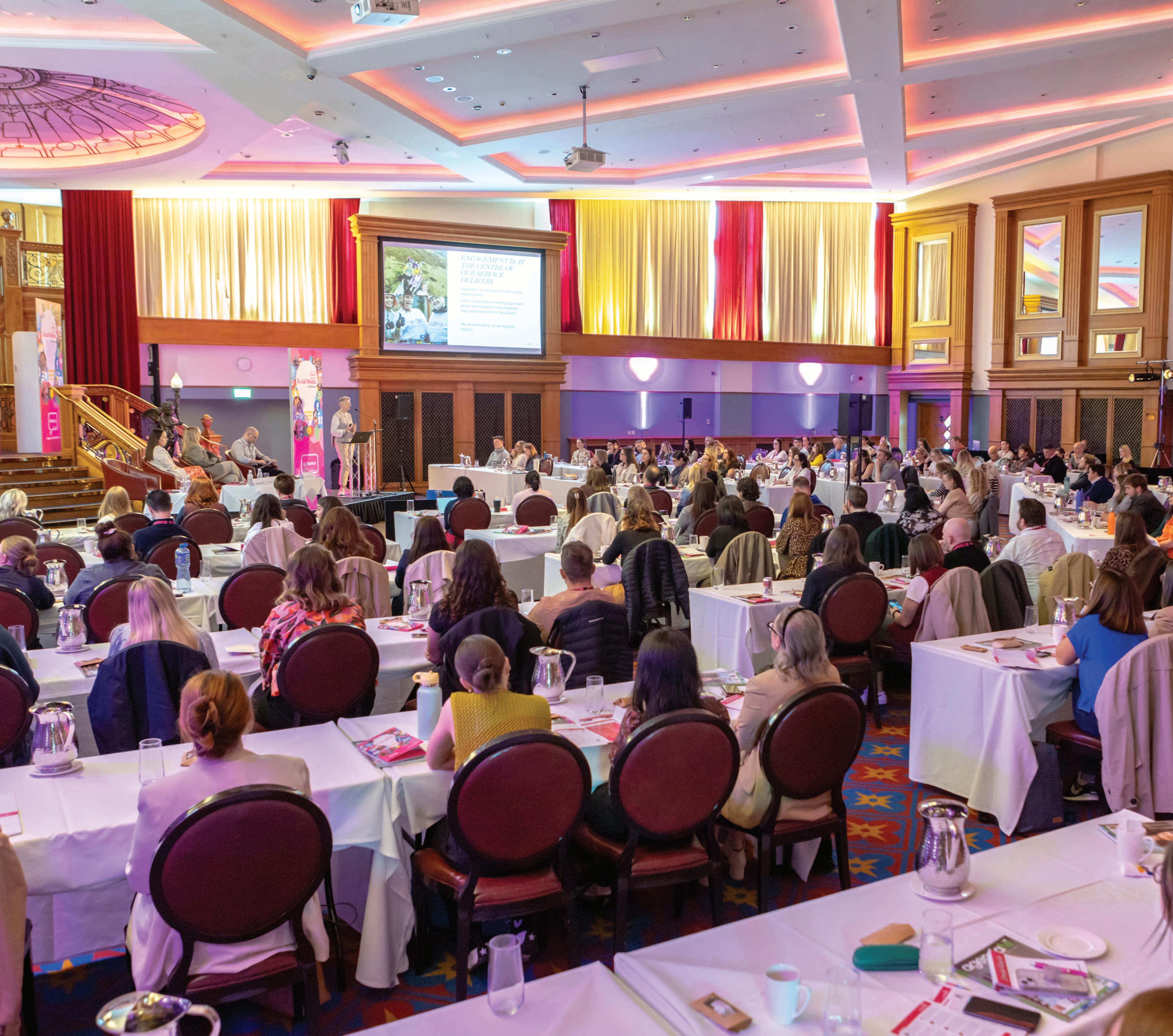







With three years left in the Assembly mandate, all but one of the five main parties held their annual conferences in September and October 2024. It has been a year which has seen three parties change leader alongside a dramatic Westminster election. Having attended the party conferences, agendaNi explores the state of Northern Ireland’s parties.
Back in 2014, Gerry Adams said that the Sinn Féin strategy was for “equality” to be the “trojan horse of the entire republican strategy”, with the objective of winning power north and south and gaining respectability among the Irish establishment.
While this project has succeeded thus far in the North, where Michelle O’Neill leads the Executive and stands as the most popular political leader on the island of Ireland, according to polling, the task of turning the tide and winning the general election in the South, scheduled for 29 November 2024, remains a tall order.
Following extremely disappointing results in the Republic’s 2024 local elections, as well as somewhat less disappointing results in the European elections, the question of Mary Lou McDonald’s leadership may well be in question if she fails to propel the party into government in the
Republic, something which was a key goal for past republican leaders when they decided to make her Adams’ successor.
Internally, the momentum of the Sinn Féin pendulum, as illustrated by attendance at the party’s ard fheis, which took place in Athlone, County Westmeath – in the same venue and, ironically, with the exact same theme (‘time for change’) as its 2023 ard fheis – on 28 September 2024, has swung back to Belfast and away from Dublin. Several delegates, including an MLA, a councillor, and a party activist commented privately on greatly reduced numbers this year.
This belies the fact that this should be the most significant opportunity in the party’s history, at least since 1981; being the final ard fheis ahead of a general election campaign in the Republic in which the party seeks to offer a viable alternative to the Fine Gael/Fianna Fáil duopoly.


Sinn Féin re-elects its Ard Comhairle at every ard fheis. When McDonald was formally re-elected as party president, there was a comparably muted reaction from the crowd compared to the that of party vice-president Michelle O’Neill MLA, who has led the party to unrivalled success in the North, leading in local government, Stormont, and among Northern Ireland’s MPs.
As this was happening, Sinn Féin leadership was in the process of removing two press officers who had provided professional references to former Sinn Féin press officer and convicted child sex offender Michael McMonagle, something which McDonald and O’Neill have said took place without the party’s approval.
One veteran MLA agreed that the position of the party in the south is below what was expected one-year prior, but was adamant that there is still a chance that the party can turn the tide.
“We were in a much worse position before the last [general] election and did better than we ever thought we could at the time,” the MLA told agendaNi, adding their full belief that “she [Mary Lou McDonald] can turn this around”.
However, if Sinn Féin falls short in the election, it is entirely plausible that there will be a new party leader, marking a major inflection point in a decades-long project choreographed by past republican leaders of ascending to government in the
Republic, leading the Executive in the North, and using this combined power base to unite Ireland.
For the DUP, 2024 has been arguably its most challenging year since the passage of the Good Friday Agreement. Just 54 days after the DUP was led back into the Executive under Jeffrey Donaldson’s leadership, the party was rocked by the emergence that he was to face court over a series of charges of alleged historical abuse.
Propelled into party leadership in a sudden manner, party leader Gavin Robinson MP led the party into the July 2024 UK general election, which produced the party’s worst Westminster election results since 1997. Robinson was, however, successful in his own re-election bid, seeing off Alliance Party leader Naomi Long MLA in east Belfast.
The party’s conference, which took place in south Belfast on 21 September 2024 –in the same venue as 2023 –demonstrated three things.
Firstly, there is clear good will from all sections of the party towards Robinson, who is admired and respected almost without exception for stepping up to lead the party following Donaldson’s resignation.
Secondly, the party sees the promotion of new faces as key to the party’s long-term sustainability, with younger MLAs such as Jonathan Buckley, Cheryl Brownlee, Joanne Bunting, and Deborah Erskine being given prominent speaking slots at the conference. In a complete reversal from the 2023 conference – the party’s veteran Westminster MPs were abesnt from the main stage.
Thirdly, the party has no desire to collapse the Executive again in the near future, with a party insider telling agendaNi that they believe the worst of the threat posed by Jim Allister’s TUV has been seen off, and the party’s role in leading its Executive departments being promoted as a key aspect in how it will connect with local communities and ensure electoral success.
Taking the stage to an enthusiastic applause, Robinson’s speech struck a consciously banal tone, with the new leader keen to project messages of strength and humility, reaffirming his support for the union with Britain, and attacking the new Labour government in London.
“If the first two months of their tenure has shown us anything, it is that such strength will not always be used for good,” he said, pointing to the removal of the winer fuel allowance, and perceived inequality over Labour’s support for victims during the conflict.


Robinson also reflected on where the party stands, acknowledging that the general election results were “disappointing” and that the DUP needs to rebuild. Robinson analogised: “If the message of Easter reminds us of anything, it is that the darkness of Good Friday has passed; we do not live in the shadows of yesterday but walk in the light of today and for the hope of tomorrow.”
Following his speech, in what was expected to be a general message of appreciation for Robinson, party chairman Maurice Morrow, after ambiguously referencing the “extenuating circumstances” which plagued the DUP’s poor general election campaign, led the tributes, affirming his and the party’s support for the leadership in “the most difficult of circumstances”.
Referring to the immediate aftermath of Donaldson’s resignation, Morrow said: “I do remember that fateful Saturday morning when we met as party officers… Our deputy leader then, Gavin, was asked a straight question: will you take over the mantle? I was the one that asked him. He said: ‘If this party asks me to do it, I will do it.’”
Reflecting that the DUP faithful “used to look up to a certain big fella”, Morrow
then said that the party was lucky to have “another big fella” and stated that he would continue to have support from the whole party.
The spectre of the previous leader clearly continues to haunt the DUP, and the party faces an enormous task in gaining back support it has lost in recent years.
However, with an apparent ‘Robinson rally’, the youngest party leader in Northern Ireland has the space to be decisive in breaking with the old leadership style in the DUP, and will aim to promote new voices.
After the end of Doug Beattie experiment of liberal unionism, the UUP conference –the first conference held since 2021 –oversaw the ratification of Mike Nesbitt MLA as the party leader, seven years after he resigned from the role.
Nesbitt is the fourth leader to assume the job since his ‘vote Mike, get Colum’ election campaign which saw the party reduced from 16 to 10 seats in the Assembly.
While Nesbitt was ratified unanimously as the new leader, his first party conference was little short of disastrous. Firstly, he
contracted Covid-19 in the days prior to the event, which meant that he was not able to make his leader’s speech in person. Secondly, only around 160 people were in attendance at the same venue that hosted the DUP conference the week prior.
In an awkward speech, characterised by a lack of applause due to technical challenges in his remote address, Nesbitt said that he was “not going to dwell on the whys and wherefores of what happened”, regarding Beattie’s resignation, adding: “What I do say publicly is this, thank you, Doug.”
Nesbitt also made clear that he plans to continue Beattie’s liberalism, stating: “We should embrace a diverse, multicultural society, in the same way we must play our part in developing cross-party, crossdepartmental politics.”
Nesbitt’s return can be viewed positively from the UUP’s perspective. His personal popularity is boosted by an executive protfolio.
However, the fact that his first leadership spell is widely perceived as a failure, and the fact that his return to the leadership was largely perceived as due to the fact that most of the party’s senior figures have already unsucessfully served as


leader, hints at continued stagnation for Northern Ireland’s oldest and founding party.
The SDLP conference, also held at the same south Belfast venue as the DUP and UUP conferences, saw a leadership change, as Colum Eastwood MP bowed out from the top of the party he has led since 2015. On 5 October 2024, Claire Hanna assumed the role that many believe she has been working towards for a many years.
The SDLP conference, after what had been a dull day marked by poor attendance, exploded into life upon Hanna’s entry to the stage, and was markedly more energetic than the two conferences which took place in the same venue in the two weeks prior.
In line with the conference theme, ‘build something new’, Hanna made it clear during her inaugural leader’s speech that the SDLP must redefine itself, stating that it “has been a bit stuck”, and adding: “Our job isn’t to teach people how great John Hume and Seamus Mallon were, our job it to make people feel the way the way they made people feel.”
She was also reflective, conceding that while the SDLP “has no divine right to exist… the SDLP’s politics has value, it has a purpose, it has a future.” She also reiterated that social democracy is the party’s ideology and insisted that support for Irish unity will not wain under her leadership.
In spite of the conscious move away from the past, the
party made a surprising move at this conference, anointing party stalwart Bríd Rodgers as the party’s president, making her the first person since John Hume to be granted the title ‘president of the SDLP’.
In spite of speculation prior to the conference, there was no sign of the former Taoiseach Leo Varadkar TD, although former party leaders Mark Durkan and Margaret Ritchie – in spite of her apparently expulsion from the party upon taking a seat in the House of lords – were present, along with former north Belfast MLA Alban Maginness, who energised the room momentarily when he spoke on the need for a campaign to save Lough Neagh.
In a subsequent interview with agendaNi, Hanna has said that she is realistic about the party’s prospects. However, there is precedent for her to be successful given her strong electoral record in south Belfast, allied with the fact that the electorate of Northern Ireland have demonstrated an affinity with female leaders.
The SDLP’s challenge is that it has already declined so comprehensively that becoming a party of significance once again will be an extremely tall order. The main hope for the party is that Hanna’s success in south Belfast –an area where the party’s electoral performances have been considerably stronger than other traditional strongholds such as Derry and south Down – can be replicated as Hanna becomes even more of a household figure for the Northern Ireland electorate.


From her refusal to tow the party line during Brexit votes, to her controversial views on LGBT+ issues, Tonia Antoniazzi MP, the new chair of the NIAC has proven to be an independent minded and intransigent politician.
A former languages teacher and professional rugby union player for the Wales national team, Antoniazzi first came to prominence in 2018 for rebelling against her former party leader Jeremy Corbyn MP when the former Labour leader whipped his MPs to abstain on a vote to staying in the European Economic Area (EEA), which would have meant staying in the European Union’s single market.
Elected unexpectedly in 2017 to represent Gower in Westminster amid an initial surge of support for Labour under Corbyn’s leadership. She was appointed as a Parliamentary Private Secretary (PPS) to the then Shadow Secretary of State for Northern Ireland, Owen Smith in 2017, before serving as PPS to the Welsh Secretary in 2018.
In her three years in the political wilderness, Antoniazzi made headlines for
demanding in the House of Commons, when making a statement on 5G, that English health officials state that “all radio frequency signals are a possible human carcinogen”.
Antoniazzi has also been accused of “trying to erase official commentary about how bad [UK transphobia is] is”, by trans rights activists after she said it was “not relevant” to include the UK among other countries where LGBT+ rights have been under attack during an international resolution on anti-LGBT+ hate.
Antoniazzi resigned as a Labour PPS again in December 2020, returning to the backbenches after party leader Keir Starmer MP instructed his MPs to vote in favour of then-Prime Minister Boris Johnson’s European Union (Future Relationship) Bill. However, she returned to the shadow front bench in 2021, serving as a shadow junior Northern Ireland minister, and as a shadow junior whip between 2021 up to the 2024 general election.
Labour’s election to government in July 2024, however, did not bear the fruit of a frontbench appointment for Antoniazzi, who was instead elected unopposed to chair the Northern Ireland Affairs Committee.
As chair of the NIAC, Antoniazzi along with the other 12 members of the committee will examine the expenditure, administration and policy of the Northern Ireland office and its associated public bodies. DUP leader Gavin Robinson MP, the SDLP leader Claire Hanna MP, and Alliance MP Sorcha Eastwood are among the members.
Speaking after her election to the committee, Antoniazzi stated: “It is a privilege to have been entrusted by my fellow members with chairing the NIAC. I look forward to working with parties from across the political spectrum to ensure the issues that matter are properly scrutinises in the interests of all communities in Northern Ireland.”

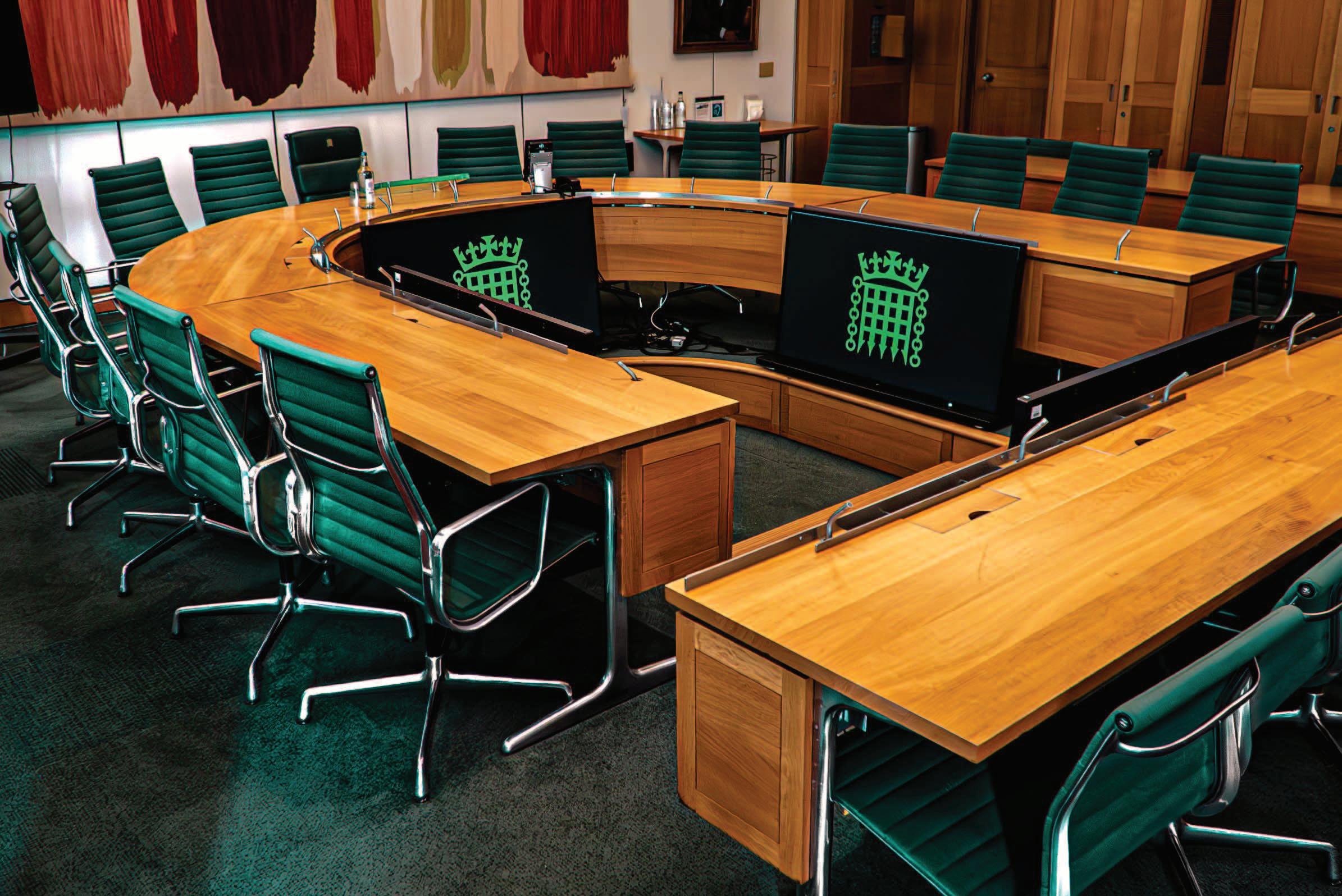
Only three of Northern Ireland’s 18 MPs are to sit on House of Commons select committees, all on the Northern Ireland Affairs Committee.
With the exception of DUP leader Gavin Robinson MP, SDLP leader Claire Hanna MP, and Alliance’s Sorcha Eastwood MP sitting on the Northern Ireland Affairs Committee (NIAC), the 15 other MPs (Sinn Féin’s seven MPs abstain from all Westminster committees), will not sit on any select committees.
Select committees work in both the House of Commons and the House of Lords, checking and reporting on areas ranging from the work of government departments to economic affairs. They run inquiries on specific topics, with the outcomes being presented to the public and require a response by the UK Government to their findings.
Members of most select committees, including departmental select committees, are nominated by a motion
put before the House of Commons, normally by the Committee of Selection. Since 2010, select committees have consisted of 11 members, but some have been expanded to 13 members to ensure that there is minor party representation and that committees also feature a healthy representation of members from Scotland, Wales, and Northern Ireland.
It is uncommon for most Northern Ireland MPs (excluding Sinn Féin) to not feature on select committees. Current DUP MPs Gregory Campbell, Jim Shannon, and Sammy Wilson, who have sat on the Westminster backbenches for a combined 51 years, have all featured on various subcommittees as recently as May 2024.
There has been a precedent for both newly elected and reelected MPs from
the region to sit on the NIAC, but with the a record number of Northern Ireland parties (six plus an independent) winning representation in the House of Commons, some politicians have raised their ire over the lack of Northern Ireland representation of select committees.
Alex Easton MP told agendaNi that he had asked to sit on the NIAC, but that he was “totally ignored”, having emailed all the whips of all the main parties and the whip party offices. Jim Allister MP told agendaNi that he also sought to obtain a place on the NIAC and accused the UK Parliament of taking a decision to “sideline unionism”.
Allister added: “It is a shame that MPs from Northern Ireland have not made it on to any other select committees as these are important forums in which issues pertaining to the whole UK are discussed.”
Sammy Wilson MP also told agendaNi that he expressed his interest to serve on the Energy and Net Zero Committee, saying: “I would have thought it would have been helpful to have Northern Ireland representation on some of those committees.”


Faced with a once in a generation opportunity to forge a more sustainable path for the environment, targets in law for nature’s restoration are long overdue, write RSPB’s Joanne Sherwood and John Martin.
Joanne Sherwood
Two experiences play large in my mind. The first, when three generations of a farming family beamed as they heard the call of a Curlew nesting on their land for the first time, thanks to their land management efforts. The second, when a gentleman overhears me talking about Rathlin’s Corncrake and does an about turn to tell me that he recalls hearing Corncrake near Belvoir in south Belfast in the mid-60s. Both Corncrake and Curlew were once common in Northern Ireland, evidenced by the way they are woven through the stories, poetry, art, and songs of this place.
Now in small numbers, they are mostly confined to ‘geographical hotspots’ of the Lough Erne and Antrim Plateau for breeding Curlew, and Rathlin for Corncrake. That is thanks only to farmers and conservation
charities working together, supported with the right government funded schemes. Has relying on ‘hope’ and ‘charitable good will’ been enough to save nature in an incoherent policy landscape that includes a loose statutory duty on public bodies to conserve biodiversity? The certain answer is no.
If we want future generations to thrive and benefit from the essential services that nature provides – from clean air and water and food to raw materials for manufacturing and leisure opportunities – we need to do something different and quickly at that.
John Martin
The summers of 2023 and 2024 put Northern Ireland back into the headlines, but not necessarily for the right reasons. The explosion of blue green algae in Lough Neagh – the result of wet winters and springs



“As good and as important as strategies are, non–binding targets have failed, leaving Northern Ireland’s environment in a poor state.”
flushing agricultural runoff, domestic, and industrial pollution into the lough, which was then activated by a warm May and June. A perfect storm perhaps, but, a signal from our environment on the neglect of one of Northern Ireland’s most highly protected places.
The new DAERA Minister, Andrew Muir MLA, has rightly prioritised action on Lough Neagh and delivered a 37point action plan, evidence that current environmental governance has failed to protect the lough for present and future generations. The Minister is also correct to use tempered public rhetoric on the timeframes involved in restoring the lough. No quick fixes are available, and this will be a challenge over decades instead of years.
The result of a recent Biodiversity Intactness Index should give us further pause for thought. The index is a tool for assessing the amount of nature a country has lost over time, and it placed Northern Ireland 12th and Ireland 13th from bottom. Out of 240 countries, that is 228th and 227th, the lowest in the G7.
The most recent State of Nature report also showed that in Northern Ireland, 12 per cent of species assessed are now at risk of extinction. Some examples include 97 per cent of wildflower meadows lost in the last 50 years and species such as the basking shark, the Irish damselfly, the freshwater pearl mussel and puffin at risk of extinction. In October 2024, the Office for Environmental Protection (OEP) published a report in Northern Ireland, concluding that current pressures on nature are unsustainable and urgent action is needed to protect and improve the environment for this and future generations.
This begs the question: Are we happy enough to suppose that future generations will only see once local species in storybooks?
The DAERA Minister alone has a number of hugely significant statutory deadlines to meet which could help turn some of these declines around. Northern Ireland’s first Environmental Improvement Plan has just received Northern Ireland Executive approval which is to be welcomed. However, The Climate Change Act has also had a number of deadlines missed (June 2024), such as publishing departmental climate action plans, consulting
on the role of a climate commissioner, and putting plans in place for a just transition. The seabird conservation strategy consultation has just been published, but we await the peatland strategy, nature recovery strategy, green growth strategy, and the implementation of a new agricultural policy.
However, as good and as important as strategies are, non–binding targets have failed, leaving Northern Ireland’s environment in a poor state. It begs the question: Is it time for targets in law for nature’s restoration? The answer is inevitably yes, and long overdue.
The Environment Act in England brought forward six legally binding targets to:
1) halt the decline in species populations by 2030;
2) restore water bodies;
3) increase tree planting;
4) halve waste;
5) reduce air pollution; and
6) restore marine protected areas.
Wales are currently working on a white paper setting out proposals for a new statutory nature recovery framework and the introduction of legally binding nature targets in Scotland was an element of the Natural Environment Bill due to come forward in late 2024. The EU is also close to bringing forward the Nature Restoration Directive which will be applicable in Ireland.
As we edge closer to the 2030 deadline to halt biodiversity loss, we need strong political leadership and ambition to match that challenge. The Northern Ireland Assembly has a once in a generation opportunity to set us on a more sustainable path and future generations, our economy and our nature will thank us for it.
Will they take it? I certainly hope so.
Joanne Sherwood is Director RSPB Northern Ireland and John Martin is Head of Policy and Advocacy.


A universal north-south travel card, free access to the health services, the end of religious patronage in schools, and maintaining an all-island minimum standard of living for children, are among the aspirations of Ireland’s first Shared Island Youth Forum.
Comprising of 80 civic young leaders from diverse backgrounds, all of whom were born after the Good Friday Agreement, the forum’s representatives were nominated by a wide range of community organisations north and south.
Having already met nine times in 2024 to deliberate and agree on a statement of their vision and values for the future of the island, the forum’s Vision and Values for a Shared Future on the island of Ireland sets out aspirations on themes of sustainability, opportunity, wellbeing, culture and identity, and equality.

Alongside high level and broad aspirations including that the Irish Government should invest in renewable energy technologies and support infrastructure to facilitate the transition to carbon neutral transport networks, the forum also calls on the Irish Government to establish “stronger north-south cooperation and pooling of resources between environment and energy departments”, as well as “more inclusive, all-island civic dialogue to inform climate action policy through existing channels and a new all-island forum”.


The young leaders also indicate that environmental education be “seamlessly integrated” into education systems across the island to educated Ireland’s youth about the threat of climate change.
As part of their Vision of Opportunity, the leaders aspire for every person to have access to “free, public and inclusive education, equitable opportunities in employment, and safe, secure housing”.
The Youth Forum has advised both the Irish Government and the Northern Ireland Executive to invest in an all-island travel scheme and increased transport connectivity between existing rail and bus services.
The Youth Forum has suggested that an ease of travel across the island, supported by a universal north-south travel card that is compatible on all modes of public transport can help facilitate young people pursuing more opportunities of a cross border basis.
Included in those aspirations most likely to stoke debate are calls to join up the health services on the island, with resources shared “at every level” across the island, while provision is made for “conscientious objection” for healthcare workers.
Additionally, the Youth Forum call for a standardised and consistent provision of “inclusive and evidence-based relationship and sexuality education” in schools.
The leaders have emphasised the need for a greater understanding of Ireland’s shared history.
They have called for a reform of the history syllabus, North and South, which includes perspectives of nationalists, unionists, and other traditions of the island.
The syllabus will also embolden underrepresented voices of women, migrants, the Traveller community, Roma community and other minority groups.
Moreover, the young leaders have called for a demilitarised mural culture in Northern Ireland and across the island, and encourage a spirit of crosscommunity artistic outputs, develop a strategy to educate the public on the history of murals, and to preserve and promote mural art.
As part of the Youth Forum’s Vision of Equality, the young leaders have called for the Irish Government and the Executive to educate and
engage young people on politics from an early age in school and extend voting rights to over16s and all residents.
Other reforms proposed in the education sector include the removal of religious patronage and end of selective schools, transferring all grammar schools to high schools.
Reform of the school curricula and teacher training for greater consistency has been proposed, as has “equality of access for education systems north/south”, particularly aimed at the UCAS and CAO systems.
For social housing, the Youth Forum statements suggest that the Irish Government and Executive ease planning requirements for modular housing, increase supply and ease access to social housing across the island.
The leaders suggest that the Executive remove the child benefit cap and base social welfare benefits on maintaining an all-island minimum standard of living for children.
The opinions and aspirations have been praised by the leadership of the Irish Government.
Speaking at Dublin Castle, in front of over 250 civic representatives from across the island, Taoiseach Simon Harris TD, said that the forum will provide a future where “no matter what, all communities feel accepted and at home”.
“The Youth Forum’s work will inform and inspire how we develop the Shared Island Initiative and how all… work for a shared, reconciled society on this island,” he says.
“There is an opportunity now to seize the moment and harness the hope, energy and ambition that is reflected in the Youth Forum’s vision, values and actions.”
Harris paid tribute to the forum members for participating, as well as the National Youth Council and Youth Action Northern Ireland for their continued support with the Shared Island Unit.
SDLP MLA Justin McNulty also welcomed the youth forum’s vision for a shared future stating:
“The vision statement from the Shared Island Youth Forum offers a clear pathway to building a truly reconciled island, where everyone, regardless of background, feels they belong.
“Their efforts should serve as a guiding light for all of us as we work towards creating a new and shared Ireland, rooted in the principles of the Good Friday Agreement.”

The economic ambition to create more ‘good jobs’ requires a statutory presumption that all individuals will qualify as ‘worker’ under the new definition of a ‘worker’, writes the ICTU’s John O’Farrell.
In the days before Labour’s first Budget, there was an unusual focus in the Tory press on membership of the working class, far from the way in which working people are traditionally portrayed in those UK newspapers, as skivers and strikers.
First in the queue for the status of lucky proletarians were, naturally, landlords whining to the Daily Mail: “Landlords in Britain labelled Sir Keir Stamer ‘insulting’ and ‘out of touch’ today after he suggested they do not count as ‘working people’ ahead of the Budget.”
The comments on MailOnline were instructive: ‘I’m a landlord, and work five days a week on minimum wage in a school. What am I?’
Answer: You are a badly paid education worker and you also have a side gig as a landlord.
Like many since 2010, landlords have benefited from
the focus on ‘rentiers’ at the expense of workers. The former include people who earn income from capital without working, generally done through ownership of assets that generate yield (cash generated by assets), such as rental properties, shares in dividend paying companies, or bonds that pay interest.
A ‘worker’ by contrast, is defined by the UK Government as having a contract or other arrangement to do work or services personally for a for money or a benefit in kind, for example, the promise of a contract or future work. They make things or provide a service and get paid for that. In additional contrast, they tend to pay a higher proportion of taxes and national insurance than landlords or shareholders.
We also have a clear breakdown of who is classified as a ‘worker’ by the Annual Survey of Hours and Earnings, which is the most detailed source of



“All workers should benefit from the same employment rights, including protection from unfair dismissal, by creating a single ‘worker’ status for all but the genuinely self-employed.”
John O’Farrell
information on earnings levels, distribution of earnings, make-up of earnings, and paid hours worked. It tells us the occupations which are most remunerated (corporate managers, directors, education professionals and business/media/public service professionals are the top three groups) and also the highest paid sectors (electricity/energy supply, telecommunications, and education).
At the other end of the earnings spectrum, many workers still earn below the real living wage, especially in sectors like accommodation and food services. According to the Nevin Economic Research Institute: “This highlights a disconnect between wage growth and the rising costs of living, particularly for essentials like housing and food. Vulnerable groups, such as part-time workers, young people, and women, continue to face high rates of low pay, indicating a need for targeted interventions. The data also reveal a decoupling between the proportion below the real living wage and the proportion below the median and emphasises the importance of considering changes in the costs of essential goods and services.”
Who are we talking about? The percentages of workers by occupation who are paid below the real living wage tell their own story: sales and customer Service (60 per cent); elementary occupations (55 per cent); arts and entertainment (43 per cent); administration and secretarial (25 per cent); caring
The forthcoming NI Employment Act can also clarify the definition of who is a worker. The labour market in recent years has been marked not only by low pay, but the precarious status of thousands of working people due to a one-sided ‘flexibility’, which allows some egregious behaviour by too many employers. In our submission to the Department for the Economy on the ‘good jobs’ bill, we addressed the anomaly in our employment law which recognises three types of employment status: ‘employees’, ‘self-employed contractors’, and ‘workers’.
All workers should benefit from the same employment rights, including protection from unfair dismissal, by creating a single ‘worker’ status for all but the genuinely self-employed. Create a statutory presumption that all individuals will qualify as ‘worker’ under the new definition.
These workers deserve ‘day one’ employment rights. We must remove the arbitrary and unfair qualifying time periods that restrict access to employment rights, particularly for insecure workers. That those in self-employment, whilst not qualifying for full employment protection, should still benefit from an improved safety-net of workrelated benefits, including statutory maternity, paternity and adoption pay, statutory sick pay, and auto-enrolment into pensions.
In order to see improvements for workers, it is useful to be clear of whom we are talking about.



Brian Kingston was first elected to the Northern Ireland Assembly in 2022. The north Belfast MLA tells agendaNi about how community work led him into politics, his admiration for Nigel Dodds, Gavin Robinson, and Matthew O’Toole, and his goal to complete the feat of running all six World Marathon Majors.
Outline your background and career to date
I grew up in south Belfast, going to Methody and then Manchester University. Returning to Northern Ireland, I did a year’s voluntary work at the Corrymeela Centre, followed by 20 years working for community groups in north and west Belfast, where I have lived since 1988. This included seven years as the founding manager of the Shankill Mirror community newspaper, as well as working in Rathcoole and upper Ardoyne.
After commencing work for Nigel Dodds, I became a DUP councillor for the Court (Greater Shankill) area for 12 years, including three years as DUP group leader on Belfast City Council and a fantastic year as Lord Mayor of Belfast in 2016/2017. I was elected as a DUP MLA for north Belfast in 2022 along with Phillip Brett.
What inspired you to get into politics?
Community work – including running a community newspaper – is a good background for moving into politics as it involves such a wide range of issues, and a similar


motivation to make a positive difference and to represent people well.
In 2008, the opportunity arose to work for north Belfast MP Nigel Dodds as a communications officer, which I was very pleased to do, as a committed unionist and a DUP supporter. Within two years I had been co-opted onto Belfast City Council as a DUP councillor.
Who do you admire in politics or public life?
It was a privilege to work for Nigel Dodds and to learn from him. I also admire Gavin Robinson who joined Belfast City Council just a month before me and has gone on to become an MP and party leader, stepping up in difficult circumstances and providing steady leadership.
Outside of my own party, I admire people who can speak well without notes such as Matthew O’Toole.
What drew you to the Democratic Unionist Party?
I had always been a committed unionist in the years before I joined the DUP. In 2008, I was impressed by the political leadership it was providing for the unionist community in securing the St Andrews Agreement and restoring the Northern Ireland Assembly. Also, its work on the ground in north Belfast and greater Shankill area.
What are your key priorities for north Belfast?
1. to assist constituents with their individual matters of concern;
2. to help deliver new social and private housing developments;
3. to ensure that statutory funding is delivered for physical improvements and support services in the area, including through urban villages; and
4. to support the building of community capacity and good community relations.
What are your interests outside of work?
I am married to Eileen. We have three grown-up children and now two granddaughters. It is a great pleasure watching them grow up.
I played amateur football as a goalkeeper for 16 years. I am now a keen runner and have ran five of the six World Marathon Majors. Just London to go, hopefully in 2026.
I am actively involved in various community projects in the greater Shankill area and take pleasure in supporting positive developments. I am a keen follower of the Northern Ireland football team.



When the police launched dawn raids on the homes and offices of award-winning journalists Trevor Birney and Barry McCaffrey in 2018, little did they suspect how spectacularly their arrest operation would backfire.
The arrest of the two journalists – and the seizure of their phones, computers and files – came after their film No Stone Unturned investigated state collusion in the 1994 UVF murder of six men in The Heights Bar in the sleepy County Down village of Loughinisland.
Birney and McCaffrey challenged the legality of the search warrants, leading to vindication in Belfast High Court when the then Lord Chief Justice, Declan Morgan, quashed the warrants and rebuked the police in withering fashion –resulting in a significant payout and public apology from the Chief Constable to the journalists.
But the fallout from the police’s attack on press freedom has not stopped yet, with a judgment due before Christmas 2024 from the Investigatory Powers Tribunal into alleged PSNI misuse of covert surveillance powers.
On foot of a complaint made by the two journalists in 2018, evidence has emerged that has exposed how the police have not just been accessing the telecommunications data of journalists, but also of lawyers, and even authorised a spying operation against a staff member from the Police Ombudsman’s office, the very body responsible for investigating PSNI wrongdoing.
The tribunal has discovered the police
Questions need to be answered around police misuse of secret surveillance powers and the practices need to be brought to an end, writes Amnesty
International UK’s Patrick Corrigan.
attempted to access McCaffrey’s phone on at least five occasions over the course of 10 years to secretly identify his sources while he was investigating potential police corruption. The PSNI has already accepted that it broke the law when it spied on McCaffrey in 2013.
A further investigatory powers tribunal case, this time involving the alleged targeting of former BBC journalist, now RTÉ northern editor, Vincent Kearney is now pending.
The PSNI has admitted that in the period between 2011 and 2024, they authorised the use of four informants or undercover officers “in respect of journalists or lawyers”. Details of these cases remain unclear.
Meanwhile, we have also discovered that the PSNI made more than 320 applications to access the communications’ data of journalists over the past 13 years and 500 applications for data relating to lawyers. An explanation for all these surveillance applications has not yet been disclosed, though the PSNI has said that at least some of them relate to the targets being the victims of crime.
None of this information would be publicly known if it had not been for McCaffrey and Birney making their original complaint, nor indeed if they had not been arrested in the first place back in 2018.
All of this – the use of covert surveillance by police against journalists, lawyers, ombudsman staff – should be deeply disturbing to us all. Particularly in a society like Northern Ireland when we so often rely on the efforts of journalists, lawyers, and oversight bodies to reveal official wrongdoing.
Public concern at the revelations has already forced PSNI Chief Constable Jon Boutcher into establishing an independent review, headed by Londonbased KC Angus McCullough, of their covert surveillance practices. Boutcher must hope this waylays the increasing clamour for a public inquiry. Full disclosure: I am a member of McCullough’s advisory group.
Information now in the public domain makes clear that the PSNI rode roughshod over human rights protections which are supposed to safeguard journalists.
Instead of respecting the important role of the media in a free and democratic society, the police have too often treated reporters as criminal suspects.
We now need answers to wider questions about the full extent of police use and misuse of secret surveillance powers against journalists, lawyers, and others in Northern Ireland.
And, crucially, we must see an end to these practices once and for all.
Patrick Corrigan is Head of Nations and Regions at Amnesty International UK





















































































































































































